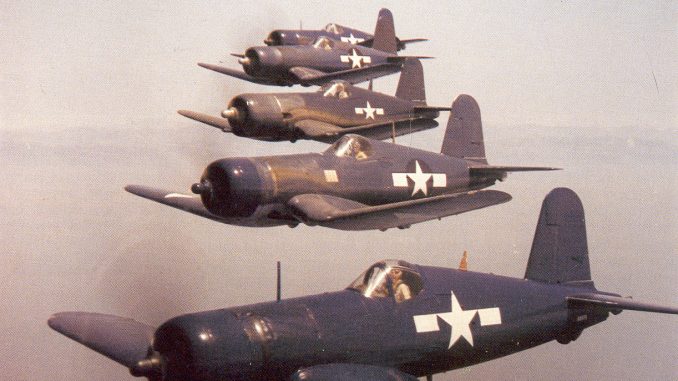
UPDATE
The Baa Baa Black Sheep book is currently in the works, the expected release date is September 21, 2024. If you would like to be notified and get your copy before anyone else, please click HERE
Forty years ago to the day, on September 21st, 1976, the famed TV-series Baa Baa Black Sheep first aired on television in the United States. But FLYING MISFITS, which was the two-hour pilot episode (actually known as Episode 0) premiered on Tuesday, September 21, 1976. The series’ first one-hour episode (Episode 1), BEST THREE OUT OF FIVE, appeared three days later on Thursday, September 23, 1976.
It was a seminal moment for many of us who follow vintage military aviation today, especially if we were kids at the time. Here to tell a little of the story about the making of that show, and the aircraft involved is Stephen Chapis, revisiting an article “Poor Little Lambs” that he originally wrote some years ago (Warbird Digest #49 – July/August 2013 – Click HERE to buy that issue) We at Vintage Aviation News thank him, and all of the other contributors who made this piece possible! **2022 UPDATE** The Baa Baa Black Sheep book is currently in the works, the expected release date is September 21, 2023. If you would like to be notified and get your copy before anyone else, please click HERE
POOR LITTLE LAMBS
by Stephen Chapis
photos (all via Stephen Chapis)
The short-lived TV-series Baa Baa Black Sheep turned many young American boys into life-long fans of the famed Corsair, including the author who was just five years old when the show debuted in September 1976. What follows is not a biography of Pappy Boyington, a history of VMF-214, or a debate about the historical accuracy of the series. It is simply a history of the Corsairs used on the show and a collection of memories from the four surviving Baa Baa Black Sheep pilots: Thomas Friedkin, Steve Hinton, Steve Rosenberg, and the late-Bill Yoak.
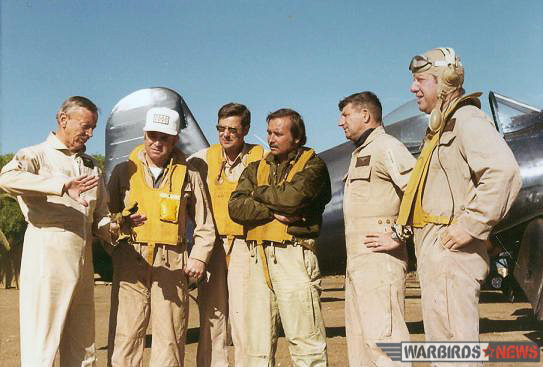
THE REAL STARS
While actors Robert Conrad and John Larroquette may have thought they were the show’s stars, the real stars of Baa Baa Black Sheep (later syndicated as Black Sheep Squadron) were clearly the Corsairs. A total of eight Corsairs, of varied backgrounds, participated in the filming: four FG-1Ds, two F4U-7s, one F4U-1A, and one F4U-4. Five were combat veterans, two have turned hot laps at Reno, and two later became Oshkosh Grand Champions. Since the conclusion of Black Sheep in 1978, one FG-1D and one F4U-7 have been lost. Of the remaining six aircraft, four are actively flying, one is maintained in airworthy condition but not flown, and the last is awaiting restoration to airworthy condition.
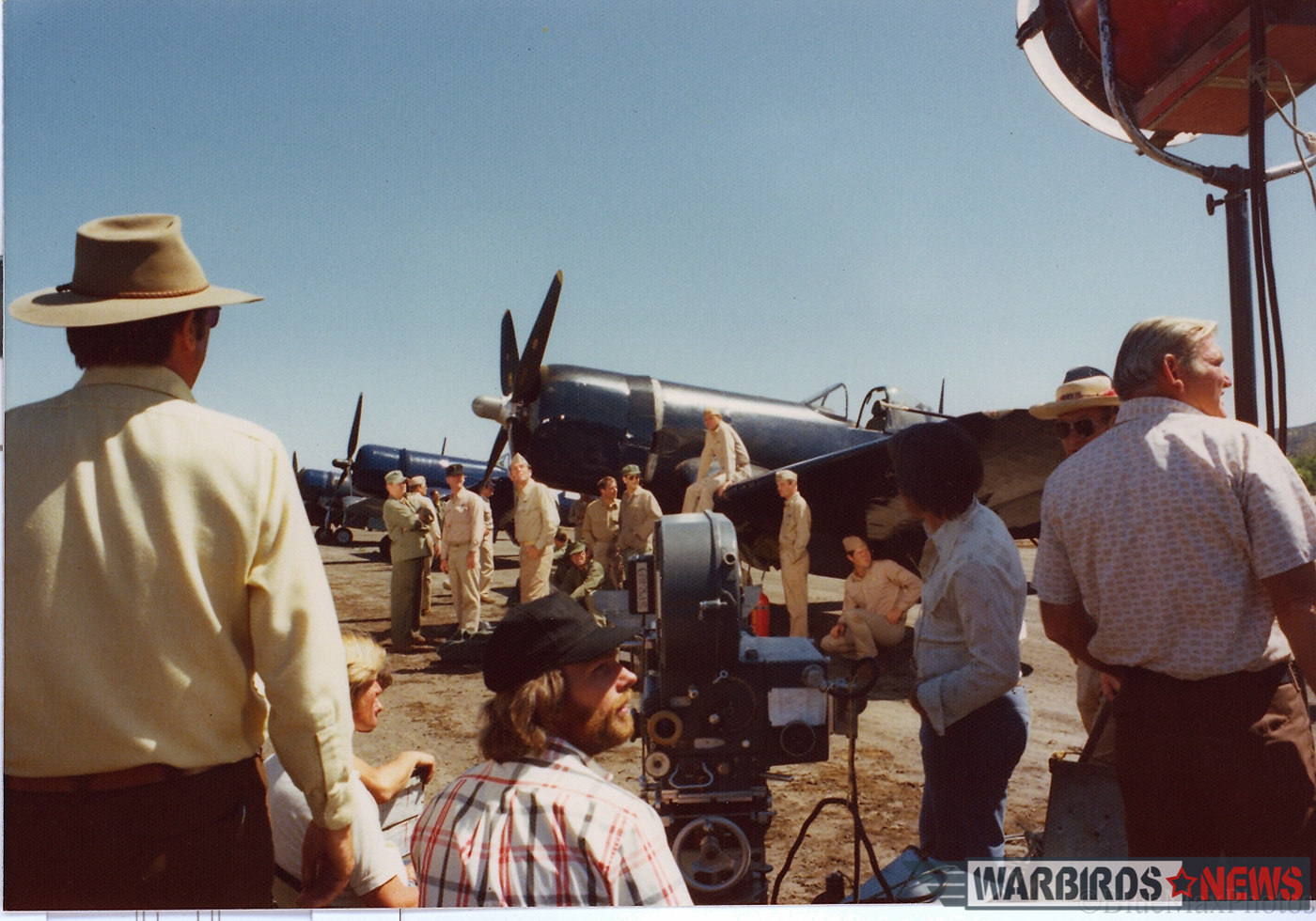
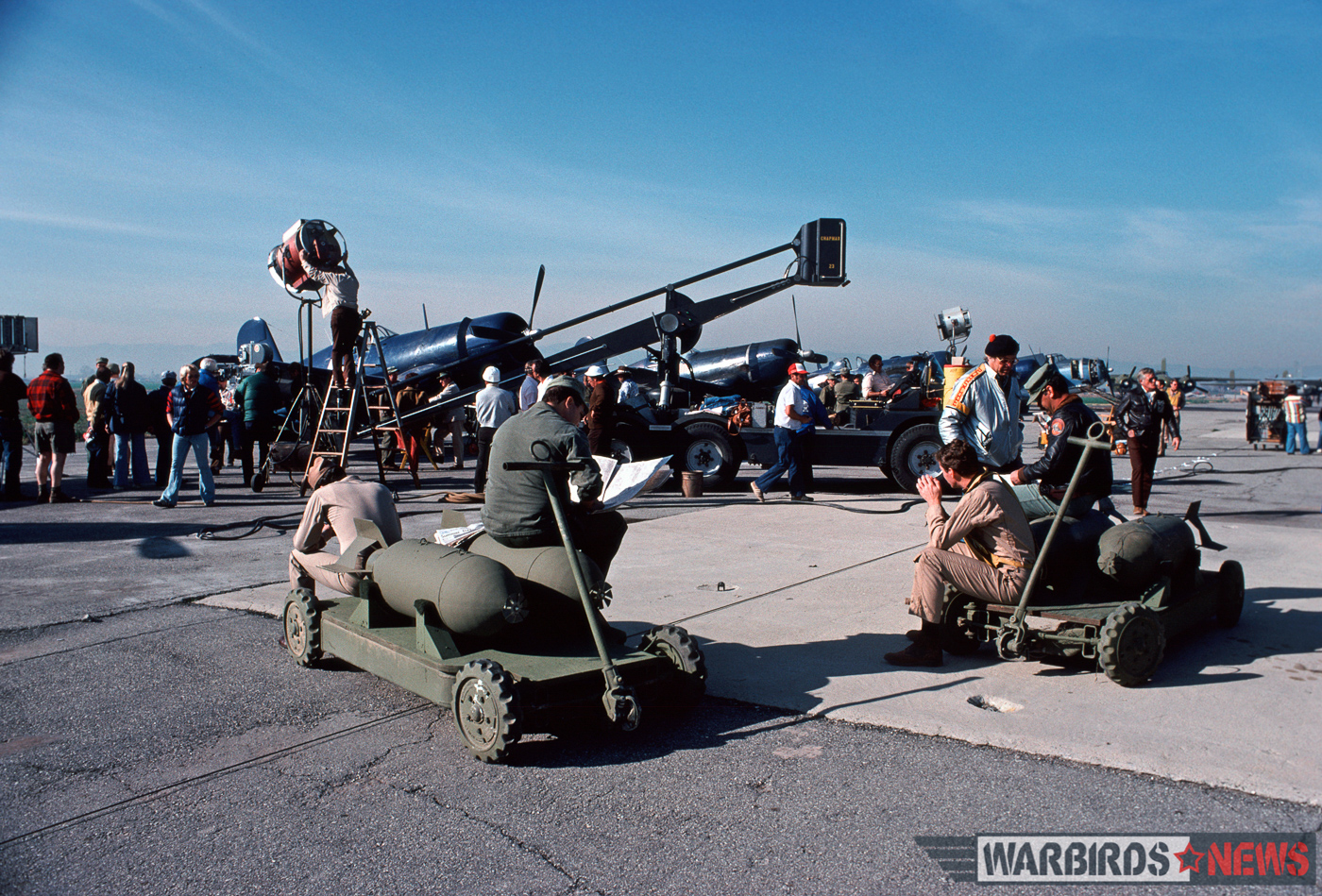
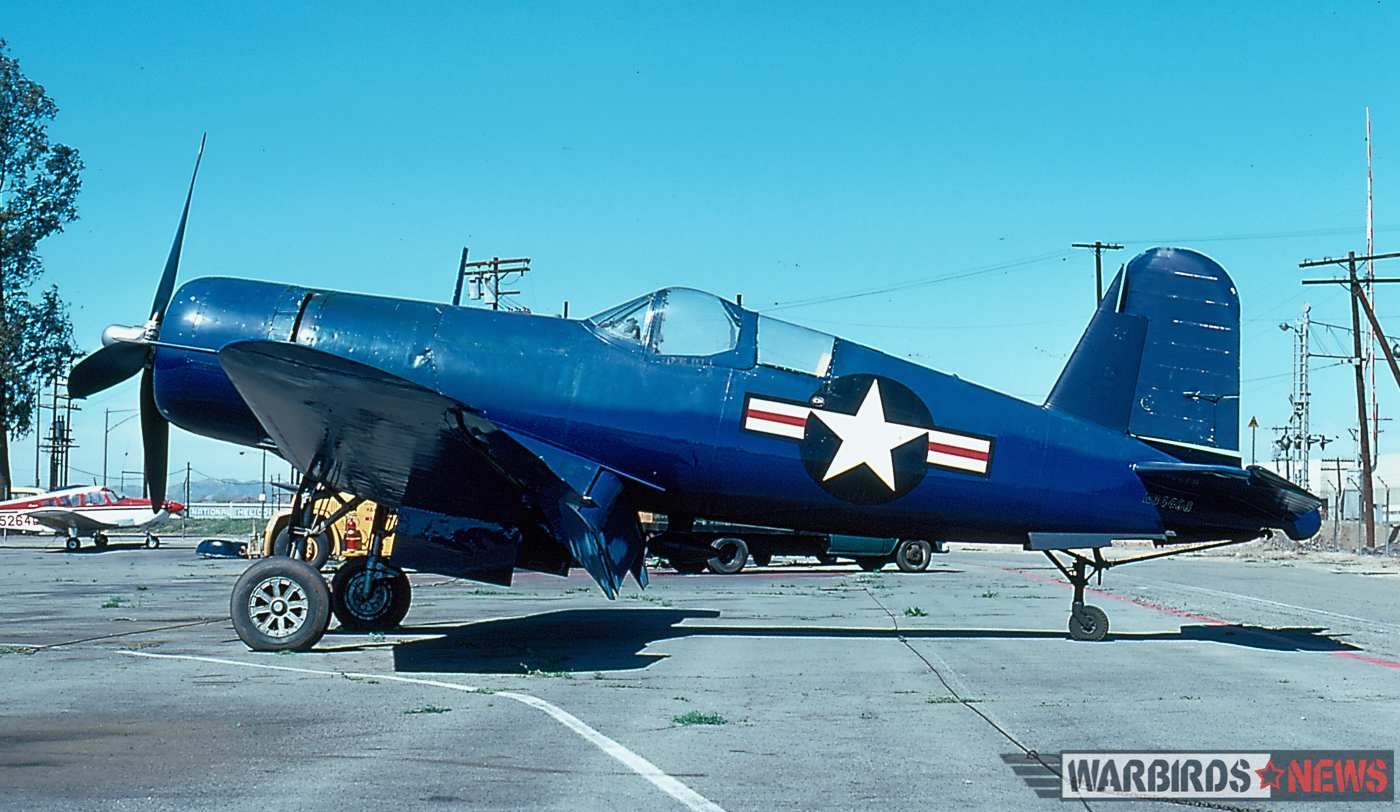
The Navy accepted this FG-1D on July 11th, 1945, and although its record card is nearly impossible to read prior to 1950, the fighter appears to have served as a pool aircraft in San Diego and Jacksonville. From 1950 through 1955, 92433 flew with VF-101 at Naval Air Station (NAS) Oceana, Virginia and Reserve squadrons in Dallas, Minneapolis, and New York. In November, 1955, it moved to the storage facility at NAS Litchfield Park in Arizona. The Navy struck her from their records on January 7th, 1957 after she’d logged 2,307 flying hours.
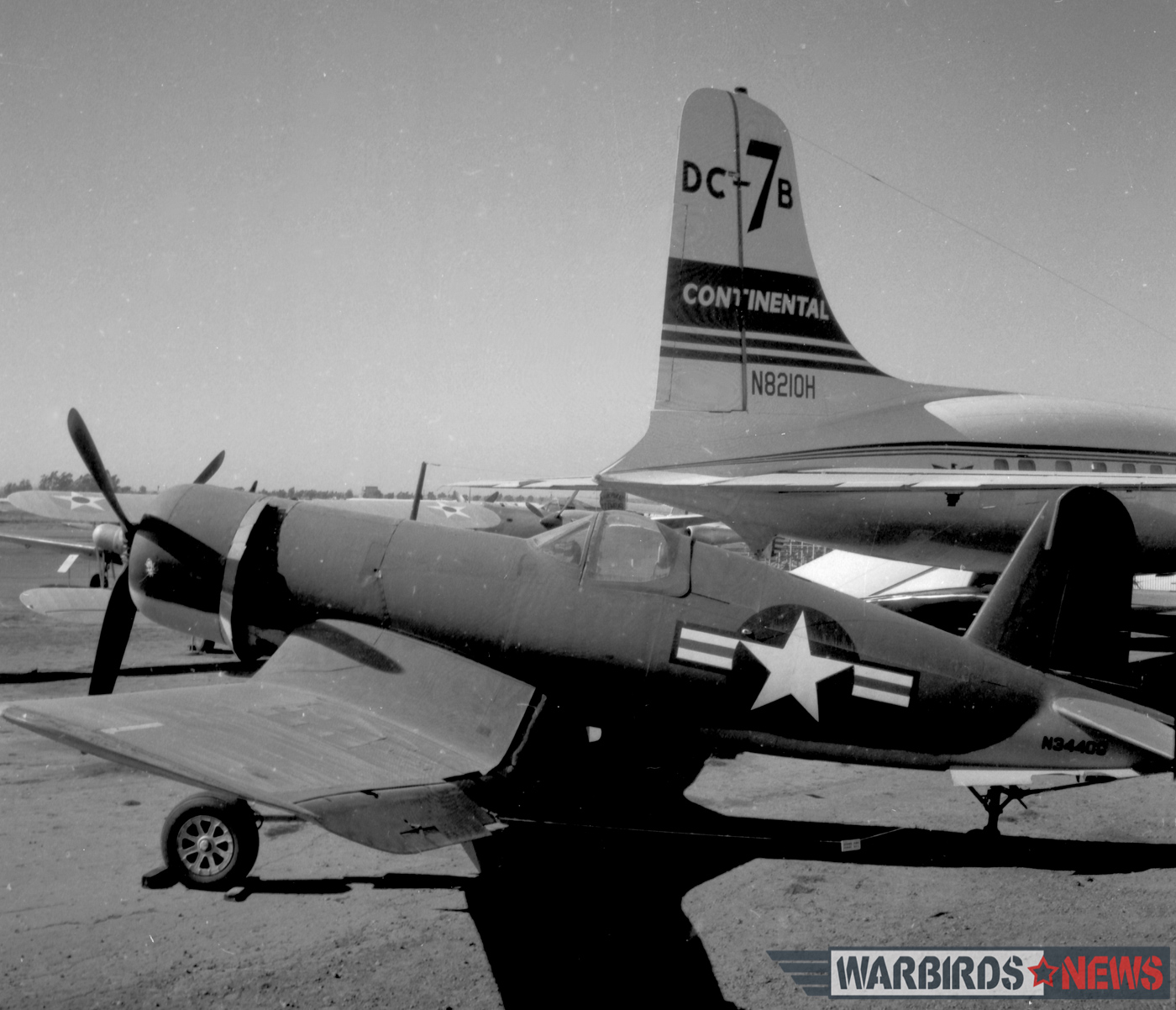
In April 1959, it was one of 40 Corsairs listed on an Invoice/Shipping Document from Alu-Net Smelters of Long Beach, California. Frank Tallman purchased the aircraft from Alu-Net on May 7th, 1959 and returned it to flight in 1962, at which time it had only flown three hours since its military retirement.
On September 16th, 1969 the late Isaac Newton Burchinal (aka Junior) of Paris, Texas bought the Corsair for his Flying Tigers Air Museum where he had it modified with a rudimentary second cockpit and flight controls, covered by a crude Plexiglas canopy.
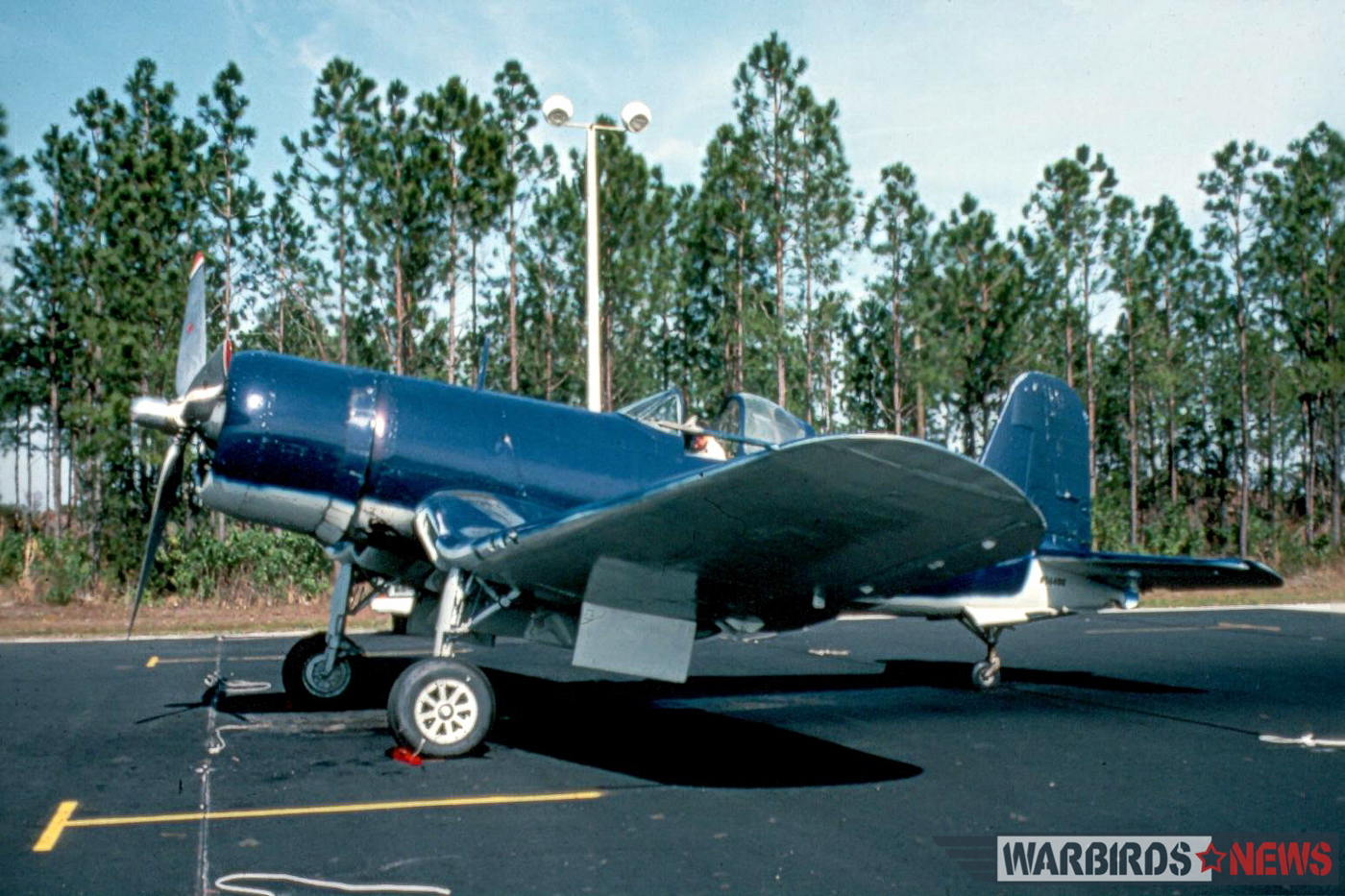
In early 1976, Junior flew ‘433 to California for Black Sheep. This Corsair is easily identifiable on screen by the tinted rear canopy, ADF “football” antenna under the fuselage and extended tailwheel. Sadly, in 1979 a hangar fire consumed this Corsair at Addison Airport in Dallas, Texas.
VOUGHT F4U-7 CORSAIR Bu.No. 133693
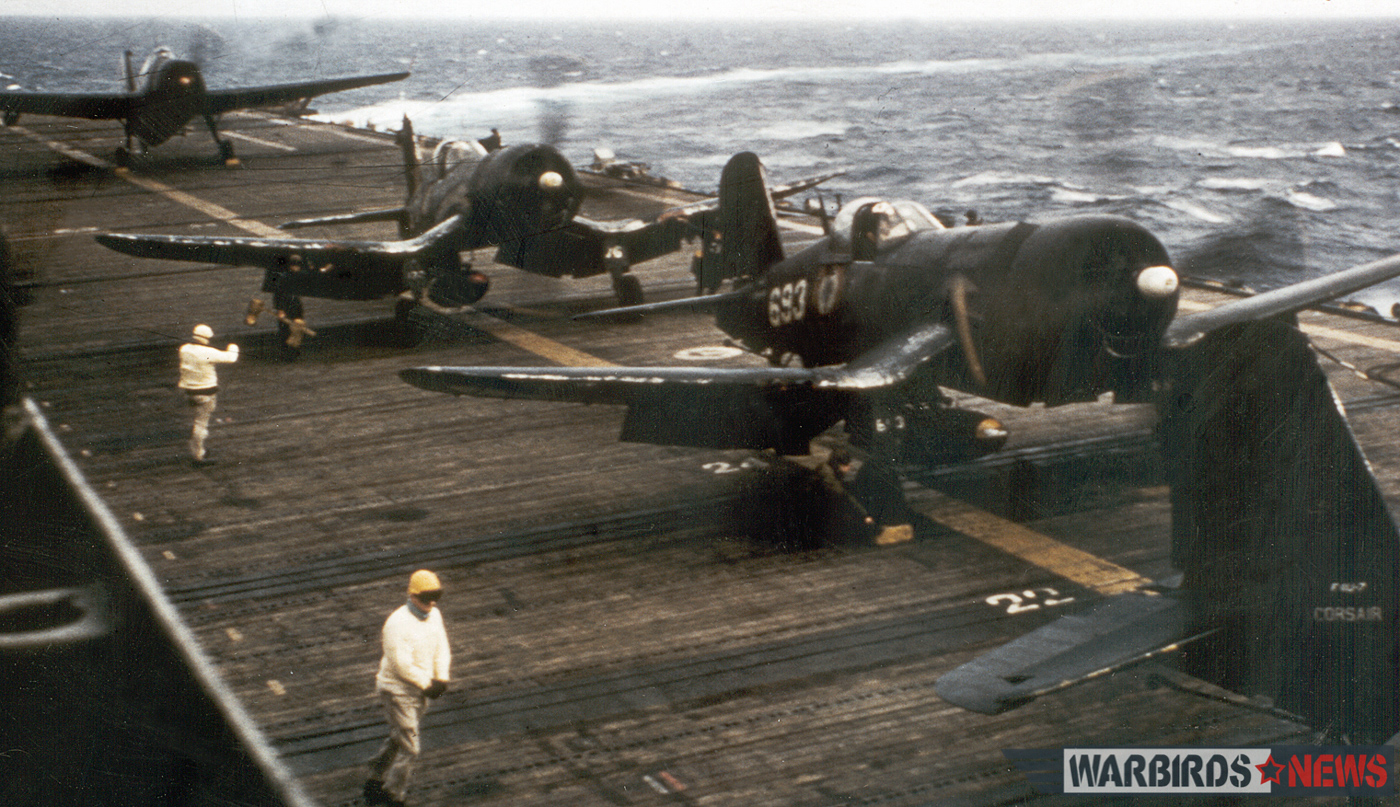
This Corsair was the 41st of 94 F4U-7s that Chance Vought produced at their plant in Grand Prairie, Texas for the French Navy (Aeronavale). Delivered through the Military Assistance Program (MAP), ‘693 arrived at NAS Karouba, Tunisia in the spring of 1953, where it served with Flotille 12F and later Flotille 15F. There is circumstantial evidence that she was aboard CVL La Fayette during France’s final combat missions in Indochina during 1956. In October 1956, ‘693 was again aboard La Fayette in the eastern Mediterranean Sea during Operation Musketeer (Suez Crisis) where it participated in an attack on Egyptian airfields near Cairo on November 3rd, 1953. Later in its career, ‘693 joined Flotille 14F, where it may have seen action in Algeria. Her final assignment saw her flying as a target tug with Escadrille 10S.
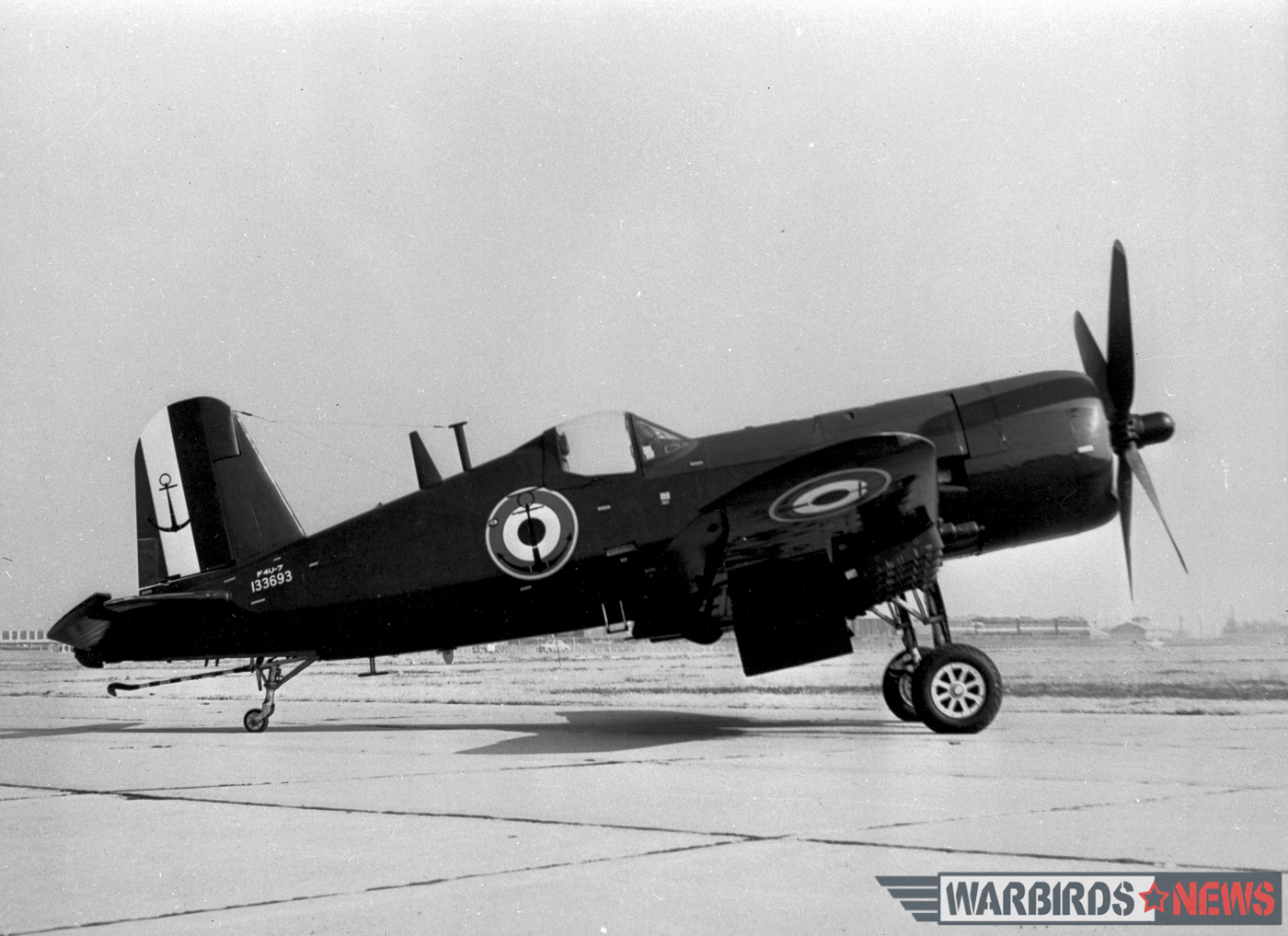
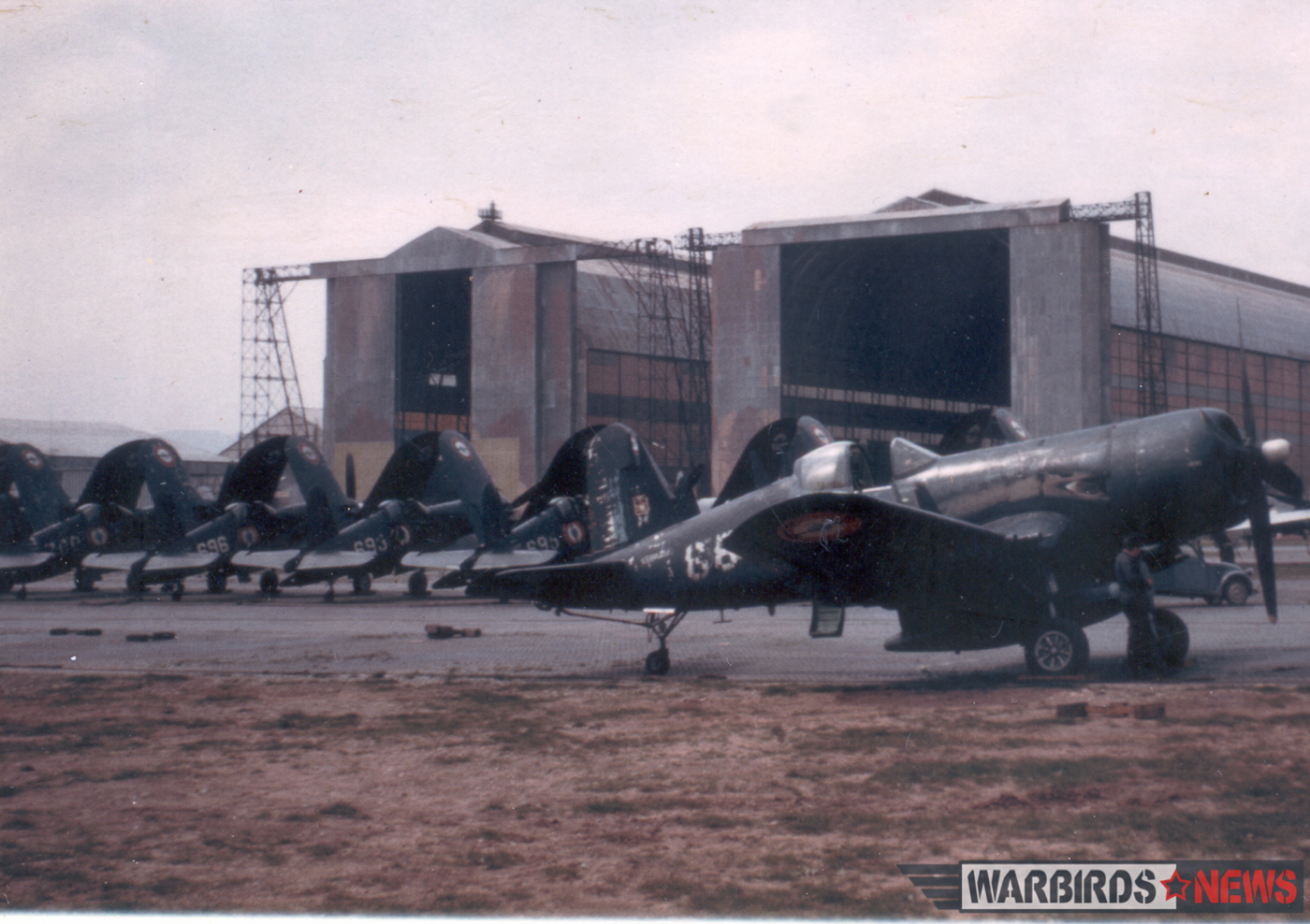
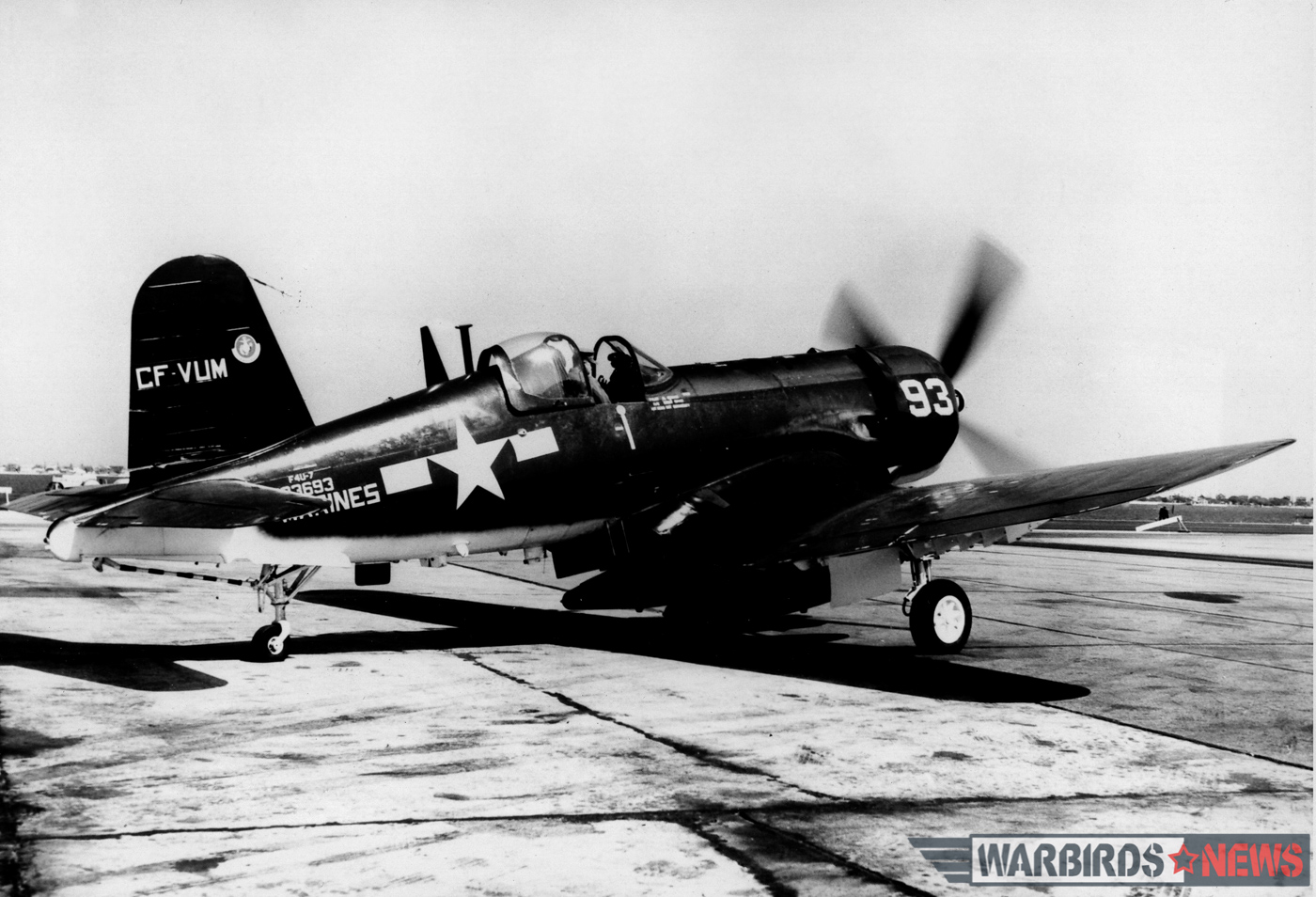
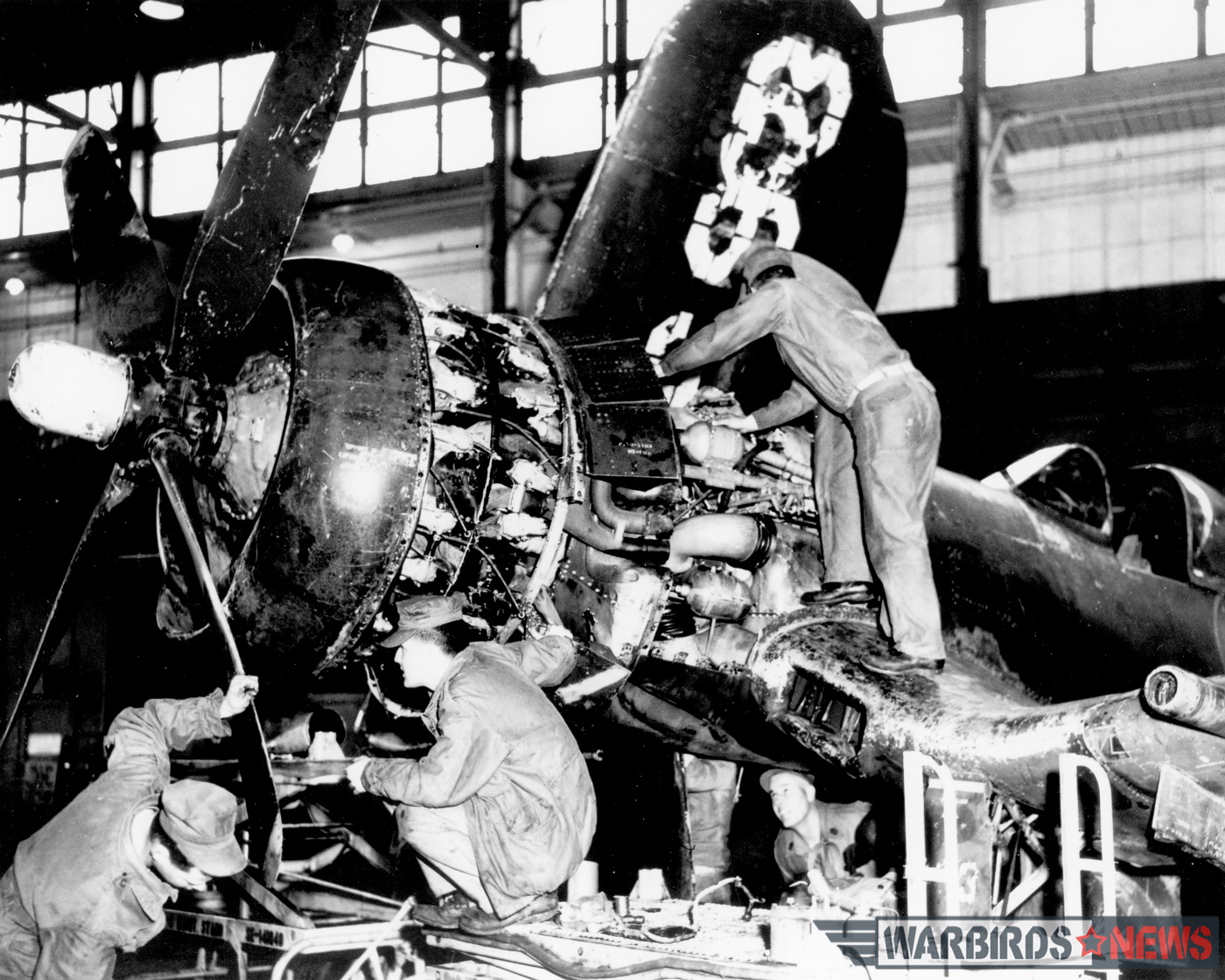
The Corsair returned to the United States in early 1967 for refurbishment at NAS Norfolk, Virginia. The French Navy had just received their brand new F8U Crusaders, and retired their venerable Corsair fleet. After a short stint with the Air Museum of Canada, Bob Guilford purchased the -7 in April 1970. He named her Blue Max and raced the fighter for the next 17 years. In 1976, Blue Max’s bold markings were covered in overall dark blue in preparation for her roll in Black Sheep with Steve Rosenberg at the controls. On August 19th, having flown just three sorties for the cameras, Blue Max suffered a catastrophic engine failure which ended her Black Sheep career.
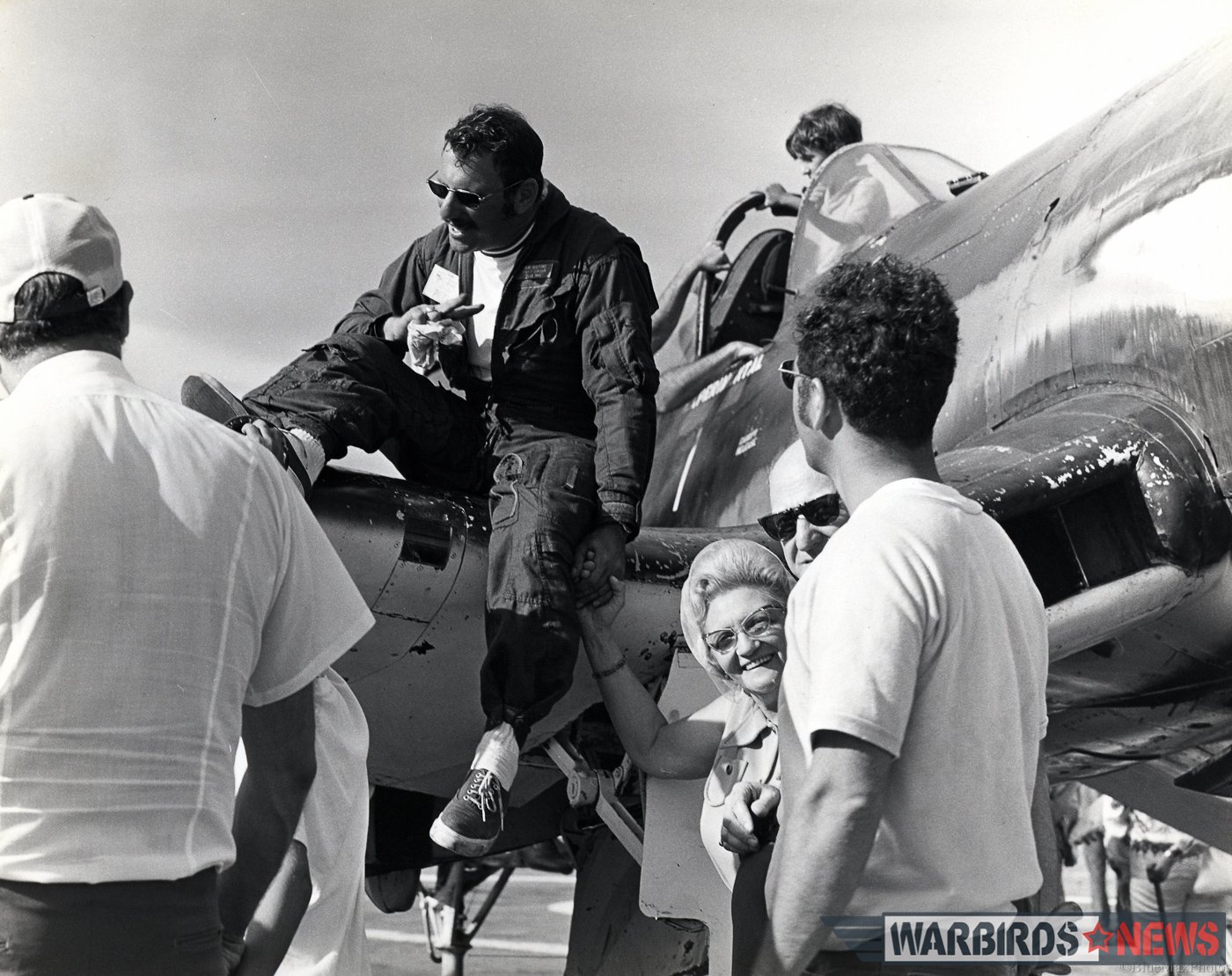
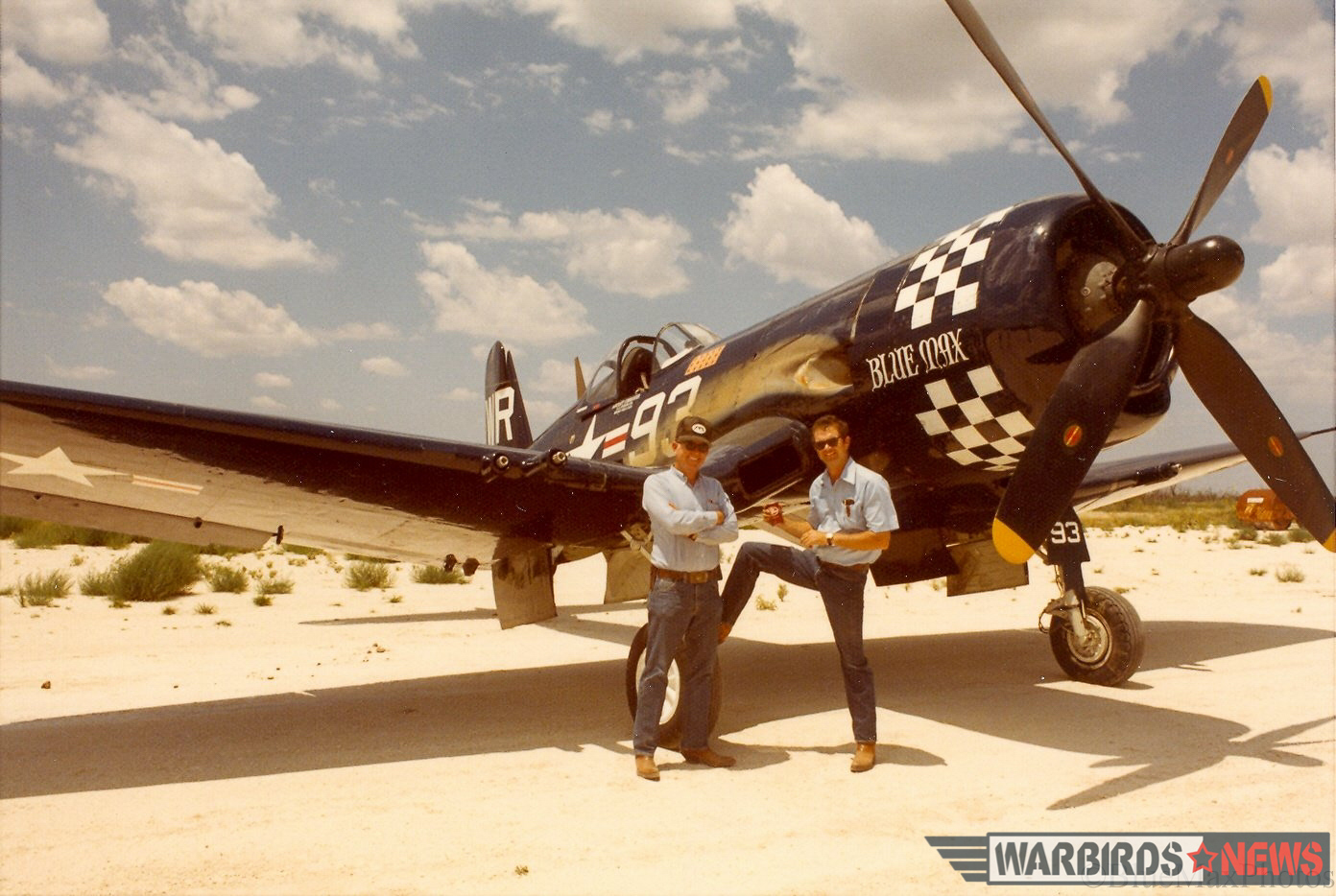
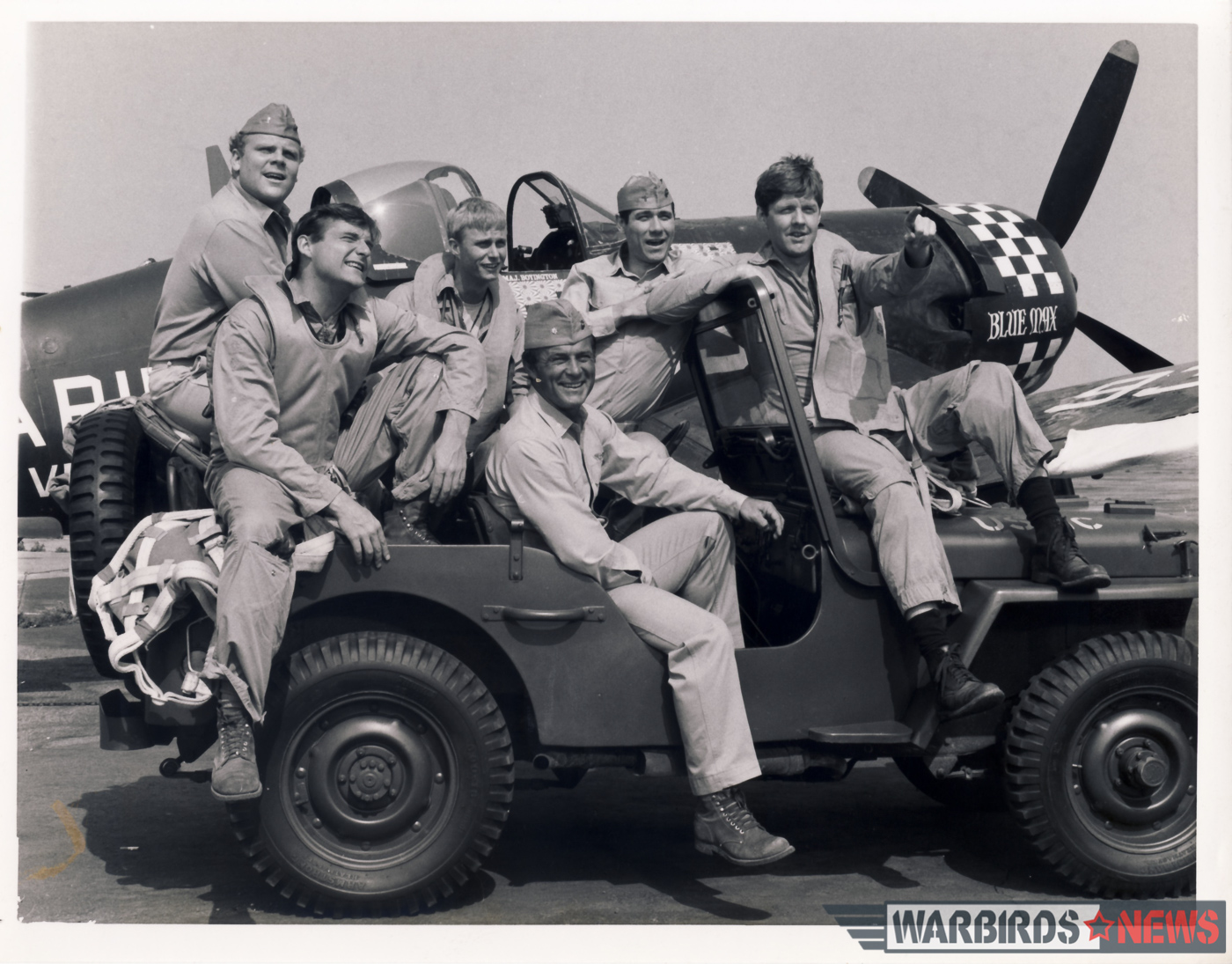
On May 10th, 1987, Marshall Moss took a well-deserving female air show volunteer for a ride in Blue Max near San Diego, California. While performing low-level aerobatics, the Corsair crashed in an inverted attitude, tragically killing Moss and his passenger.
STATIC & UNDER RESTORATION:
GOODYEAR FG-1D CORSAIR Bu.No. 92132
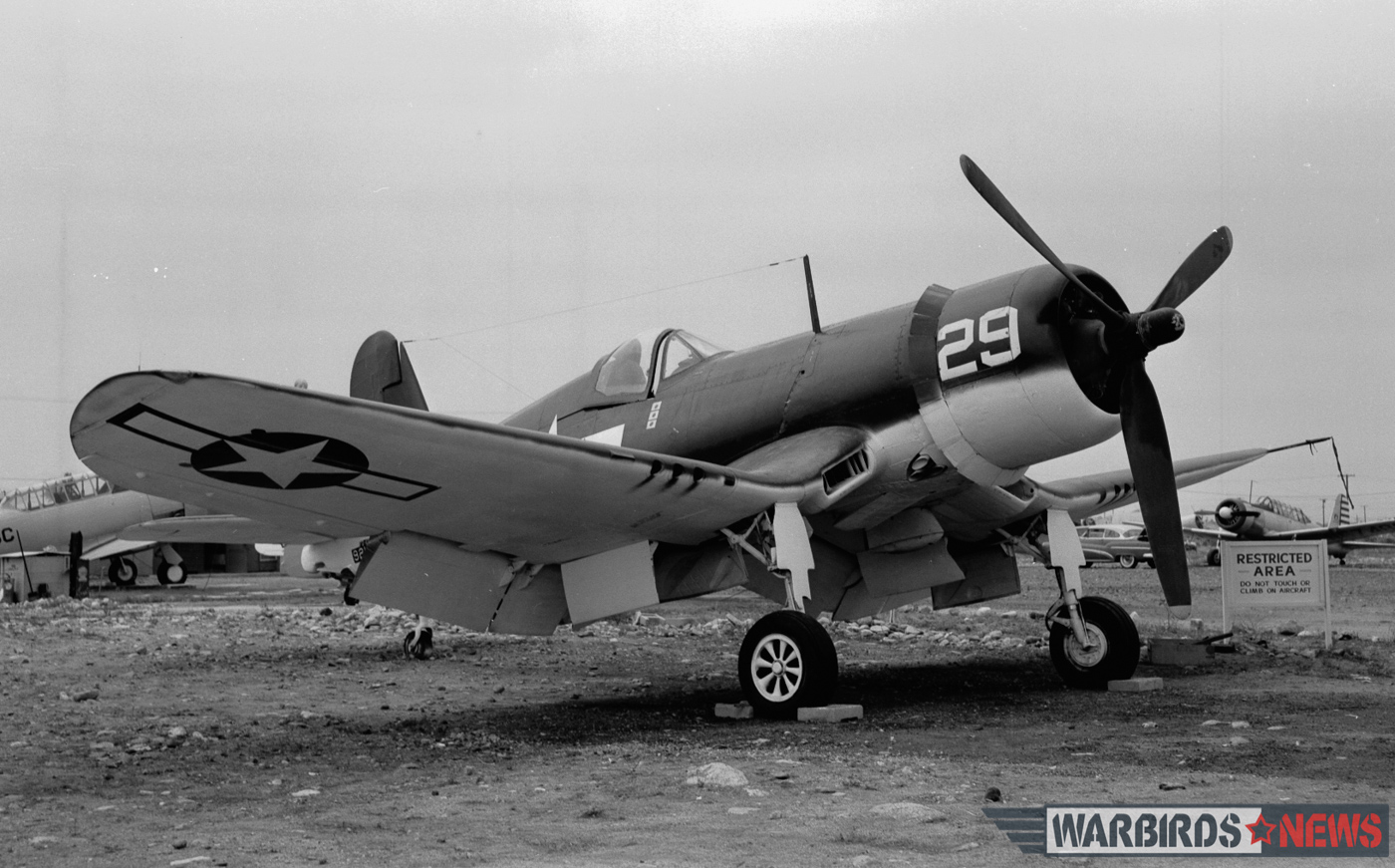
The naval record card for this Corsair is sadly another which is impossible to read for dates prior to 1950. The U.S. Navy took delivery of ‘132 on May 26th, 1945. She spent most of her career with Reserve units in Jacksonville, Florida and Columbus, Ohio. The Corsair flew to Litchfield Park in December 1954, and the Navy struck her from their records on January 7th, 1957 with 1,533 flying hours logged.
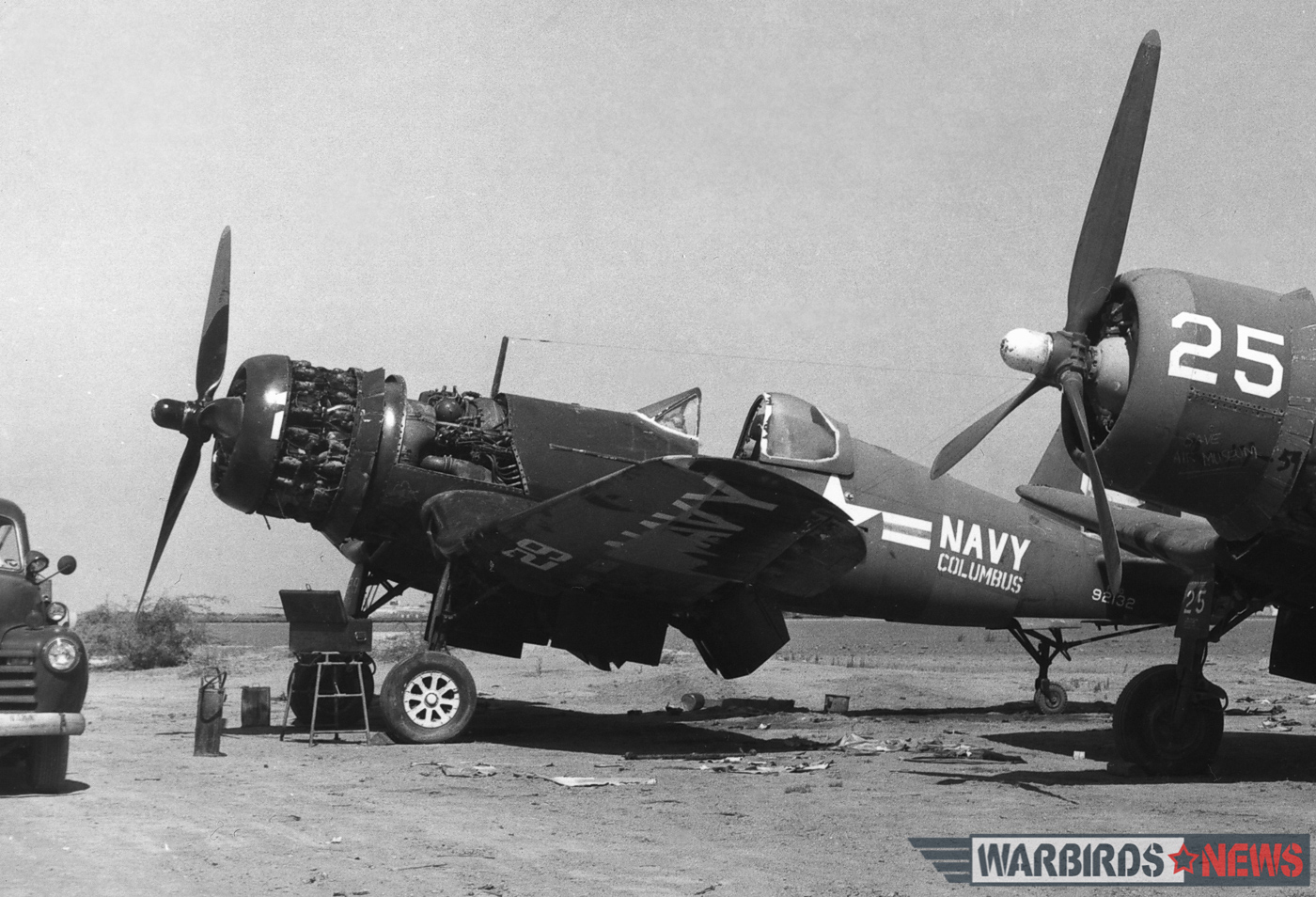
On October 20th, 1959, Alu-Net Smelters purchased the aircraft for $485.67. Planes of Fame founder, Ed Maloney, saved her from destruction though, and placed the venerable fighter in storage. The late David Tallichet’s Military Aircraft Restoration Corp (MARC) purchased the Corsair on June 17th, 1971 and brought it up to airworthy status in April 1975. When she began flying on Black Sheep, 92132 had only flown 16 hours since the Navy retired her 19 years earlier. The airframe flew an additional 30+ hours during filming. She remained in the MARC collection until Henry ‘Butch’ Schroeder and the Midwest Aviation Museum in Danville, Illinois acquired her on February 3rd, 1994.
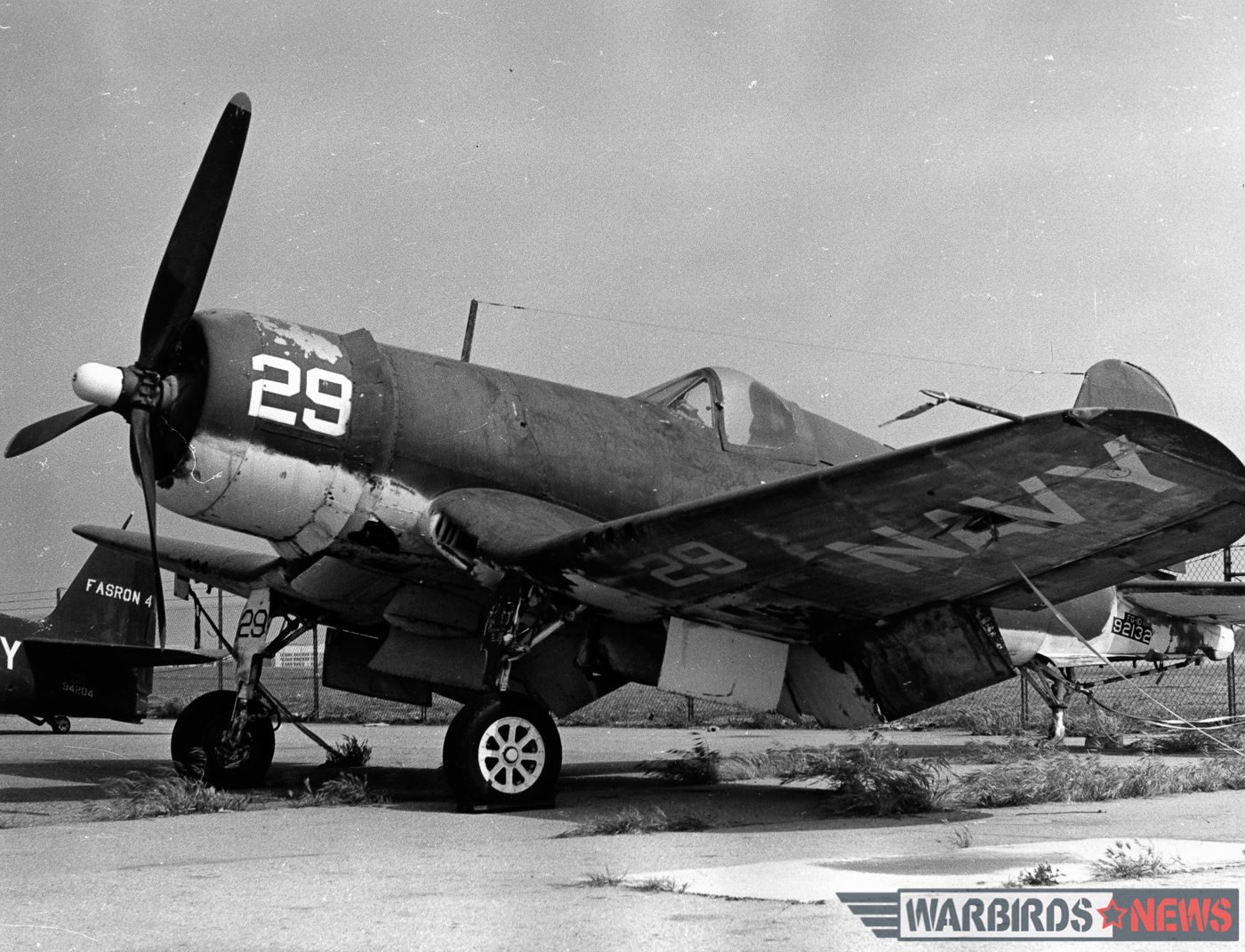
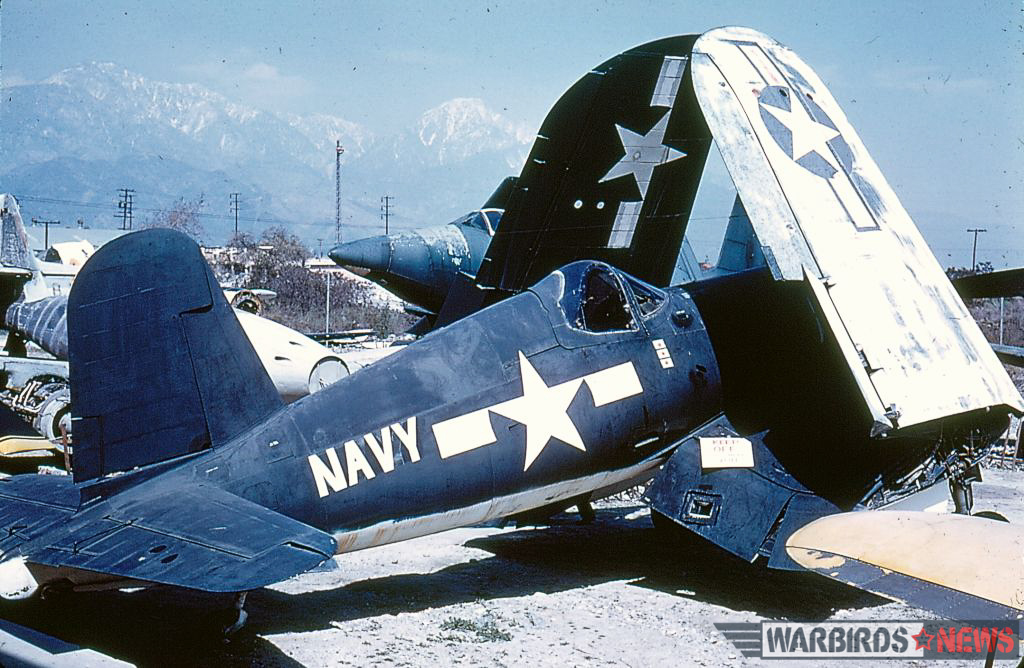
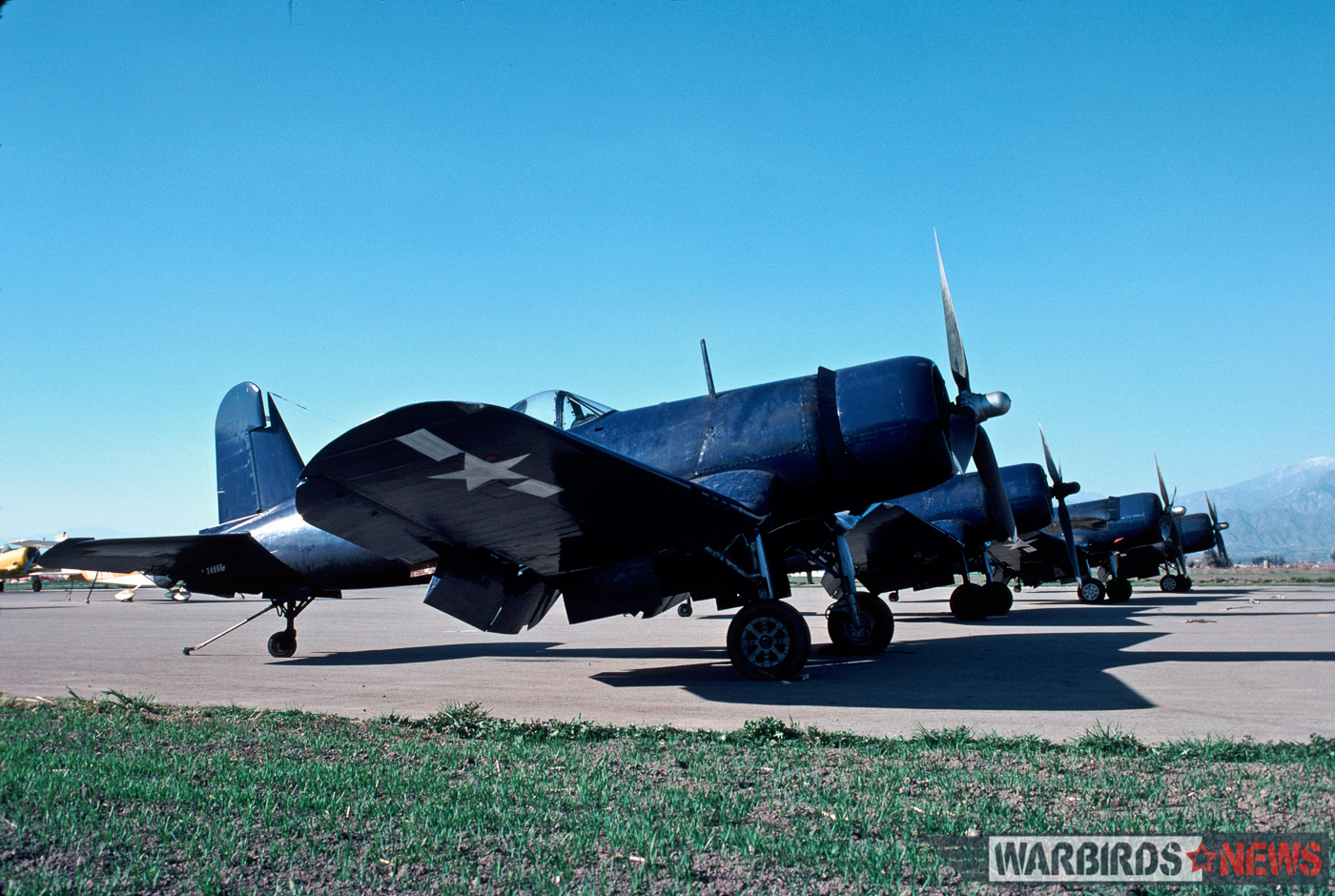
FG-1D Bu.92132 at Chino in her movie paint, with other Corsairs from Black Sheep in February, 1977. (photo by Frank Mormillo)
Schroeder changed his plans for the Corsair and sold her on to the Tri-State Warbird Museum in Cincinnati, Ohio on April 1st, 2003, where she is undergoing restoration. When complete, the Corsair will wear the historically correct markings of her former Columbus Naval Reserve unit.
GOODYEAR FG-1D CORSAIR Bu.No. 92629
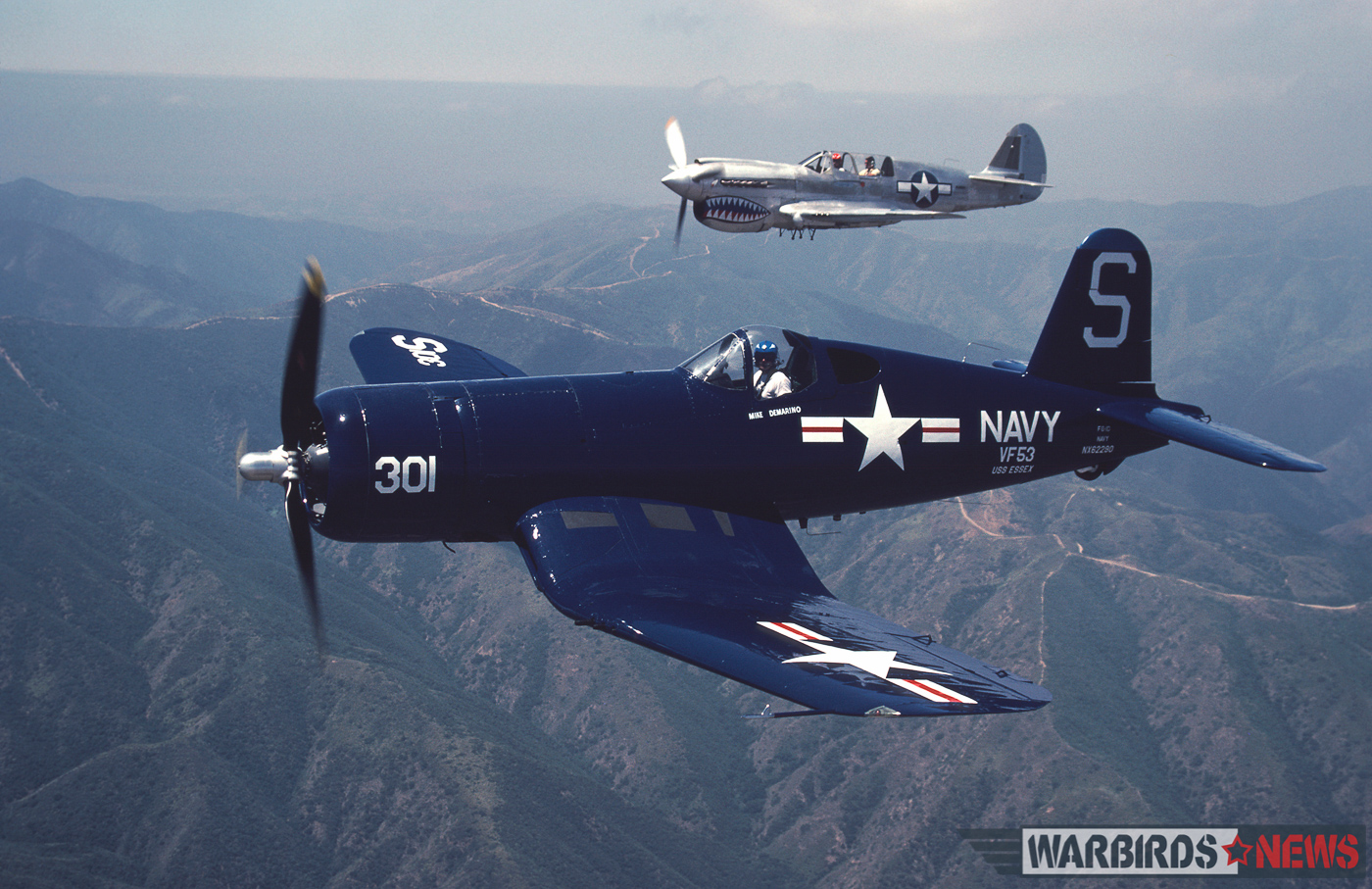
This Corsair was in the last batch of 2,302 FG-1Ds to roll off the Goodyear production line in Akron, Ohio. After acceptance on August 18th, 1945, the Corsair joined the aircraft pool at NAS Alameda, California. Following two years of storage in Georgia, the fighter spent six years in Naval Reserve units in Norfolk, Seattle, Alameda, Columbus, and New York as well as VF-713 at NAS Moffett Field, California. Flown to Litchfield Park in June 1955, ‘629 was stricken in January 1957 with a mere 778 hours flight time.
In late 1957 ‘629 was one of 20 FG-1Ds pulled from storage and sold to El Salvador, where she saw action against Honduras in July, 1969 during the 100 Hours War (sometimes referred to as the Soccer War). Dr Bill Harrison brought the fighter home to the United States in October 1974. John Stokes purchased the fighter on February 8th, 1975. A year later its colorful VF-84 markings disappeared under a new coat of navy blue for her role on Black Sheep. This aircraft is also easily identifiable on screen, as it has a white arrow on the right upper wing and light blue undersides.
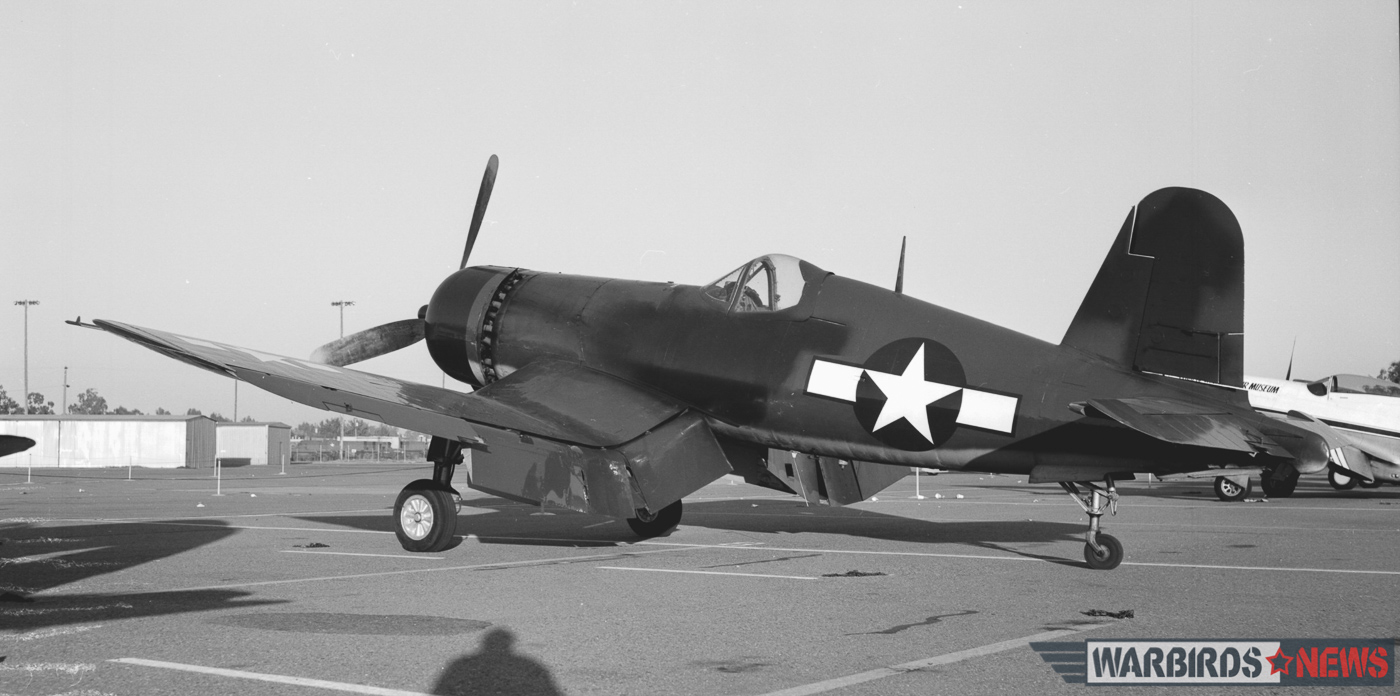
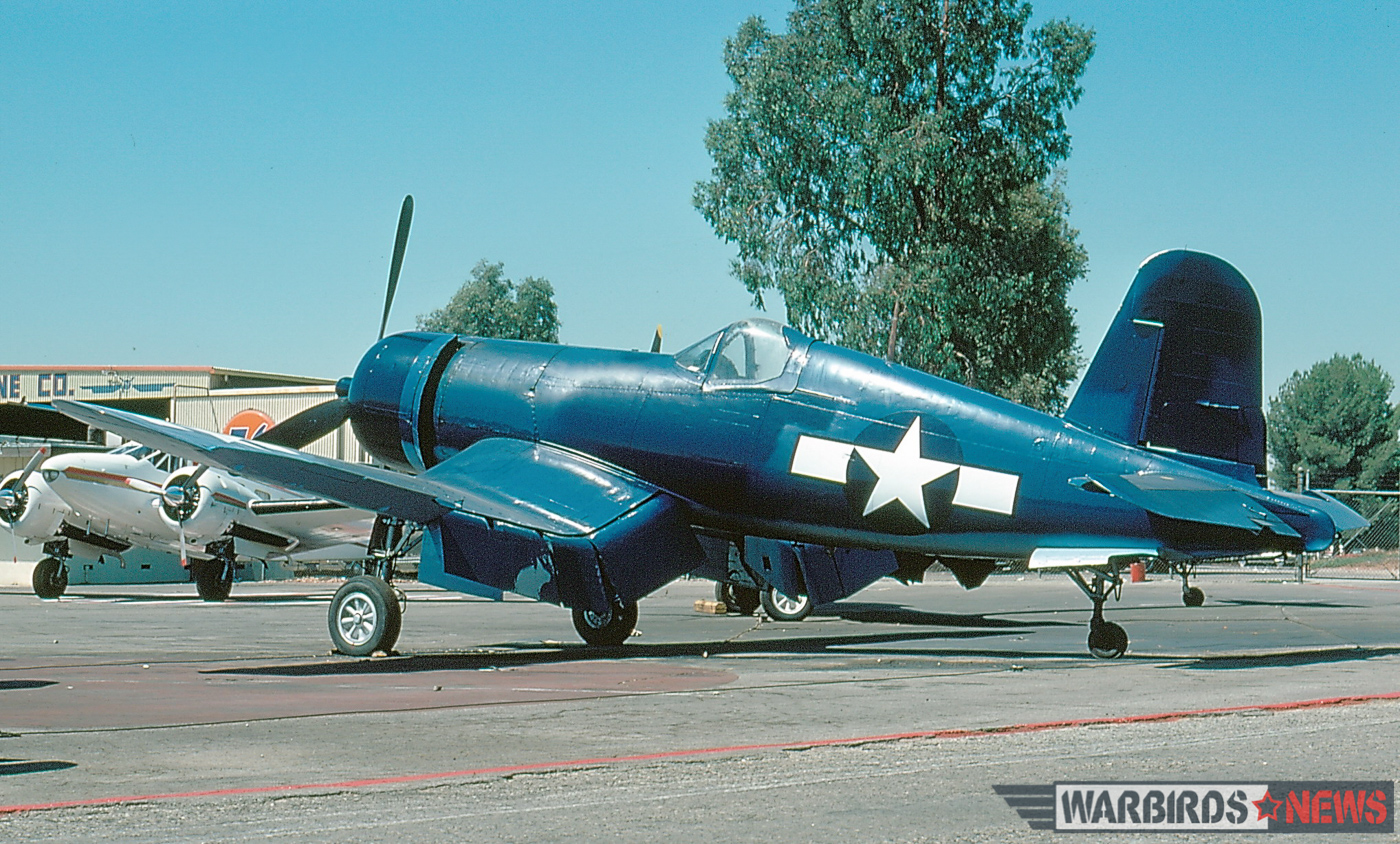
In July 1983, the aircraft suffered extensive damage in an off-airport landing following engine failure on take-off. A recovery crew loaded the wreckage onto a truck for the journey to “Fighter Rebuilders” in Chino, California. Steve Hinton’s team had the fighter airworthy again a year later. Today, this warhorse is on display at the Palm Springs Air Museum in Palm Springs, California. It is maintained in airworthy condition, but has not flown since 2006.
THE FLYERS:
VOUGHT F4U-1A CORSAIR Bu.No. 17799
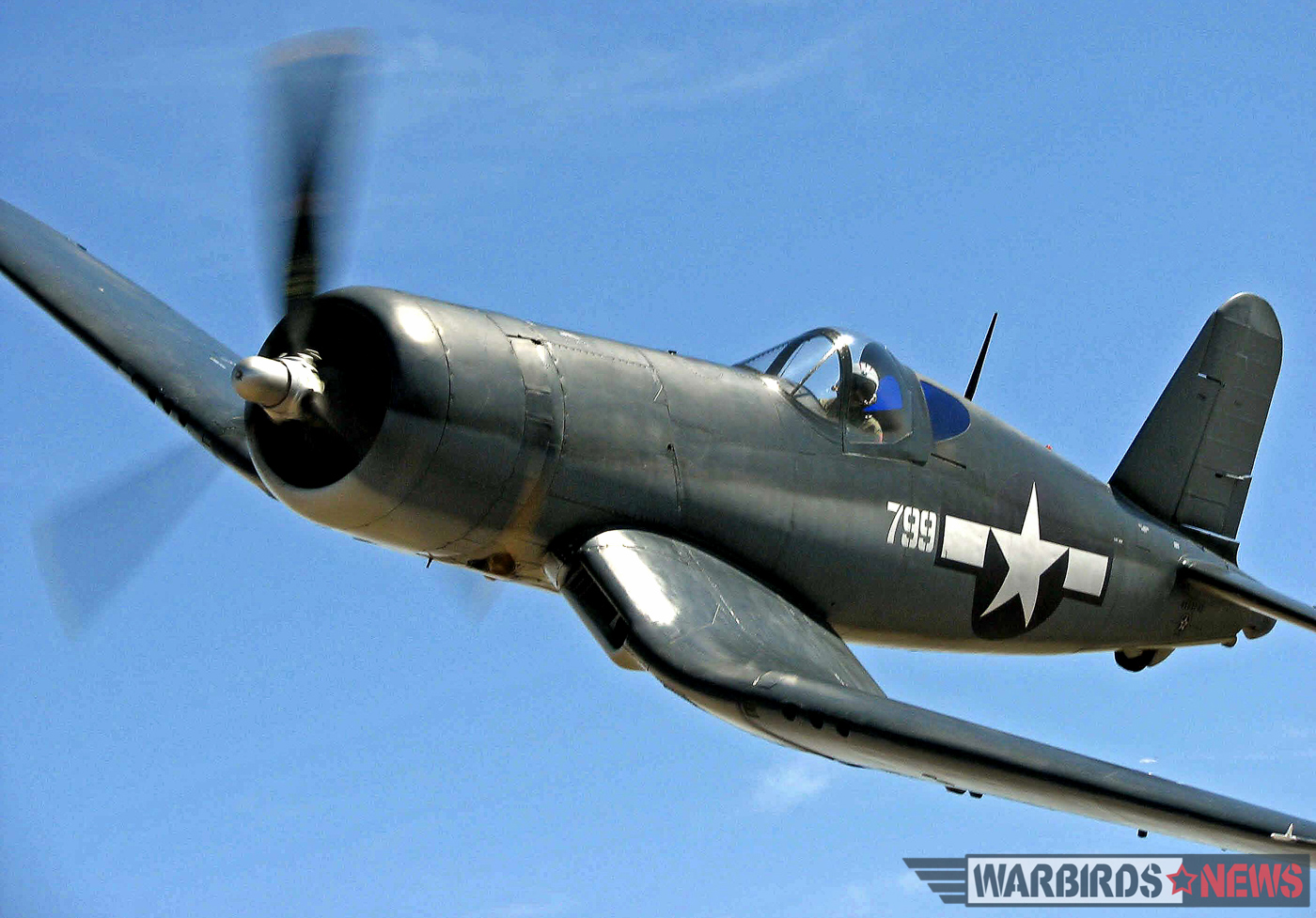
Due to its long association with the Planes of Fame (POF) Museum in Chino, California, this F4U-1A is arguably the most well known of all the Black Sheep Corsairs. She rolled off the Vought production line in Stratford, Connecticut on August 31st, 1943, making her one of the oldest surviving Corsairs in the world, and the oldest currently flying. During her short military career, ‘799 served with VF-84, VBF-14, VBF-98 & VBF-84. The Navy struck her from their records on August 31st, 1944 with an unknown numbers of flying hours.
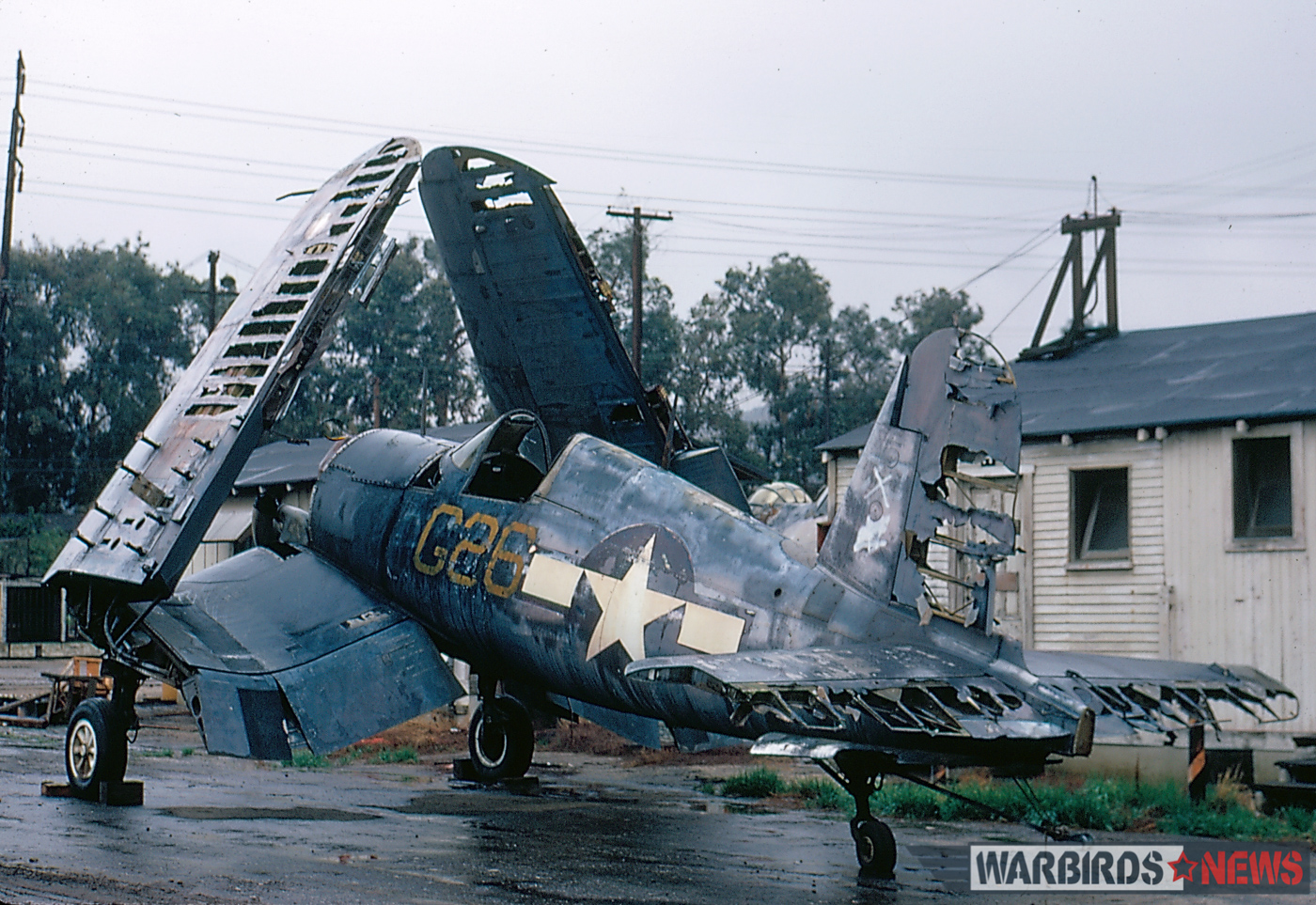
In 1946, MGM Studios purchased the Corsair as a movie prop. She slowly deteriorated into disrepair until Ed Maloney saved her from almost certain scrapping, and placed the fighter in storage during 1970. In 1974, the original ‘Chino Kids’ Steve Hinton and Jim Maloney began gathering parts to bring the Corsair back to flying condition. In the fall of 1977, 31 years after she ‘officially’ retired, ‘799 joined the merry band of planes and pilots on the Black Sheep set at Indian Dunes Airport near Valencia, California. During filming the aircraft wore an overall dark blue scheme with star-and-bar insignia and no special markings. In the early 2000’s John Maloney performed a mild restoration on ‘799 and applied the beautiful tri-color paint scheme it wears today. This pristine example of an early Corsair is a regular flier at POF airshows and special events.
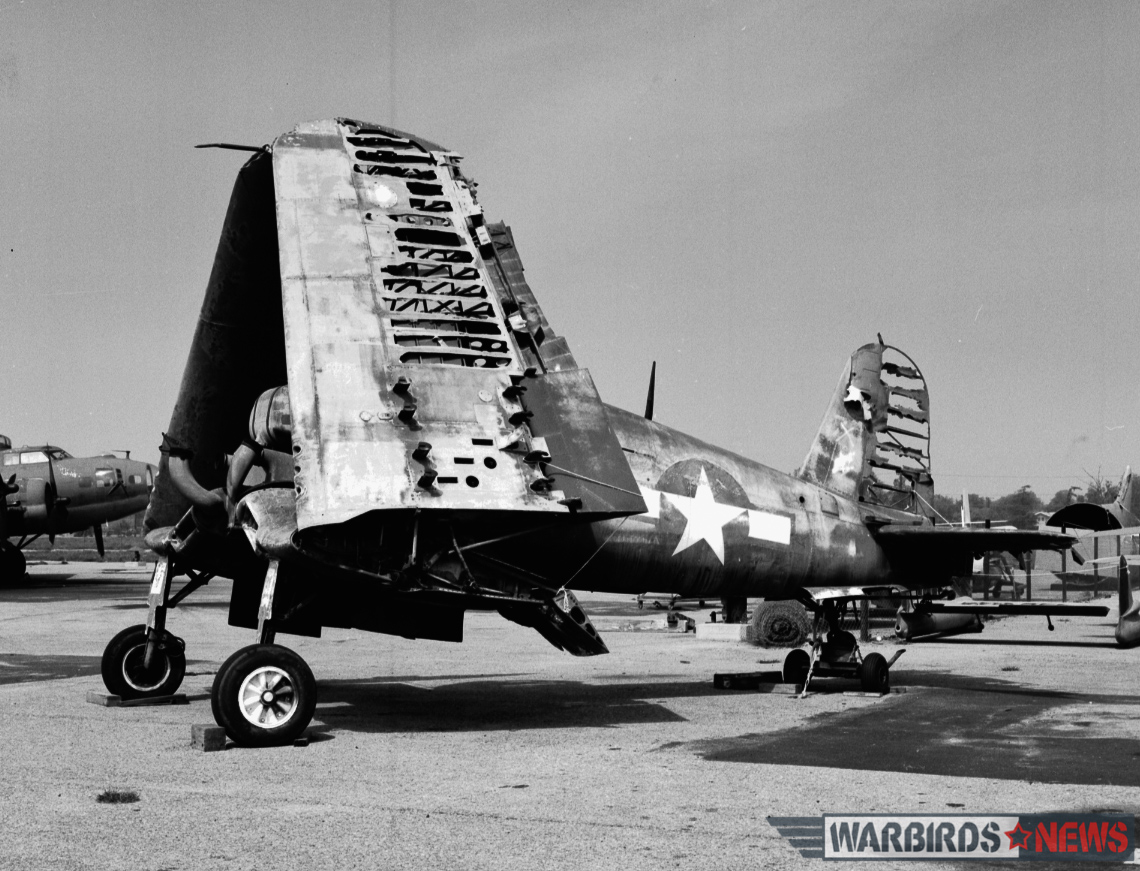
For quite some time, POF officials, particularly volunteer historian Cory O’Bryan, suspected that their Corsair had seen combat with the famous VF-17 Jolly Rogers in 1943, but they could never find evidence to substantiate their beliefs. That all changed in early 2016 thanks to children’s author Michele Spry who had a chance meeting with a 94-year-old, WWII US Marine Corps veteran named Ferrill A. Purdy who had flown Corsairs in combat with VMF-441 Blackjacks. Michele interviewed Purdy for her second book, which involved an Honor Flight veteran traveling to Washington, D.C. with a youngster. While studying his logbook, she compared it to Corsairs that had survived to the present day. She found one … Bu.No.17799!
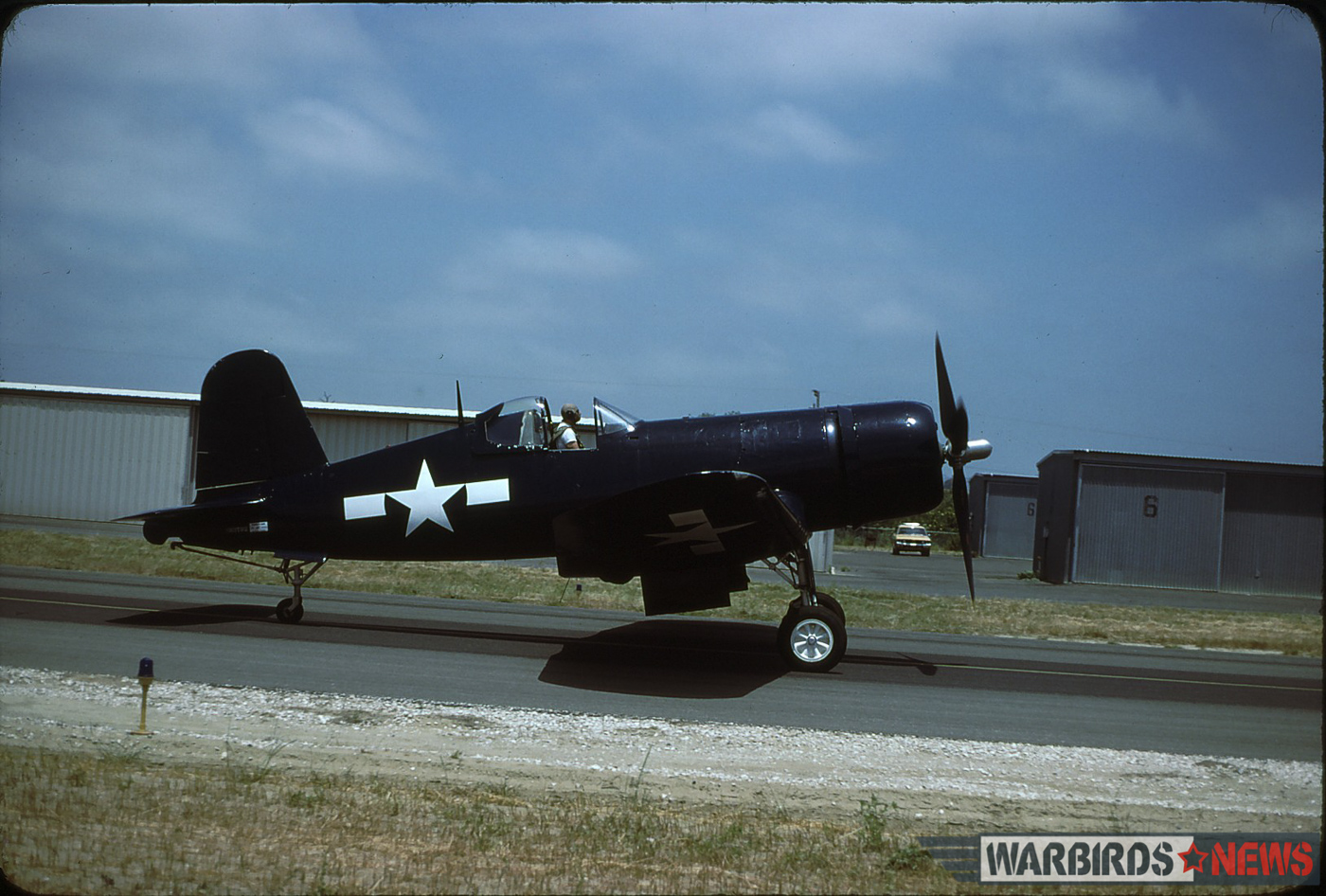
This discovery led Michele to another Blackjack veteran, John H. Tashjian, who traveled to Chino in August 2016 for a Living History Event where he reunited with “his” old Corsair. Although POF continues to fill in the blanks in the wartime career of 17799, they can now proudly claim that their Corsair is a bonafide combat veteran.
GOODYEAR FG-1D CORSAIR Bu.No. 92106
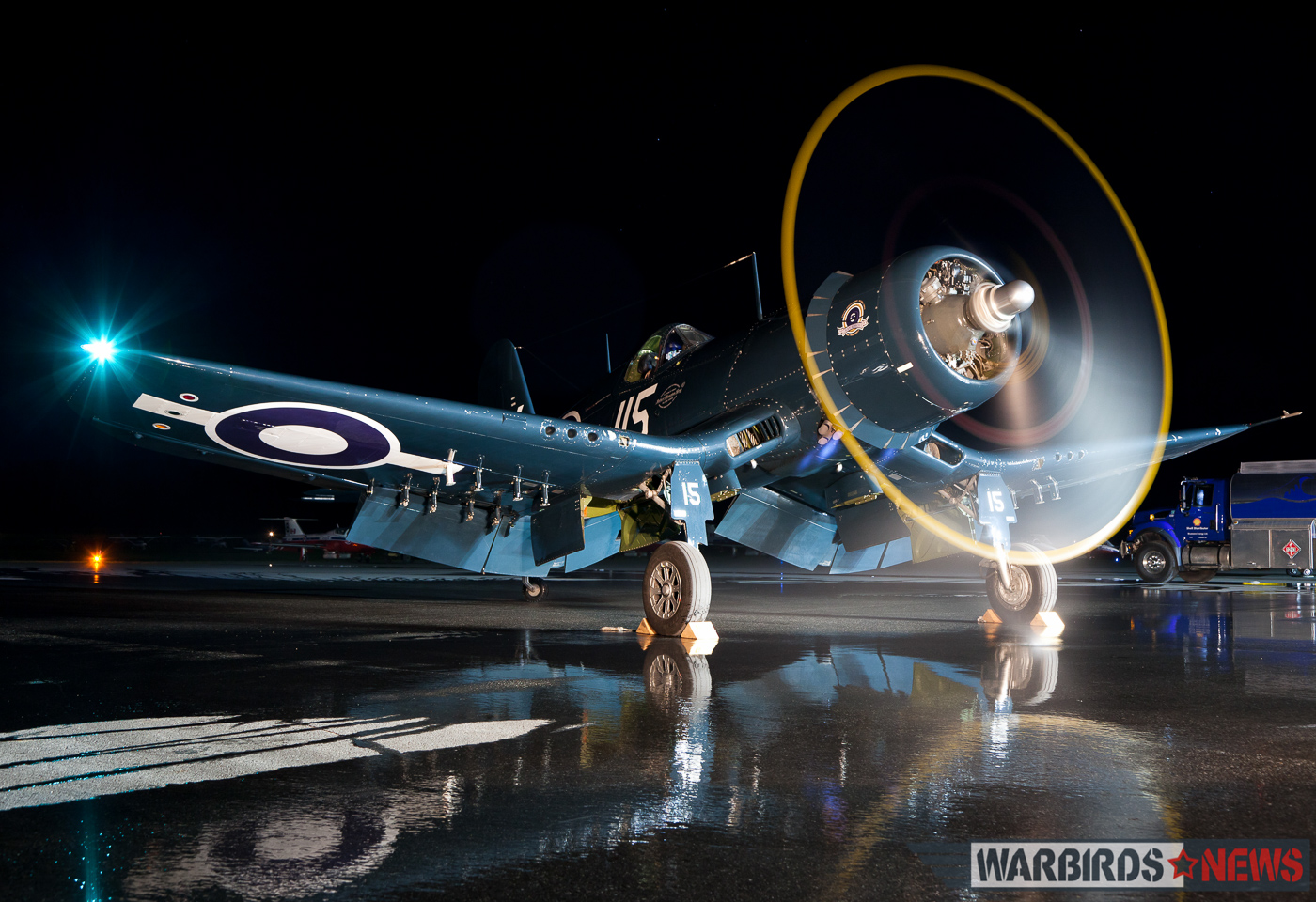
Bu.92106 joined the Navy on May 17th, 1945. This Corsair was amongst the last sent to the Pacific Theater of Operations, but it never saw combat and returned to the States in early 1946. During its eight-year Navy career, 92106 was a pool aircraft in Norfolk and Jacksonville and also flew with the Naval Reserves in New Orleans, Seattle, Grosse Ile, Dallas, and Spokane. The Navy struck her on September 9th, 1954 with 1,437 hours on the clock.
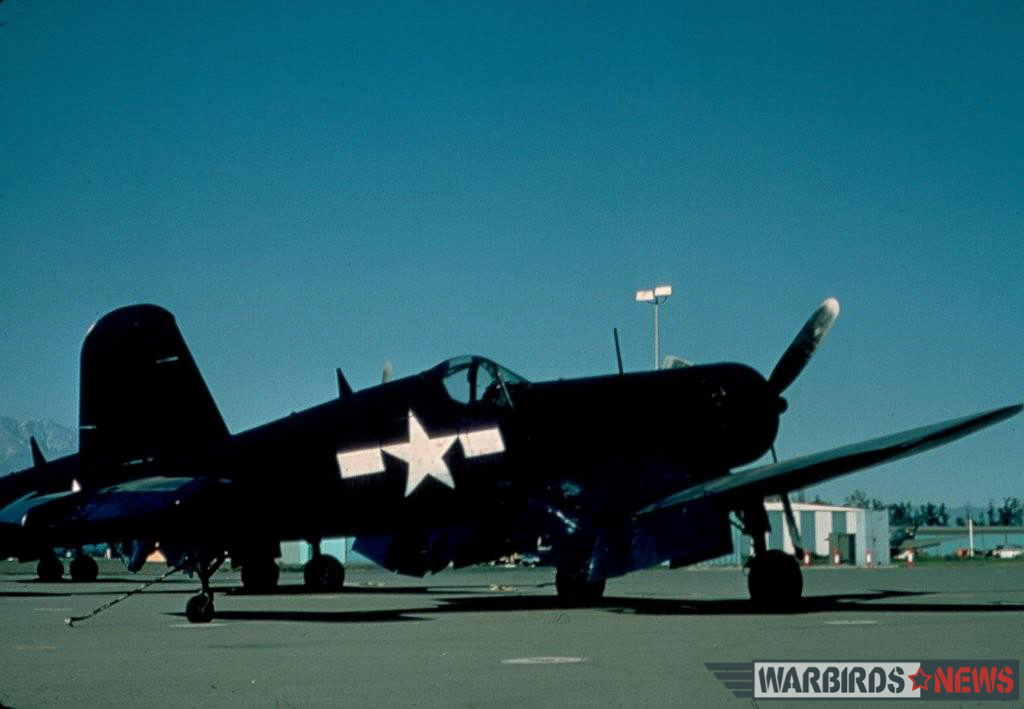
Len Berryman purchased the Corsair for his amusement park/playground in Bridgeport, Washington in 1958. The fighter sat in the park until 1973 when the late-David Tallichet saved the aircraft from an uncertain fate and returned her to flying condition. She began flying on Black Sheep in 1976 and is considered the lead aircraft for she appeared in 22 of the 37 total episodes. After the show’s conclusion, Tallichet placed the Corsair in storage.
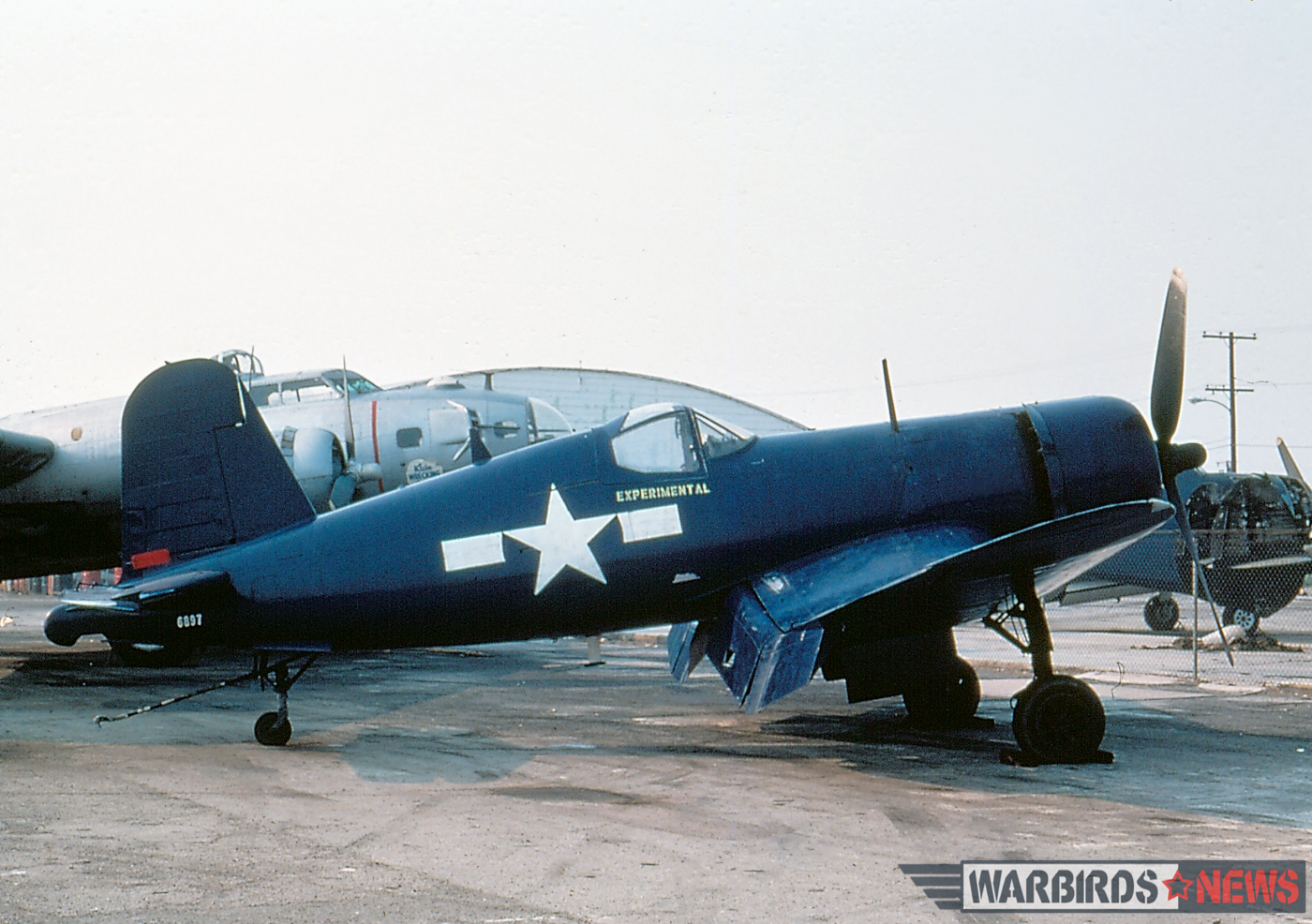
Gary Kohs acquired the aircraft in 1990 and shipped her to Airpower Unlimited in Jerome, Idaho. John Lane Jr’s team spent 17,000 man-hours and 13 years restoring the Corsair to its original factory configuration and set a new benchmark in Corsair restorations during the process. At EAA AirVenture Oshkosh 2003 the Corsair rightly earned the Grand Champion WWII Trophy and the Airpower Unlimited restoration team received the Gold Wrench Award. Later that year, 92106 received the Rolls-Royce Aviation Heritage Invitational and People’s Choice Trophy’s at the Reno Air Races.
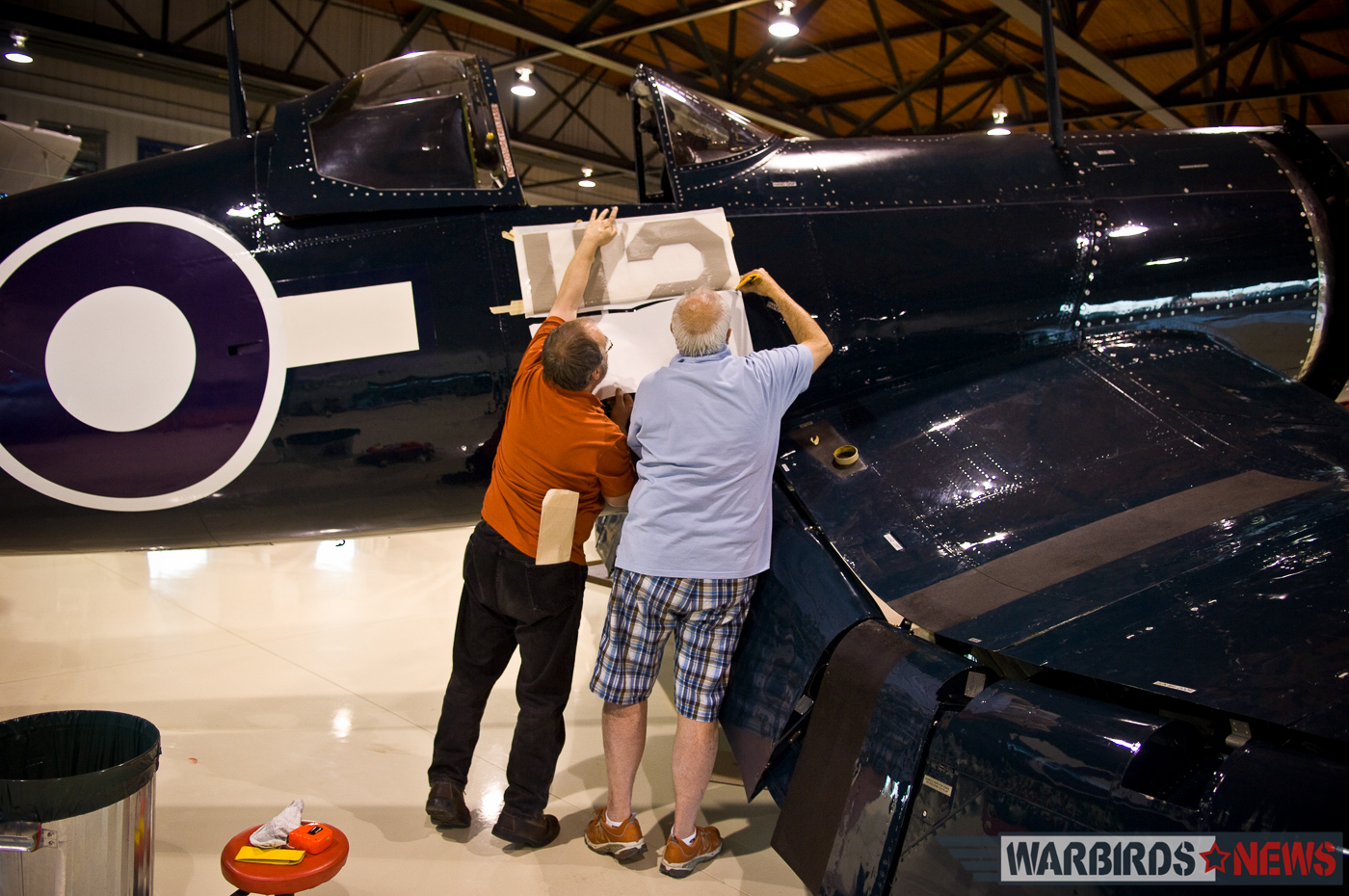
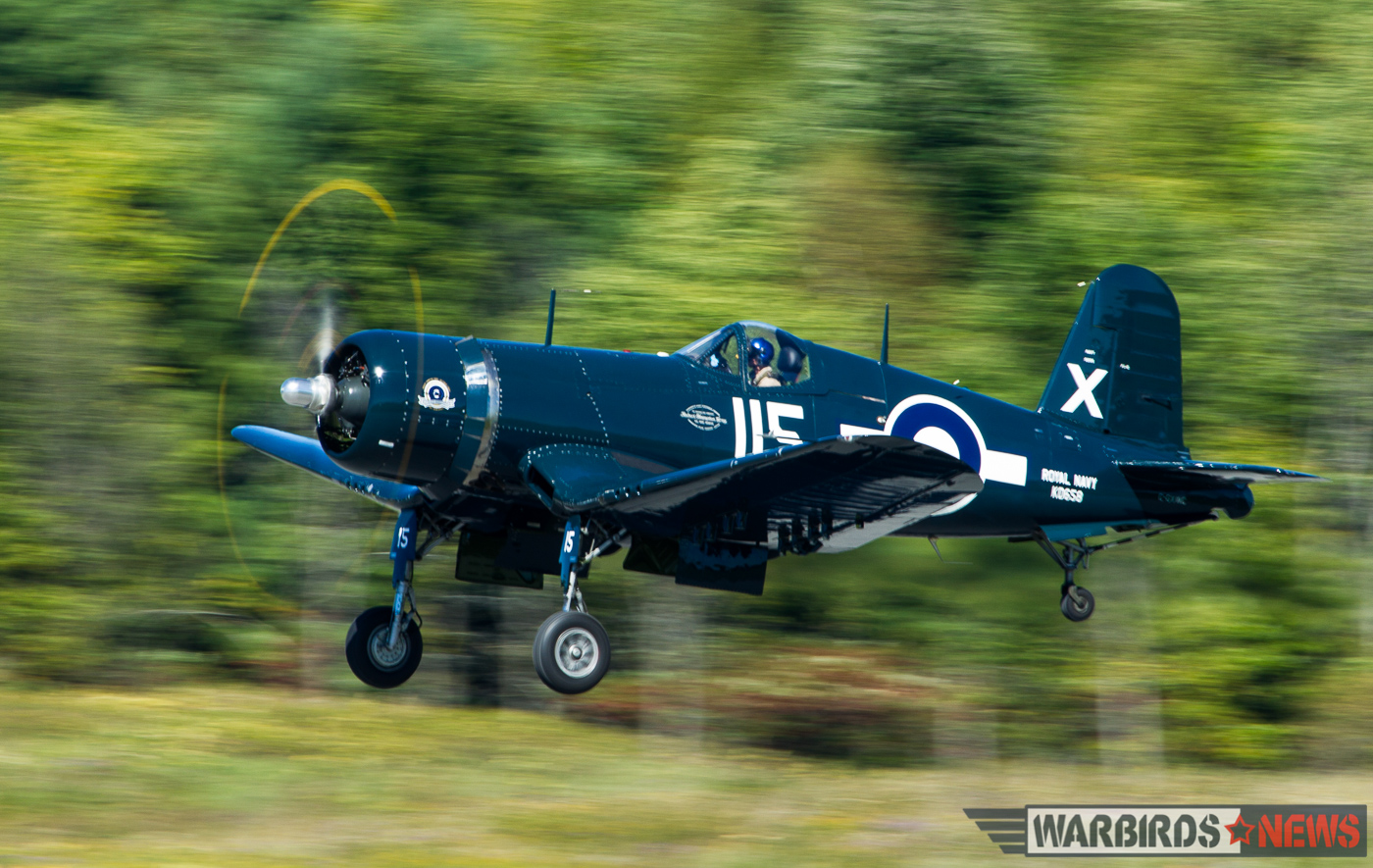
Mike Potter’s Vintage Wings of Canada (VWoC) flying collection purchased the Corsair in June 2007. VWoC already had a -4 Corsair on the books at the time, but had been searching for an earlier, -1 variant to more appropriately honor Canada’s naval fighter pilots who served within the Royal Navy’s Fleet Air Arm during WWII. Using specialized vinyl decals, VWoC applied markings to represent Corsair KD568 (115/X), the Corsair which Lt. Robert Hampton Gray flew on that fateful August 9th, 1945 mission over Japan for which he received, posthumously, the Victoria Cross, Britain’s highest military honor. Today, this Corsair is a fitting tribute to the dedication of Goodyear employees, the courage of Lt Robert Hampton Gray, and the patriotism of all Canadian veterans.
VOUGHT F4U-4 CORSAIR Bu.No. 97359
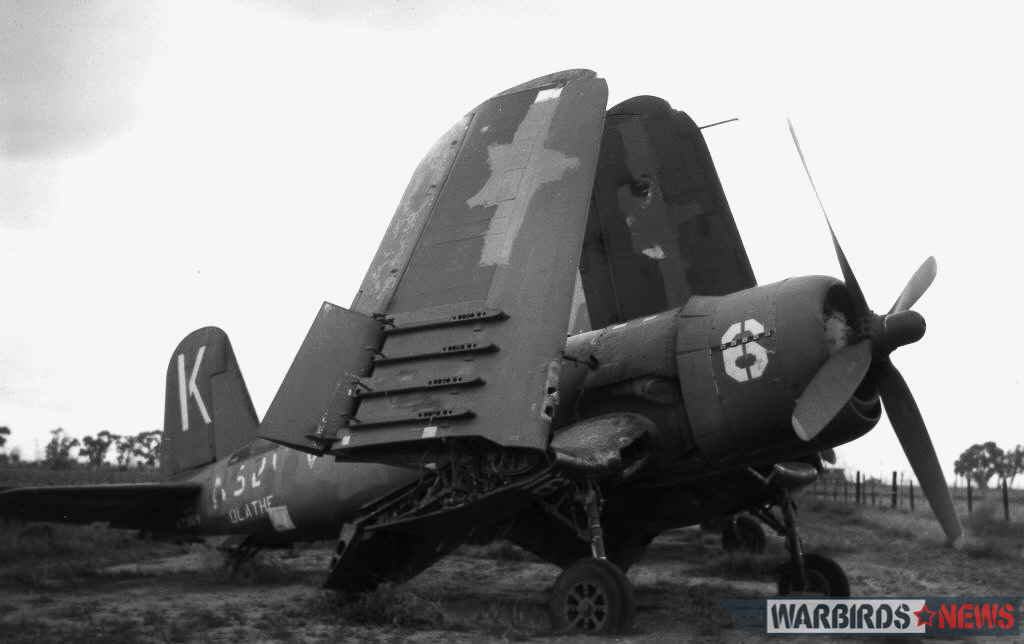
Upon acceptance by the Navy on March 12th, 1946, F4U-4 Bu.No. 97359 immediately entered storage for the next 17 months. Afterwards, the aircraft spent a few months in the aircraft pool in San Diego. It then served with several units around the country, including VMT-2 at MCAS El Toro, California.
On January 28th, 1953 the Corsair joined VF-44 Hornets at NAS Jacksonville, in Florida and saw extensive action from the decks of USS Lake Champlain and USS Boxer during the closing months of the Korean War. In the final years of her military career, ‘359 served with VF-74 at NAS Quonset Point, Rhode Island, VX-2 at NAS Chincoteague, Virginia and Naval Reserve squadrons in San Diego and Olathe. The Navy removed her from their books at Litchfield Park in July 1956 with 1,798 flying hours logged.
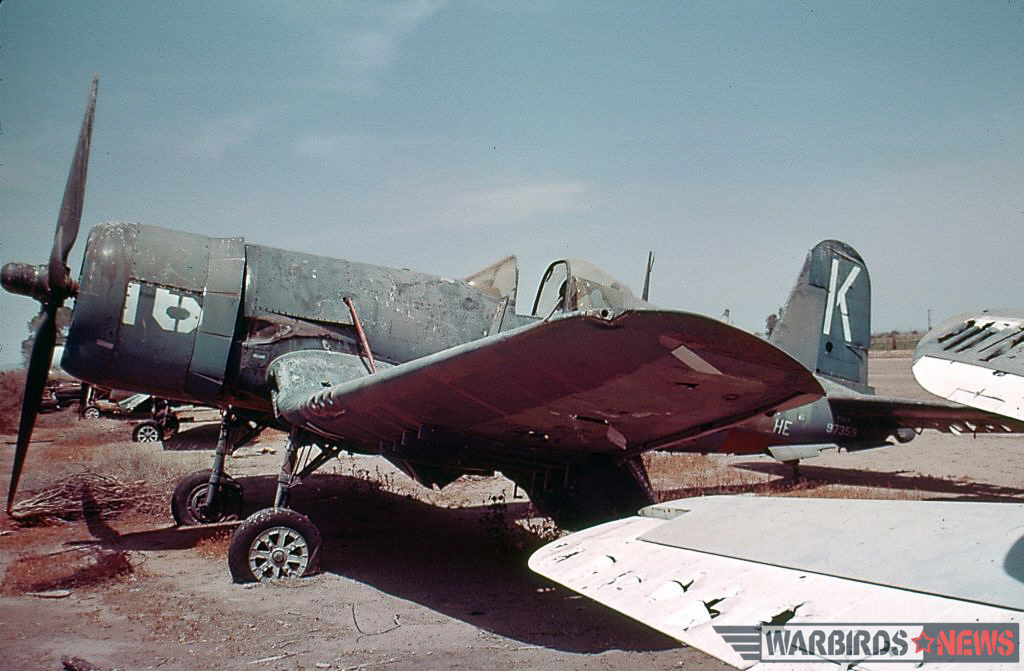
In November 1957, Bob Bean purchased the fighter for $1,500.99 and stored her outside for 19 years. When Tom Friedkin purchased the Corsair on November 19th, 1975, she hadn’t flown since her military days, but logged an incredible 300 hours during her career on Black Sheep. On screen, her four-bladed propeller and six 50-caliber guns can clearly separate this Corsair from the others.
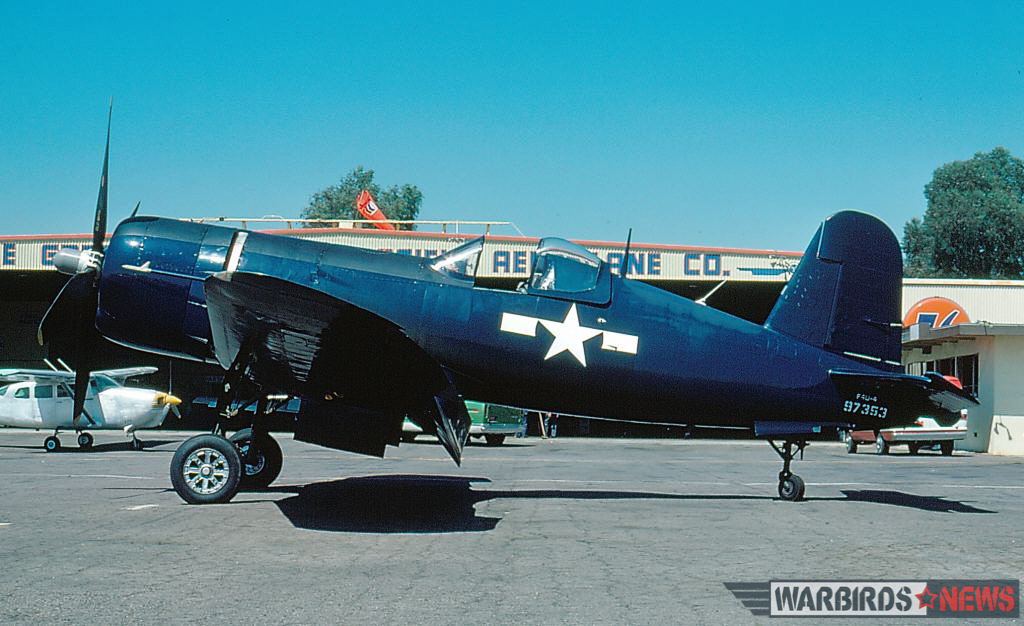
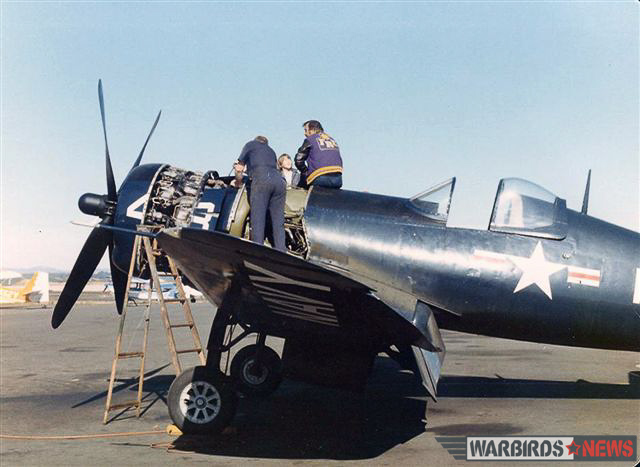
The Corsair remained in the Friedkin collection until January 1988 when he sold her to the Duxford-based Old Flying Machine Company, where she flew in Royal New Zealand Air Force markings. The Corsair returned home to the USA in 1992 and went through several owners over the next 20 years including Norm Lewis and Max Chapman. In 2006 she briefly reunited with her former Black Sheep co-star, FG-1D Bu.92106, at VWoC in Gatineau, Quebec. In March 2008, Doug Matthews purchased her and repainted the fighter to represent the Corsair flown by VF-32 pilot Lt (j.g.) Thomas Hudner during his Medal of Honor mission on December 4th, 1950.
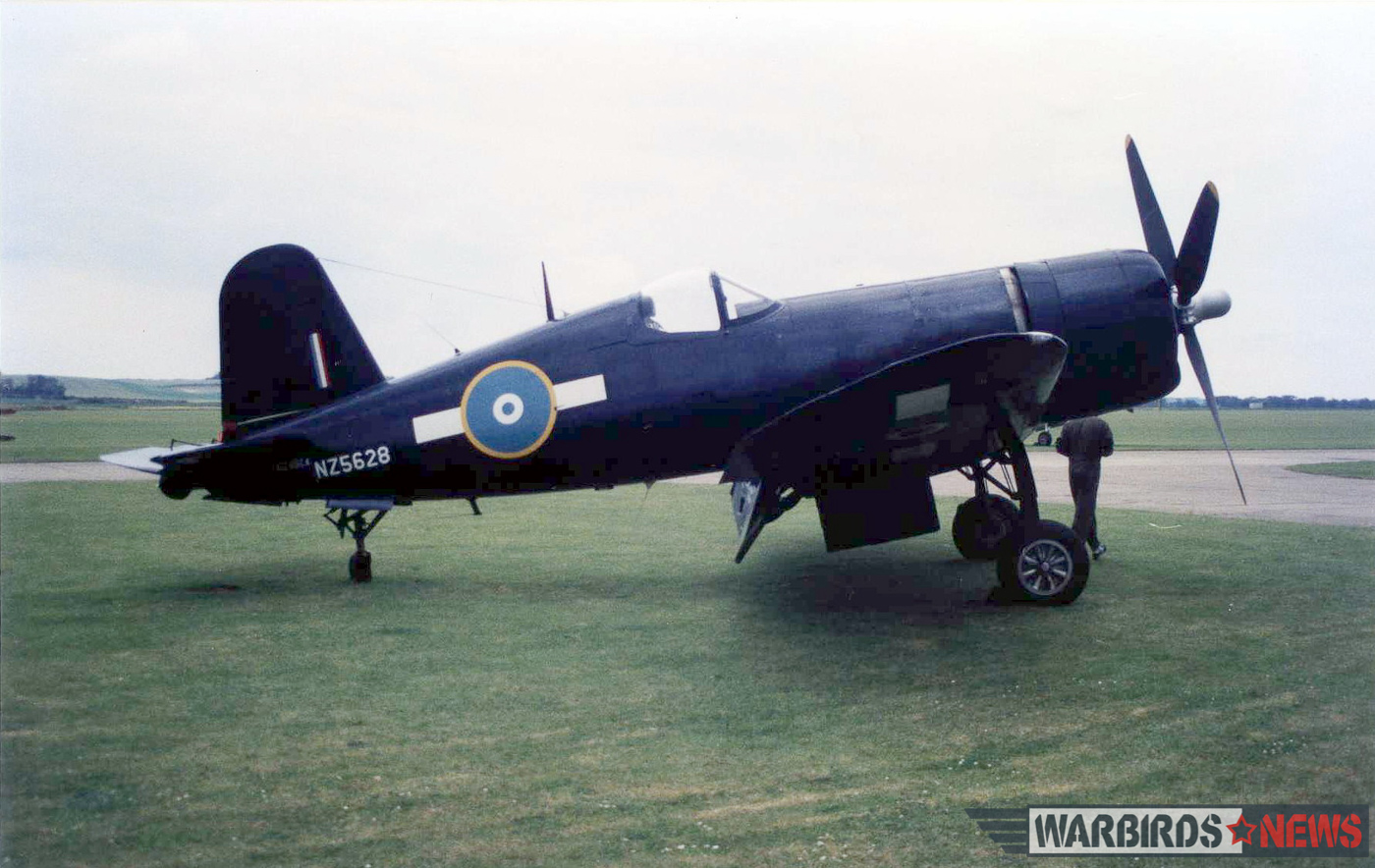
In 2010, someone discovered that Charles “Obie” O’Brien, a pilot flying with the Virginia Beach-based Military Aviation Museum, had flown this Corsair on three combat missions over North Korea in June 1953 from the deck of the USS Lake Champlain. In 2010, at 83 years old, O’Brien was the last Corsair combat pilot in the world still actively flying the type six decades on. When Doug Matthews, a former naval aviator himself, heard about Obie O’Brien he said without hesitation, “Well he has to fly it again.”
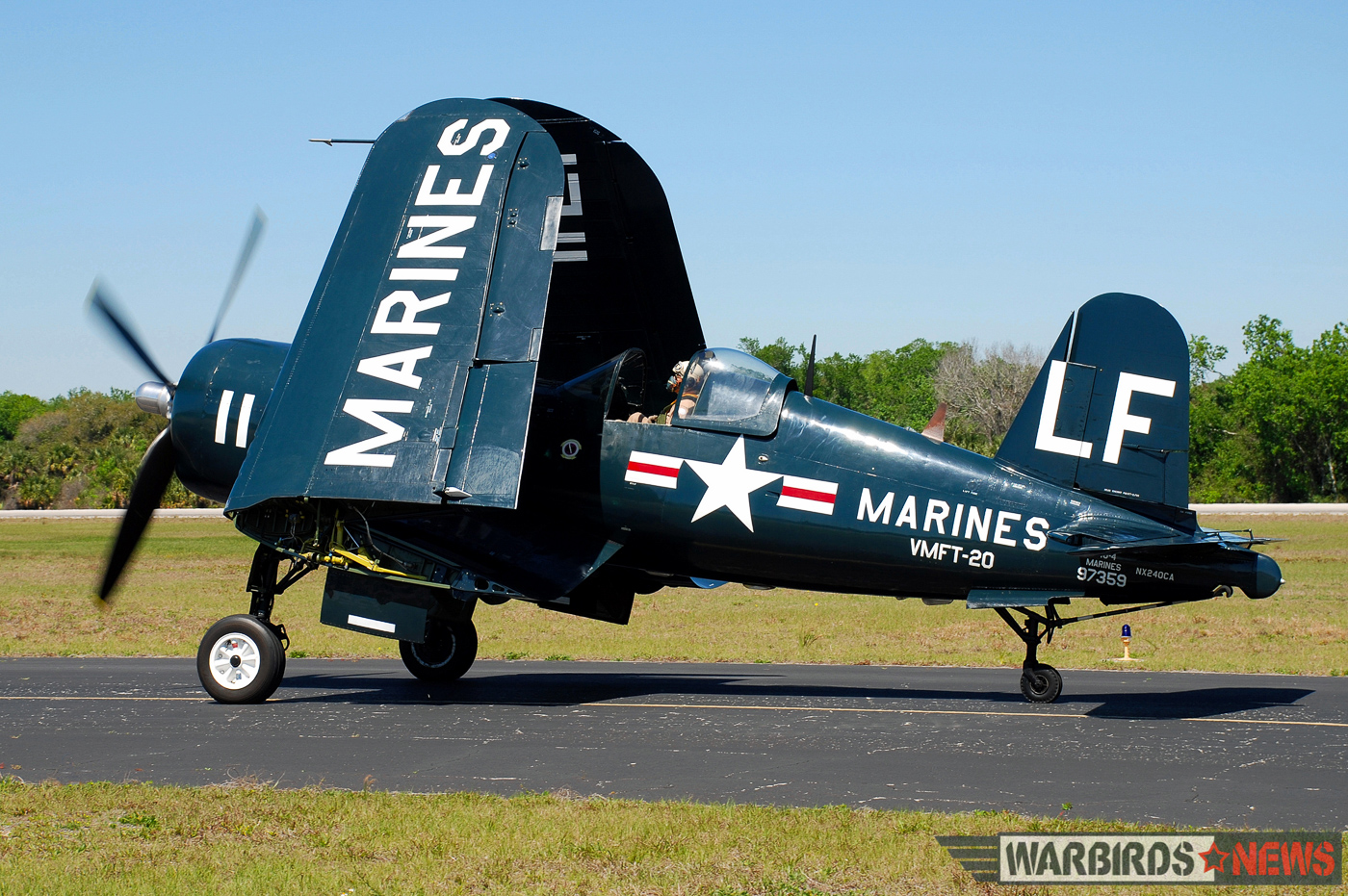
It took nearly three years, but in September 2012, the author, Warbird Digest editor Greg Morehead, and Obie were finally headed to Ramona, California, where Obie would reunite with his old combat steed. The last time Obie was in Bu.97359 was on November 20th, 1953 when he flew the Corsair ashore to Port Layute, Morocco while USS Lake Champlain was transiting through the Mediterranean Sea on her way home from the war zone. When the hangar doors opened and Obie set his eyes on the pristine F4U-4, his first comment was, “It sure looks better now than it did back then.”
Obie’s reunion flight took place during an NATA FAST clinic hosted by Doug Matthews and the word quickly circulated around the airport that a pilot that flew Doug’s Corsair in Korea was in town to fly it again … 59 years later!! Greg Morehead and the author had designed a special patch to commemorate the event and Obie spent the weekend shaking hands, answering questions, posing for pictures, and signing patches.
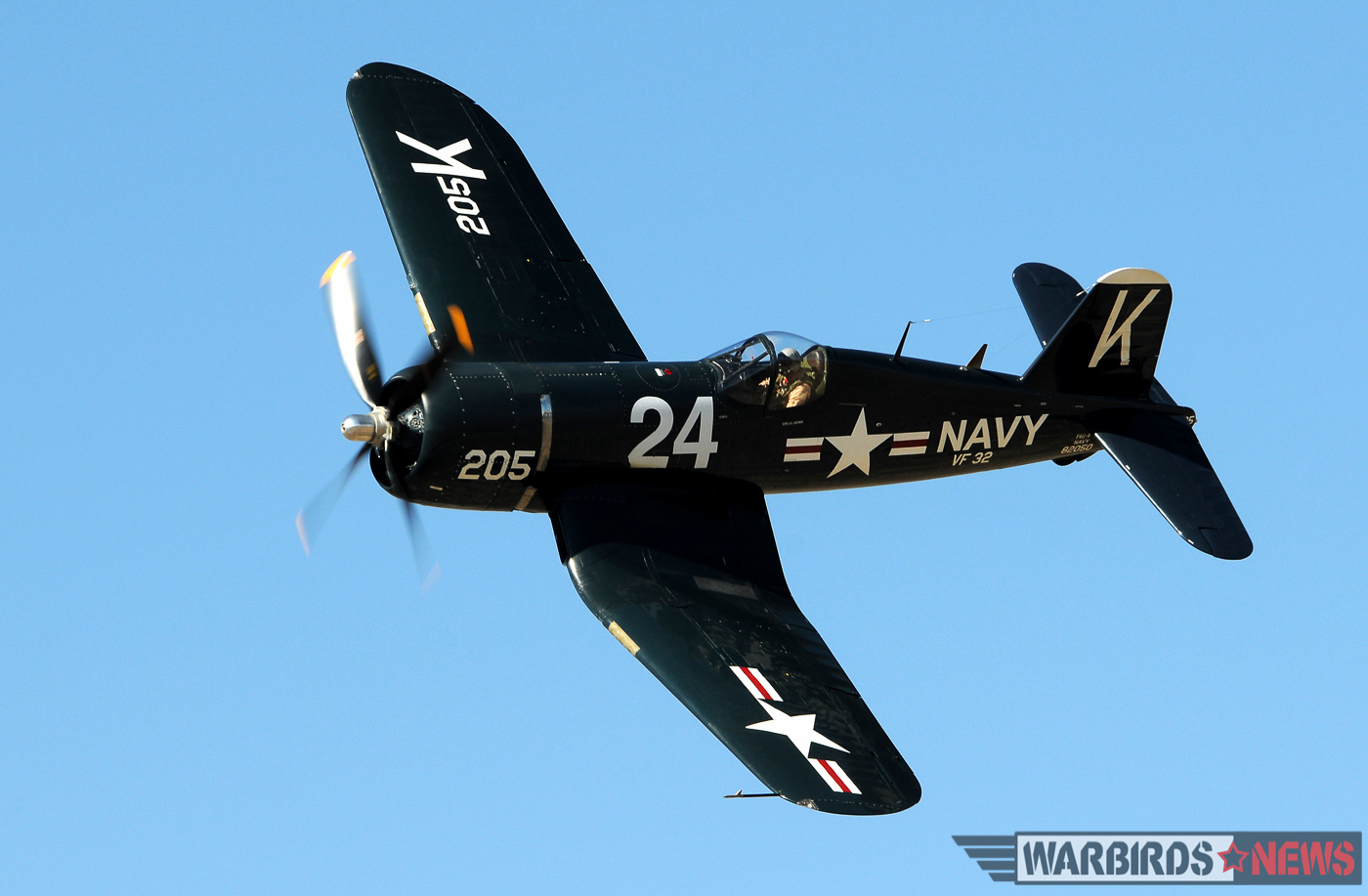
On Saturday, September 22nd, 2012, Obie climbed aboard Bu.97359 and expertly brought the Pratt & Whitney R-2800 to life. In the previous ten years, Obie had logged over 100 hours at the controls of MAM’s FG-1D, but this flight was different. It was special. He was once again about to fly the very same Corsair that he flew into the teeth of Communist AAA nearly six decades before. Dough and Greg had already taken off in the T-6 camera ship and as they came around the pattern, Obie poured the coals to the 2,000-hp radial and climbed into the clear California sky. At breakfast that morning, Doug jokingly said he’d arranged to have an LSO by the runway to grade his landing. There was no LSO, but at the completion of the photo flight, O’Brien made a crisp overhead break and flew a textbook arcing carrier pattern to a perfect landing.
When Obie shut down the Corsair in front of Doug’s hangar, there were cheers and applause for the silver-haired warrior. After more backslaps, handshakes, and pictures, Obie sat down in a lounge chair with a cold drink of water. While the FAST participants began briefing their next flight, Obie stared at “his” Corsair parked on the ramp. One could almost see the memories that were racing through his mind. In the years that followed this historic and emotional event, Obie quietly retired from flying and Doug Matthews sold the Corsair to a new owner.
VOUGHT F4U-7 CORSAIR Bu.No. 133710
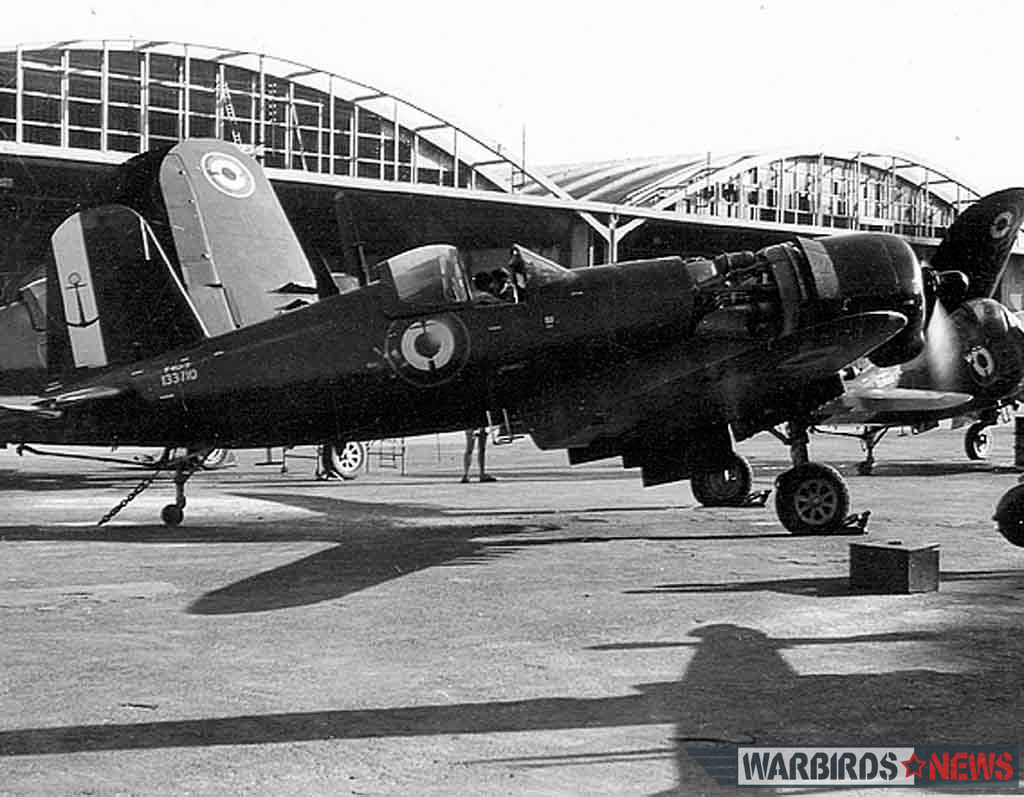
This second F4U-7 to appear on Black Sheep rolled off the Grand Prairie production line 17 aircraft behind Blue Max, and arrived at NAS Karouba, Tunisia on November 20th, 1953. Although it cannot be confirmed, it is believed that ‘710 was involved in combat operations in Indochina, Egypt, and Algeria.
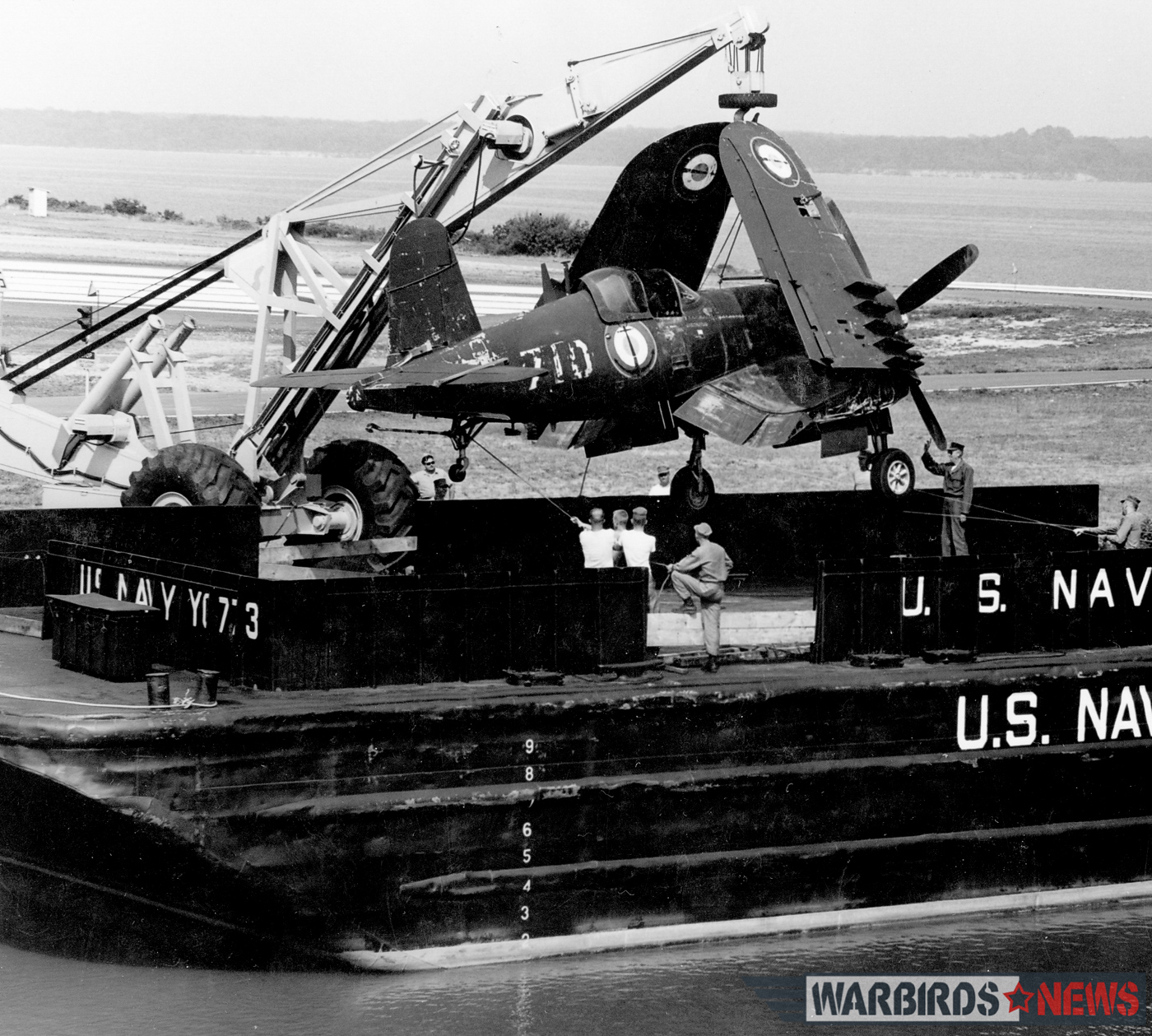
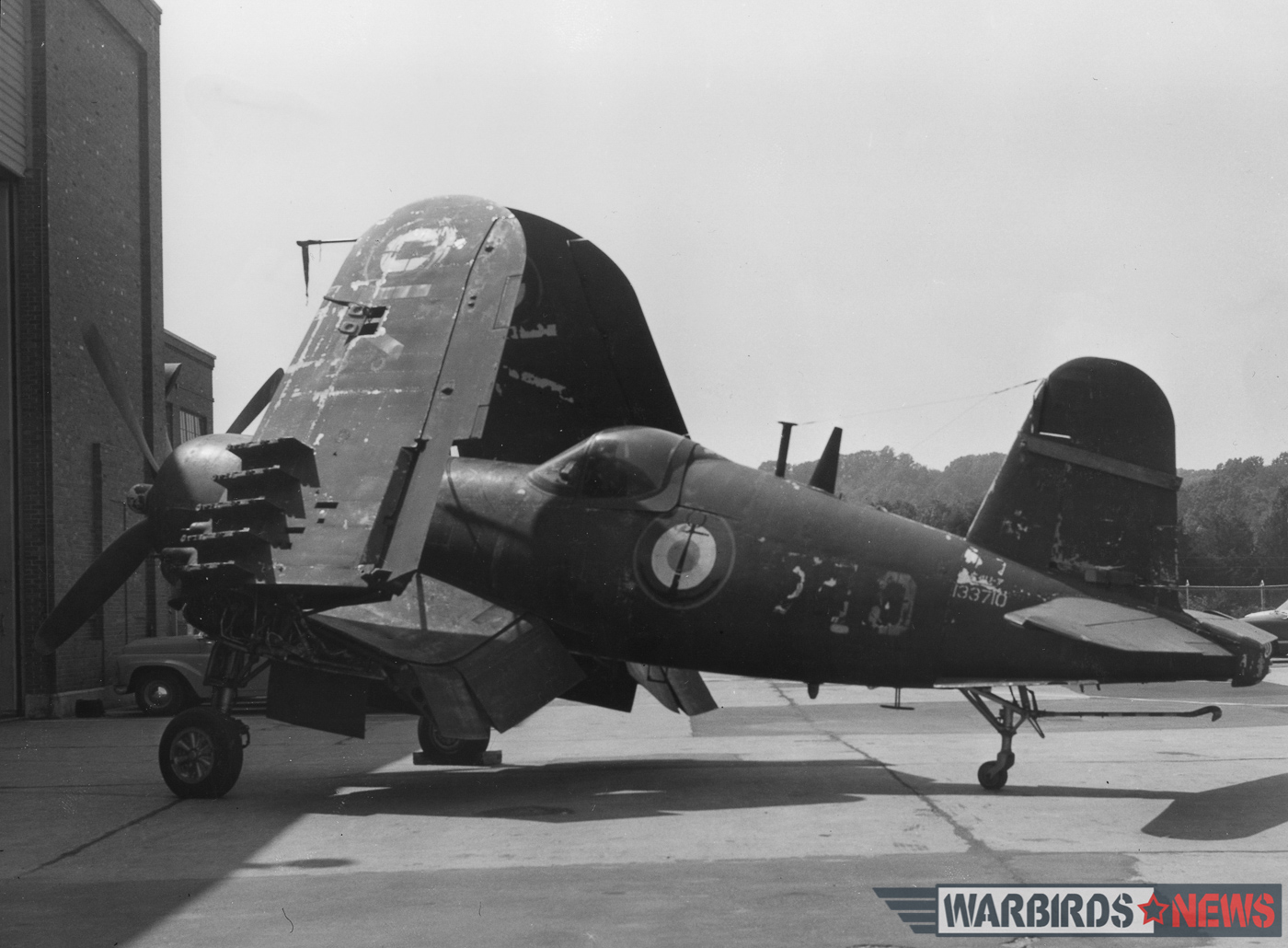
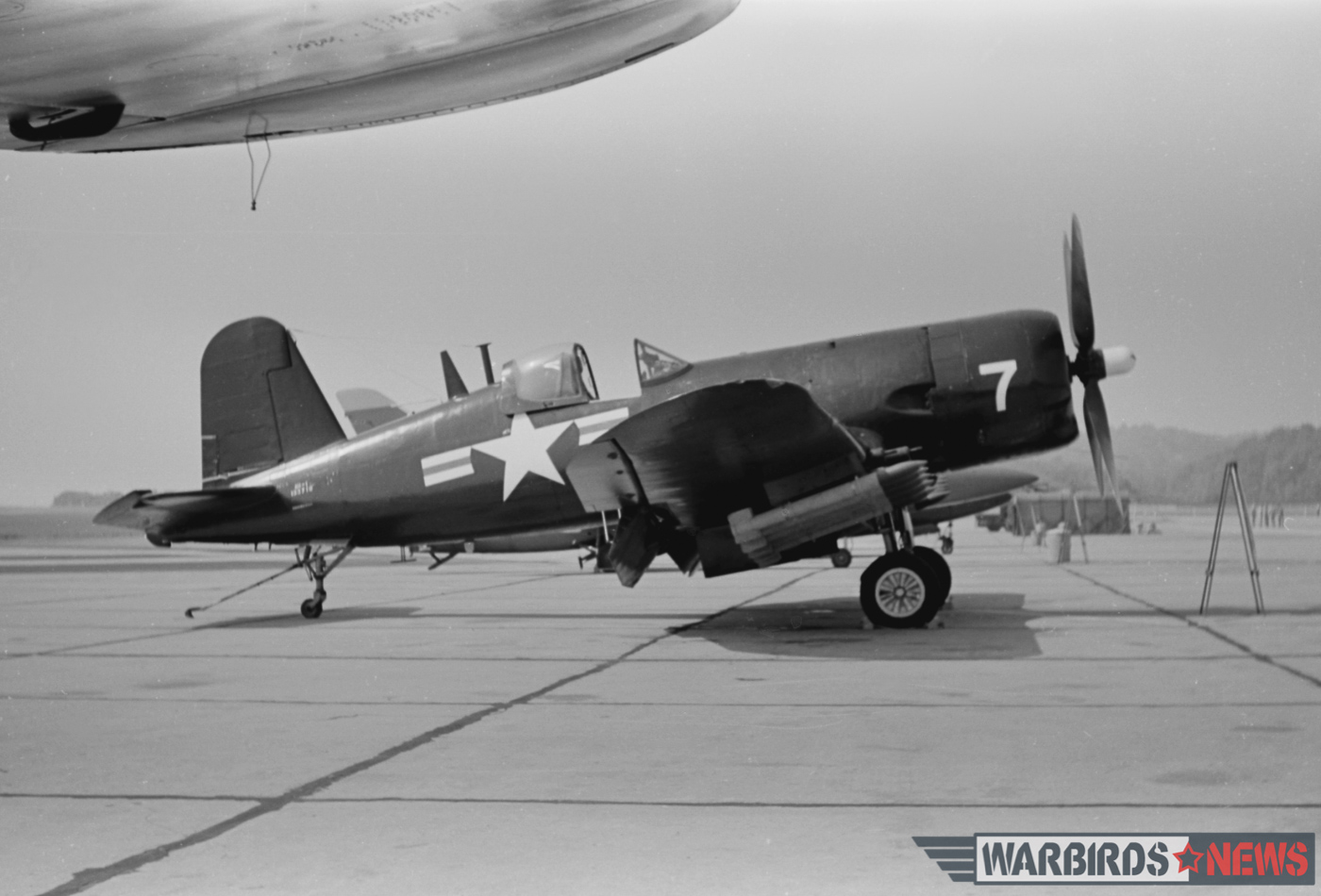
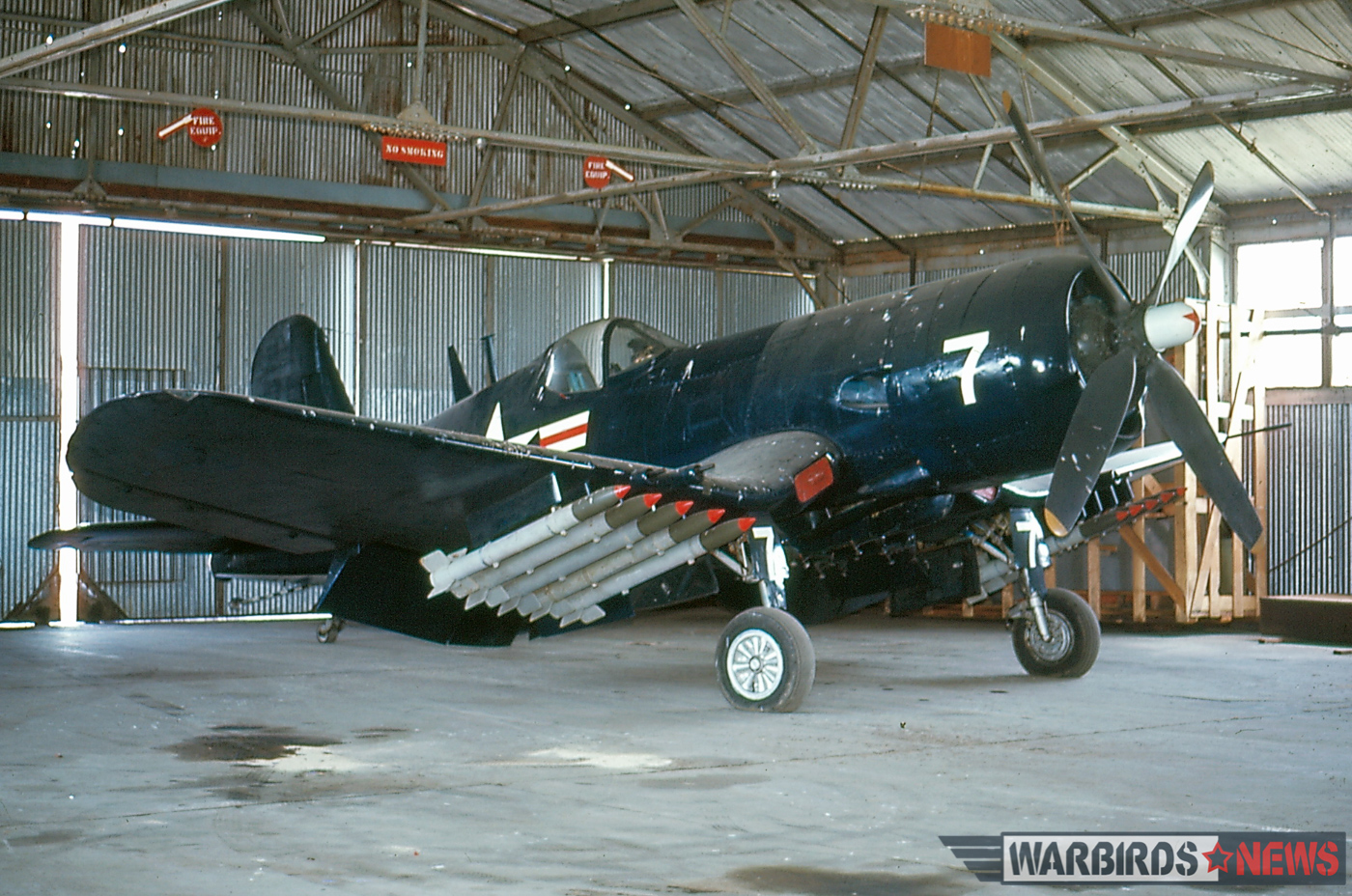
On August 21st, 1964 ‘710 arrived in Quantico, Virginia by barge, still wearing her French Aeronavale colors. Over the next several years the Marine Corps Air Ground Museum restored the Corsair, and finished her in a basic USMC scheme. In 1971, museum officials exchanged the -7 for an earlier model Corsair from Dean Ortner of Wakeman, Ohio. On August 17th, 1973 John Schafhuasen, a WWII Corsair pilot, bought the Corsair and flew it throughout Black Sheep filming. This aircraft is easily identifiable on screen due to its protruding 20mm gun barrels.
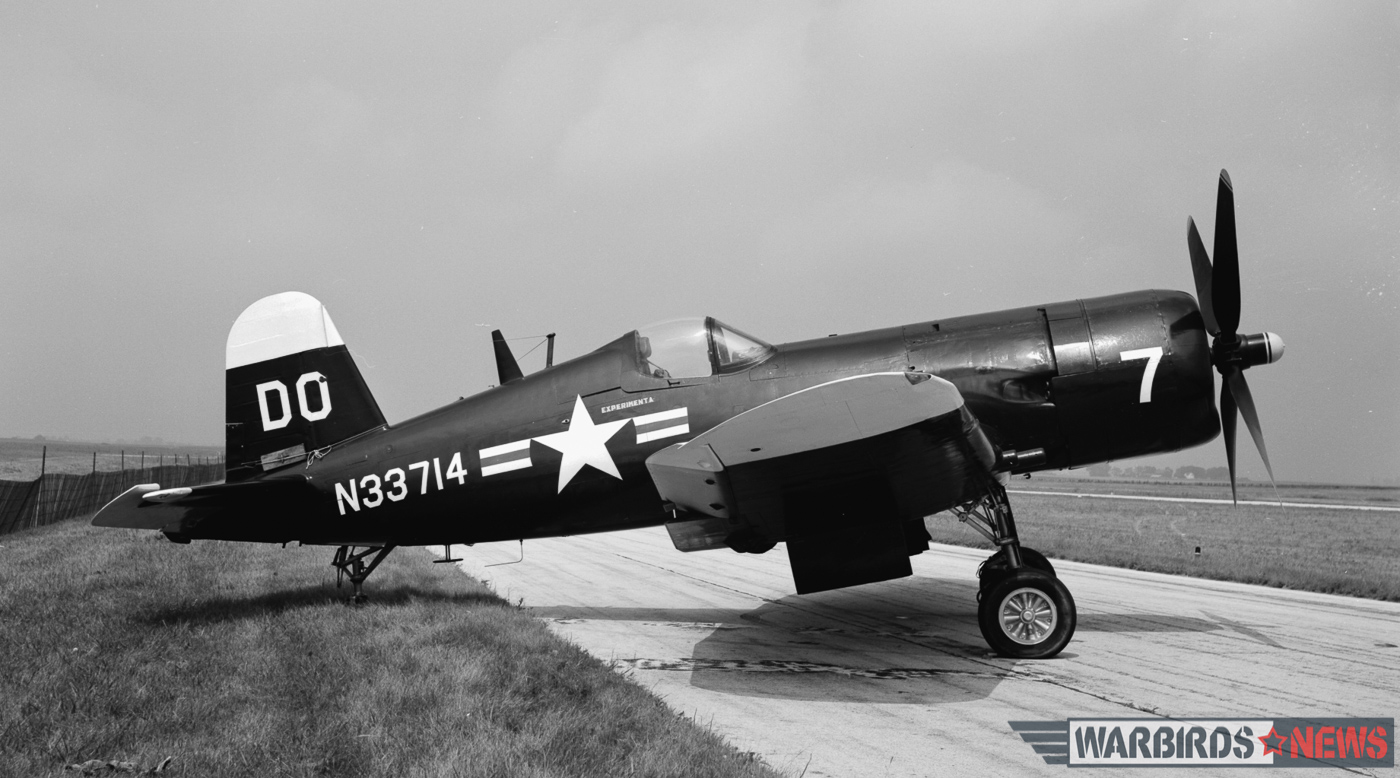
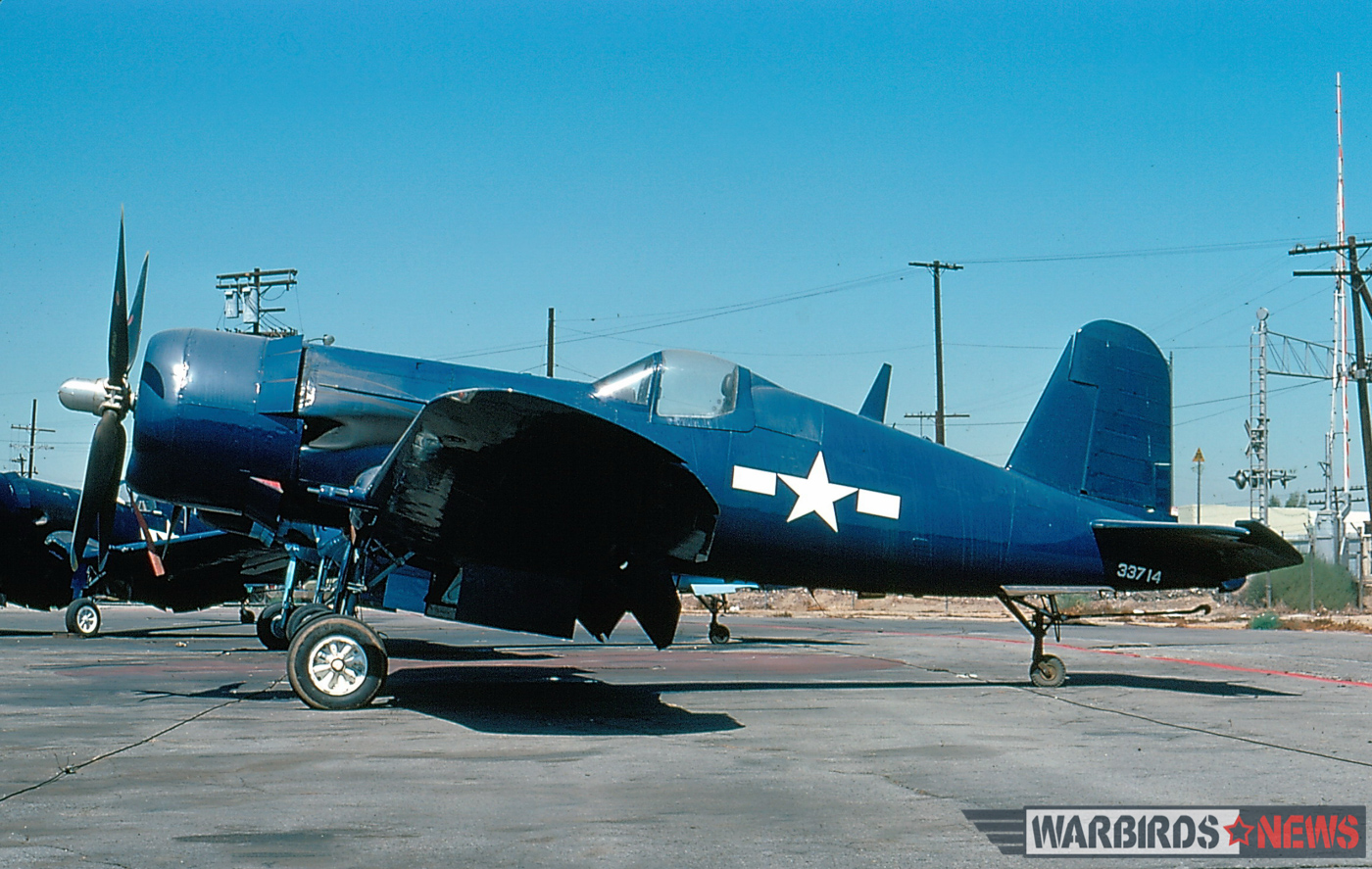
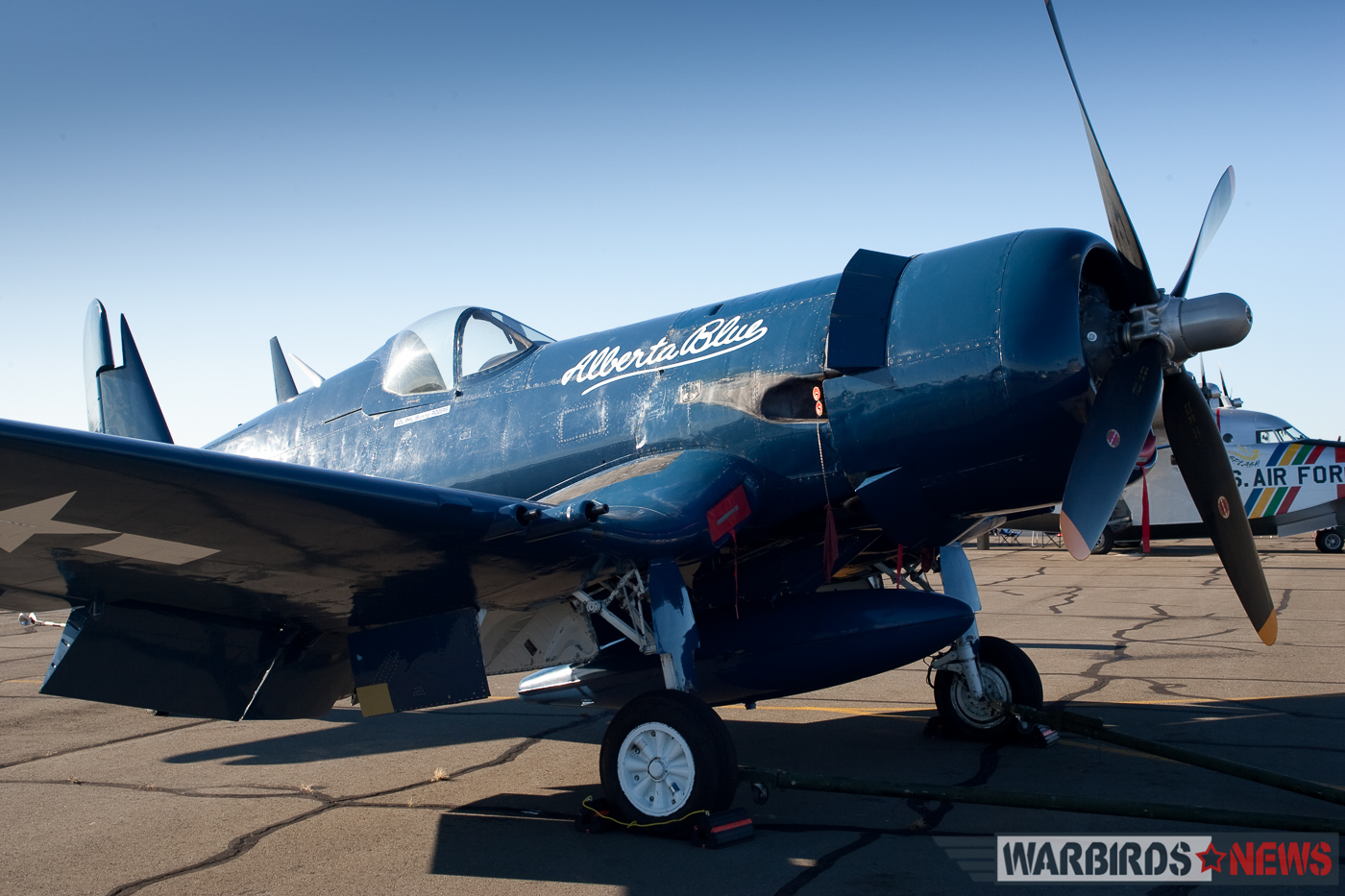
Schafhuasen flew the Corsair until 1983, when he sold it to Canadian, Blain Fowler, who displayed her as Alberta Blue at air shows throughout the United States and Canada for the next 21 years. In 2004, Philip Rogers, owner of the high-technology fiber optics firm Optical Air Data Systems (OADS) purchased the Corsair, but rarely flew it. In April 2013, he listed the aircraft with Courtesy Aircraft Sales and John O’Connor purchased the rare fighter in December 2014. John sent the aircraft to John Lane’s Airpower Unlimited where it is under conversion into the sadly extinct, AU-1 close air support variant.
THE AVIATORS:
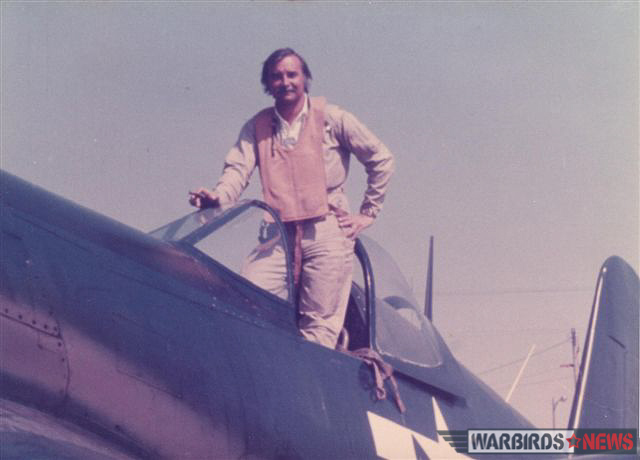
THOMAS FRIEDKIN
Tom Friedkin learned aviation from his father, Kenneth, who flew Spitfires during WWII. By the late 1960s Tom had built an impressive collection of ‘surplus military aircraft’ including a T-6, P-51, P-38, and the previously mentioned combat vet F4U-4 which lead to a phone call from Frank Tallman in 1975. Frank said that NBC was looking for Corsairs to use in a new TV show about Pappy Boyington. Tom agreed, but only if he could fly his own airplane.
Prior to flying on the show, Tom got together with a few of his friends to knock the rust off his formation flying skills. When speaking of this demanding type of flying, Tom says, “Formation flying is a very perishable skill and if it is not done regularly you lose your edge”. During filming, Tom mostly piloted his F4U-4, but he also flew the other Corsairs, P-38, C-47, and various Tora Kates, Vals, and Zeros.
As mentioned earlier, the flying scenes on ‘Vella LaCava’ were filmed at Indian Dunes Airport near Valencia, California. Although there were wires on the east end of the field, Tom says he and the other pilots had no problems flying the Corsairs off the 3,800ft dirt strip. However, heavy rains would often leave huge puddles on the runway, which Tom nonchalantly says would make take-offs and landings “…a little interesting.”
Tom and his fellow pilots often flew up to three sorties a day, some lasting up to 90 minutes. He says there were a few occasions when airplanes got a little too close but other than that there was never any foolish flying on the show, and that Dick Martin, Tom Mooney, Steve Hinton, Jim Maloney, Frank Tallman, John Schafhuasen, Bill Yoak, and Junior Burchinal were all top rate pilots. While Tom thoroughly enjoyed the flying, he was never thrilled with the long hours of standing around the set waiting to do something. Even if there was no actual flying going on, Tom said the producers would always keep a couple of pilots on the set in case they needed somebody to start an engine, or taxi around the strip.
Looking back, Tom says, “Black Sheep was a tremendous experience every single week.” After Black Sheep, Tom went on to fly for numerous TV shows and movies. He still actively flies the warbirds in his collection. When you ask Tom what his favorite aircraft is, he says, “The one I happen to be sitting in.” However he loves the Corsair, “…it is simply a very lovely and smooth airplane to fly.”
STEVE HINTON
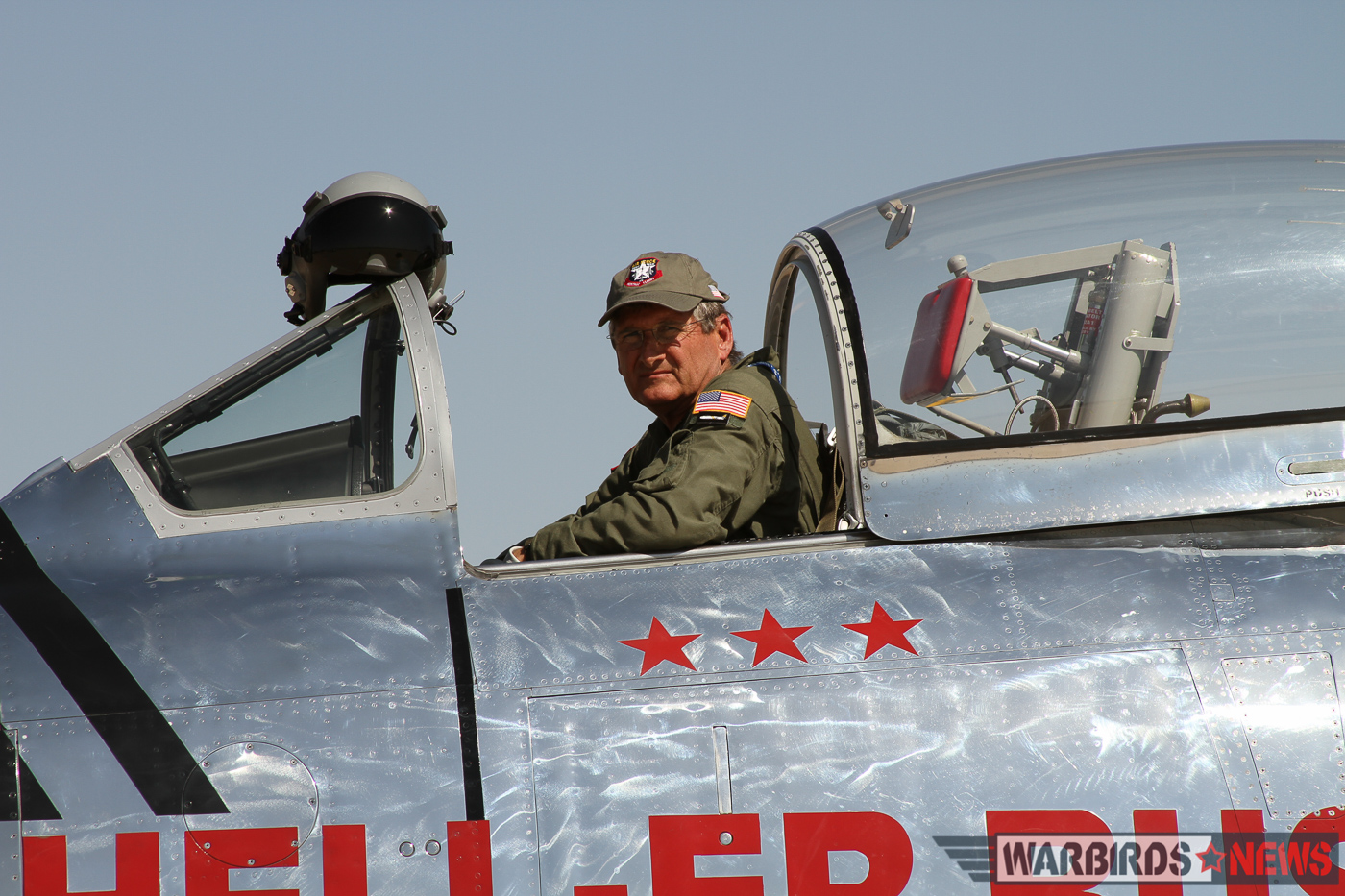
One hour and twelve minutes: That is how much Corsair time Steve Hinton had when John Stokes called him about working on Black Sheep. Hinton recalls the conversation, “John called me up and said ‘How you would like to fly the Corsair (FG-1D BuNo 92629) for an upcoming TV show?’ I said, ‘Well yeah, but I don’t have much Corsair time, but I do have time in Hellcats and Mustangs.’ He said, ‘Well why don’t you come pick this thing up.” Hinton went down to San Marcos, Texas and ferried the Corsair back to California via Fort Stockton, El Paso, Tucson and Chino. A few days later, Hinton flew the Corsair to Oxnard where he joined Tom Friedkin, John Schafhausen, Tom Mooney, and Glen Riley for nearly a week of flying.
Steve echoes the sentiments of the other pilots, that while movie flying seems glamorous and exciting, it often involves long hours of very challenging flying. A majority of the sorties were flown at slower than normal speeds in close formation, often at low altitude, with airplanes that were in less than ideal shape. Compared to today’s fully restored warbirds, most of the Black Sheep Corsairs were still leftover from the Navy and had received only enough maintenance to get them airworthy. There were some engine problems, hydraulic issues, bad radios, etc, but as worn out as the fighters were, they got the job done.
Steve still laughs at how the flying scenes were edited, “We would film for hours and days over the Channel Islands- flying low over a beach with the gear down, flying up and down canyons, peeling off, joining up, and various other maneuvers. We’d do all that filming and then they’d use the same scene twelve times! Back in those days we had to wait until the next day when we watched the dailies to see if we got what the director wanted. In today’s aerial film industry everything is better than in 1975- the airplanes, the communications, and with video overlap we can review a scene immediately.”
At the end of the interview, Steve offered some final thoughts on his Black Sheep days, “The flying was always fun, you always remember the flying, but I’d have to say the best memory is that I got to fly with Frank Tallman, Tom Friedkin, Jim Gavin, Art Scholl, and Bill Yoak. How cool is that? It seems like yesterday, but when I look at pictures and see the length of the sideburns, I realize it was a long time ago. It was a privilege. Things happened in my life that took me on a path. I’ve met a lot of great people and incredible pilots. It’s been really good and I’ve been really lucky. These airplanes are just a conduit, because they attract the same kind of spirited people…its cool.”
STEVE ROSENBERG
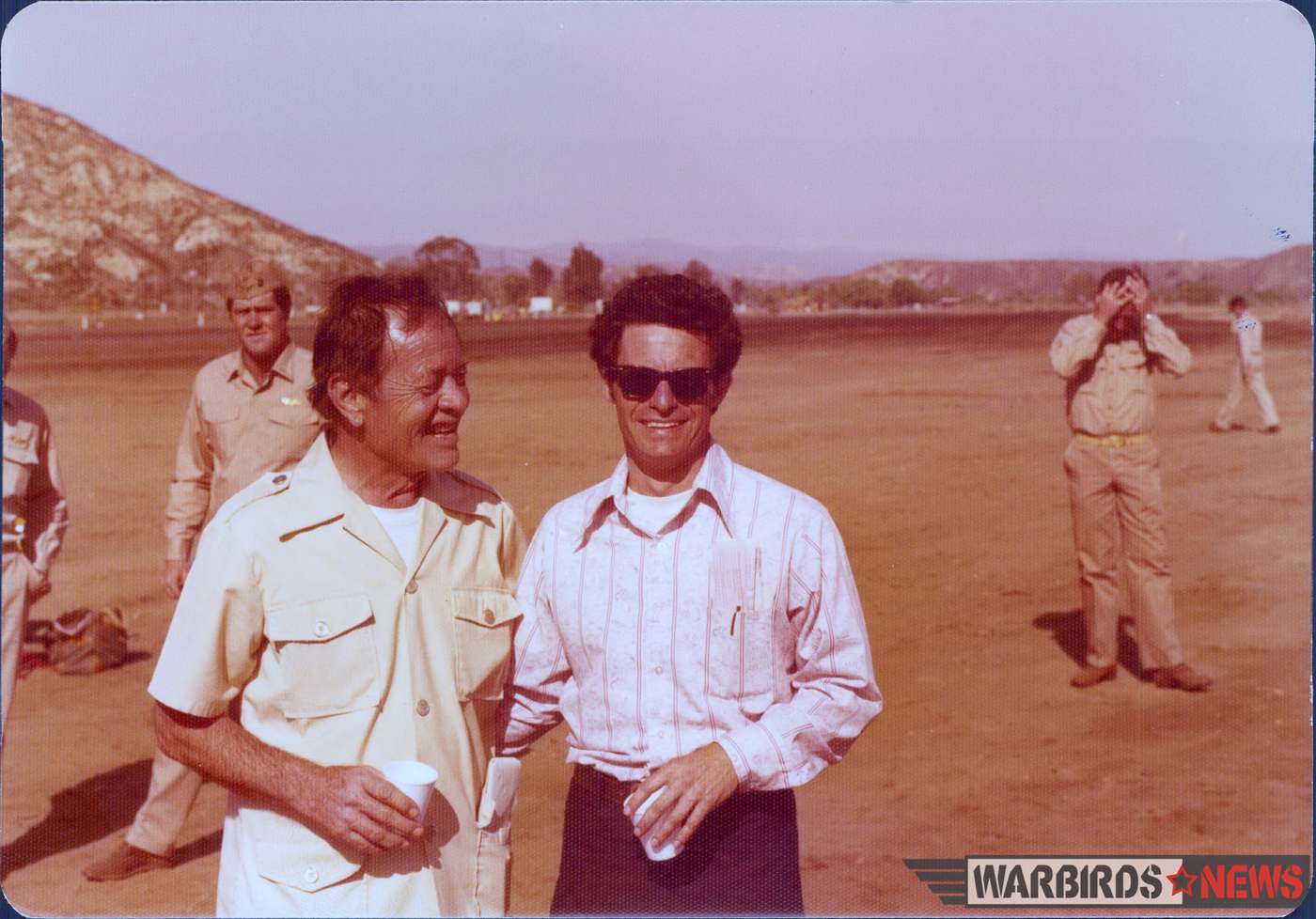
Steve Rosenberg met Bob Guilford at Van Nuys, California in 1964 and describes Bob as, “…a bright, wonderful guy and a real go-getter.” Bob heard about Baa Baa Black Sheep in late 1975 and asked Steve to fly the -7 in the series. In March 1976, Steve drove to the Indian Dunes airstrip where he met Pappy Boyington, Frank Tallman and a few of the other pilots. When Steve first flew the Corsair into Indian Dunes in August 1976, he made an electrifying arrival. He was not aware of the unmarked power lines that ran across the east end of the field and struck them on short final. Steve recalls, “…the entire cockpit lit up.” The wires briefly caused the aircraft to decelerate and when they finally broke Steve was in the flare, and ended up making a great landing. He taxied to the parking area with parts of the wire dragging behind the aircraft. The Corsair was largely unscathed, but the same could not be said for Steve’s ego. Although he did not know it until many years later, the cameras had filmed his arrival and the footage was used in Divine Wind, which aired on December 14th, 1977.
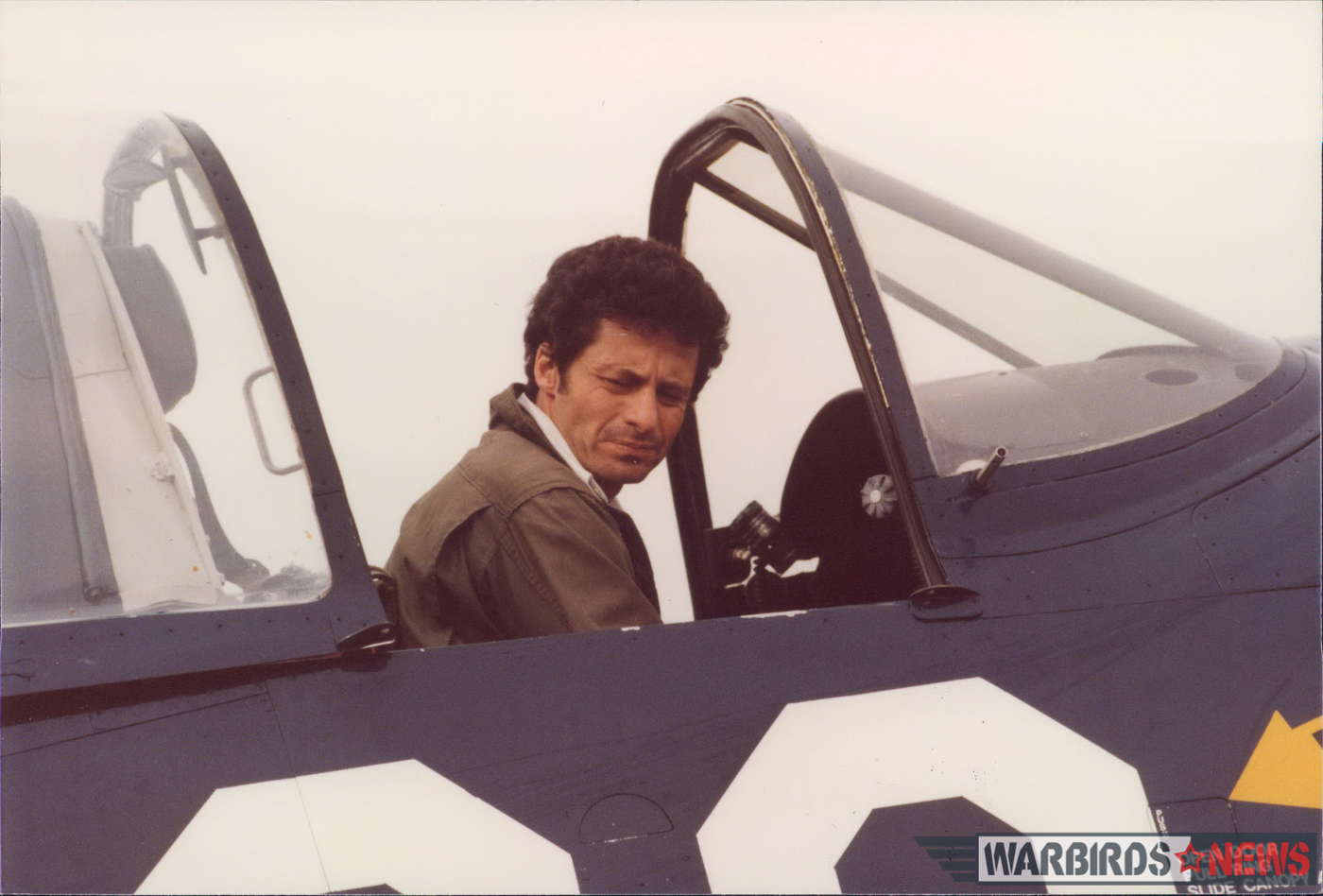
In the 2011 interview for this article, Steve described the August 19th, 1976 engine failure that ended his Black Sheep career after just three sorties, ‘I took off for a short flight out of Van Nuys. I pulled into a loop and simultaneously noticed a light inside the cockpit and smoke coming down the left side of the fuselage. I rolled the aircraft upright, checked his gauges. The oil pressure was down to 25psi and temperature rising through 128 C. The prop was free-wheeling, but I had no power. Luckily I was at about 7,000 feet which was enough for me to make a straight-in approach to Van Nuys’ 16R. I wheeled it on and coasted off one of the high-speed turn offs just as the R-2800 seized.’ Although this seems like a dramatic incident, Steve’s logbook entry for this flight simply reads VAN NUYS LOCAL 0.6HRS- ENGINE FAILURE. The engine change that followed turned into a full-fledged restoration from which the Corsair did not emerge until 1979- a year after Black Sheep was cancelled.
Steve made the first post-restoration flight in Bare Metal Max in April 1979, and continued flying his aerobatic displays until the Corsair was destroyed on that tragic day in 1987. Steve has not flown a Corsair since, but his 350 hours in Blue Max left a lasting impression on him, “The Corsair was a great airplane in which to do air shows. It rolls better than a Mustang, and is simply a wonderful, Cadillac of an airplane.”
BILL YOAK
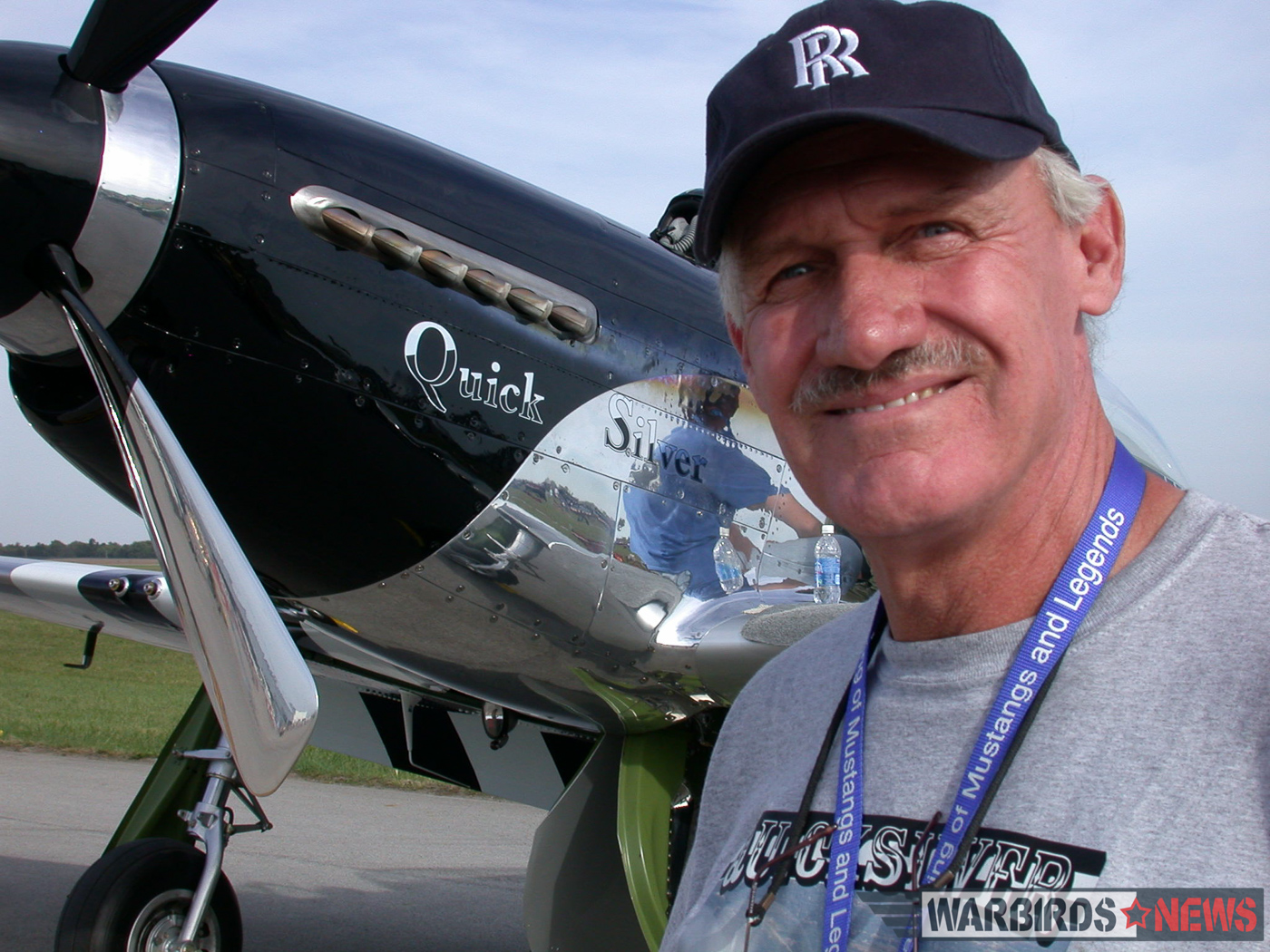
Bill Yoak says he became involved with Baa Baa Black Sheep because he was in the right place at the right time, and more importantly, he knew Tom Friedkin. Tom told director Jim Gavin, “Yoak is a good stick with great credentials.” However, Bill was severely injured in a motorcycle accident and was not able to fly on the Flying Misfits pilot.
Although Bill would eventually fly every Corsair variant except the F2G, in 1976 he’d never even sat in a Corsair. This made for a memorable first flight. Just days after he got out of the back brace, Gavin called him up for his first job, which partnered him with Tom Mooney. Tom asked Bill if he’d ever flown a Corsair. Bill said no. So Tom, a legendary Marine Corps Corsair pilot, gave Bill a brief on flying the Corsair and the duo blasted out of Indian Dunes. During the 40-minute flight they made several low passes, formation rolls, and individual victory rolls over the field and just like that Bill’s checkout was complete, all in front of the cameras.
Bill experienced several in-flight emergencies during filming, one of which caused serious injury. Bill and several others were about to begin filming a scene about 15 miles off the coast when he noticed a very acidic odor followed by a sudden jolt. Bill quickly ascertained that the battery had exploded when the cockpit suddenly filled with a fog of acidic battery fumes. The fumes quickly began to burn Bill’s throat, eyes, and exposed skin and opening the canopy made the situation worse. By the time Bill communicated his dilemma, his throat was so scorched his voice was nearly unreadable. Eventually Bill was able to open the canopy for some fresh air but the damage was already done. Through blurred vision Bill set the Corsair down at Oxnard and was treated by a nurse on the set. However, he refused further treatment at a medical facility and was back in the cockpit a week later.
Aside from this Bill said he thoroughly enjoyed the flying and the people he met on Black Sheep. The valuable friendships and tremendous experience gained in movie flying and special effects including designing camera mounts and explode plates on the Corsairs and Zeros lead to two decades of work in the movie industry. In our final conversation, Bill summed up his Black Sheep days in one sentence, “I got to fly with some of best pilots in the world.”
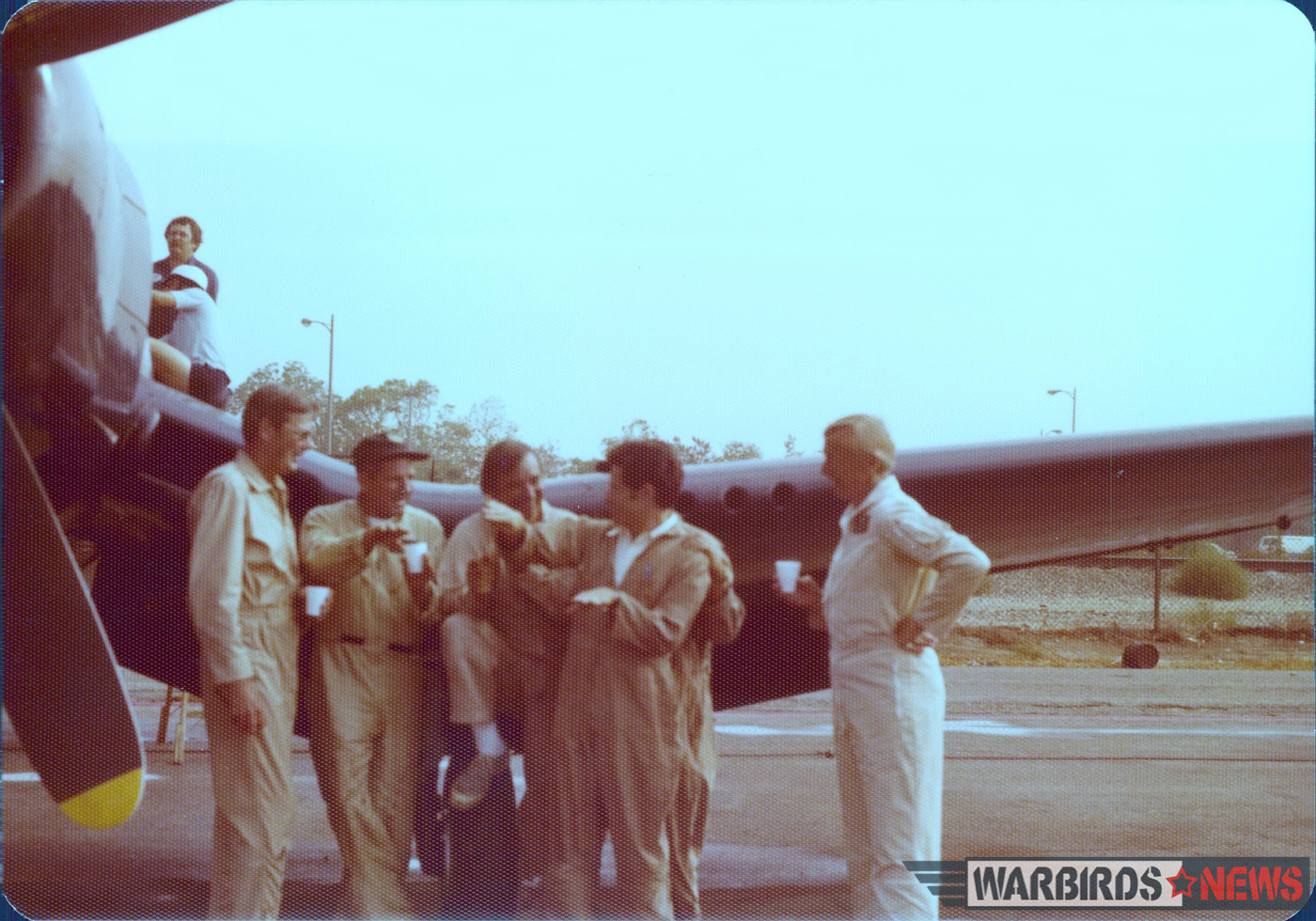
The author would like to thank the photographers who graciously provided photos for this article. Thanks also goes to the following individuals- Mark Carlson, Dan & Tom Friedkin, Craig Fuller, Jeff Givan, Steve Guilford, Steve Hinton, Frank Kimmel, Doug Matthews, Rob Mears, Mark Morris, Phil Rogers, Steve Rosenberg, Darin Strobel, Paul Redlich, and the late-Bill Yoak who regaled the author with many hilarious stories that can never be printed. Thanks Yoak Dog.
Some additional images from the set…
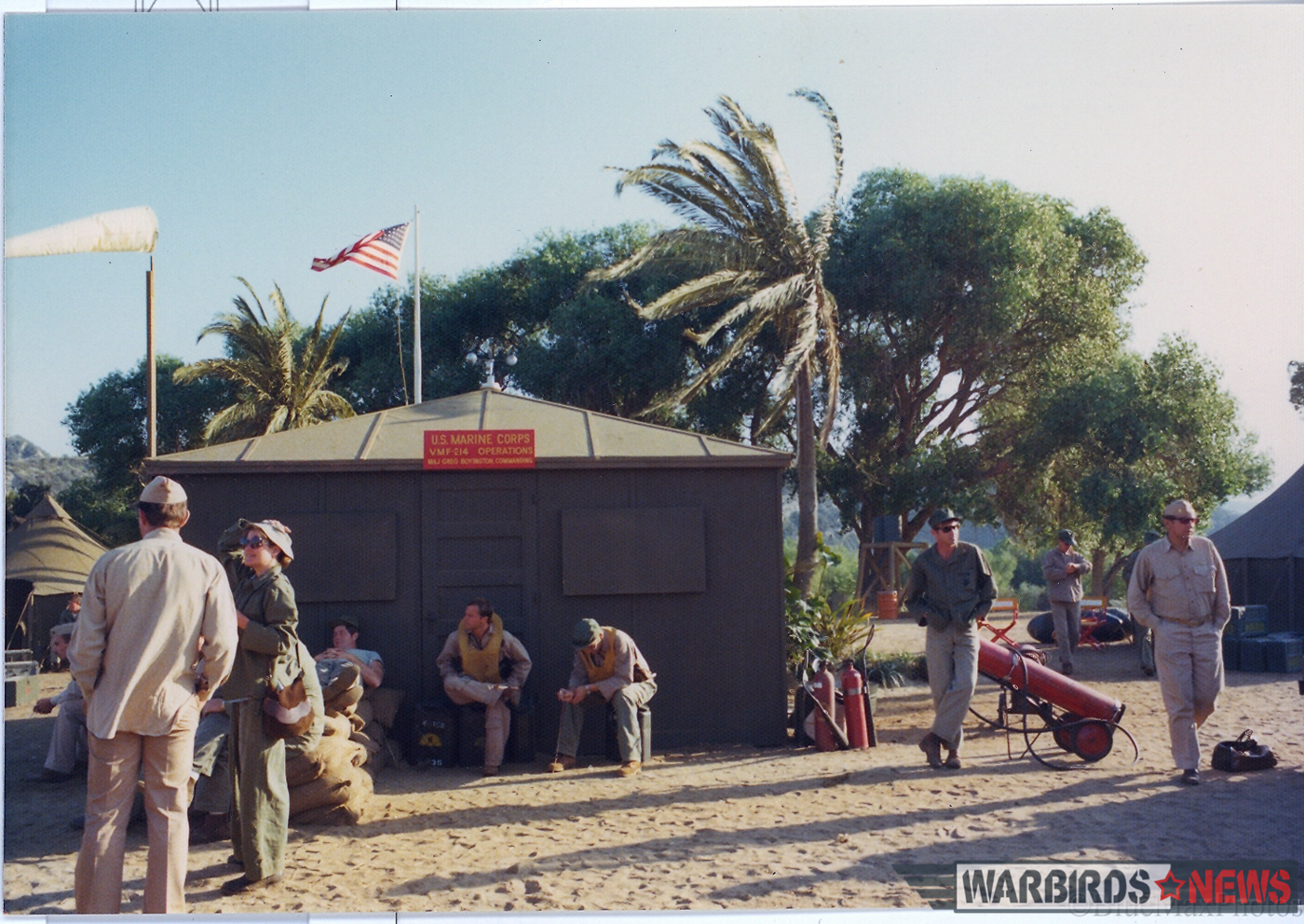
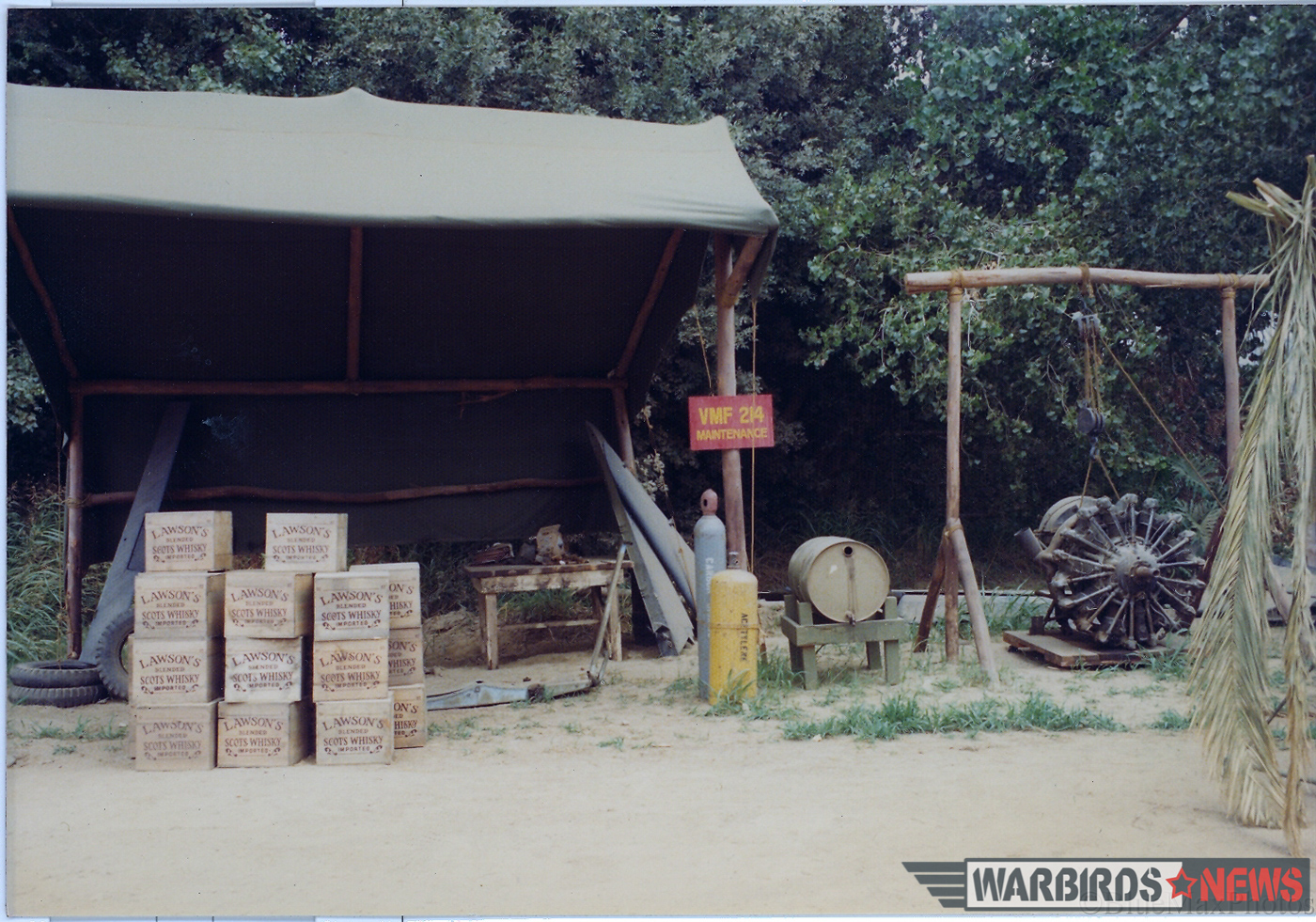
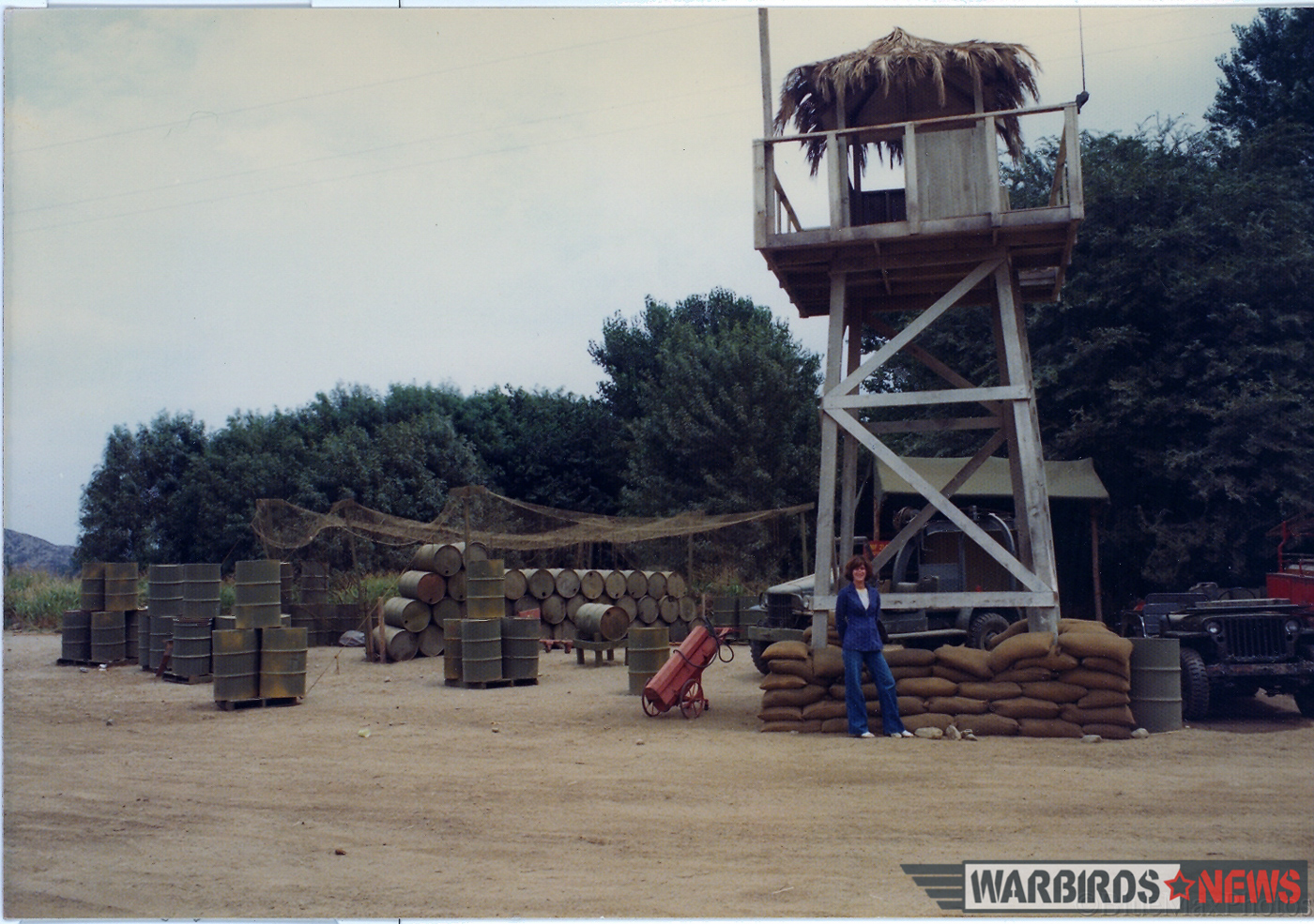
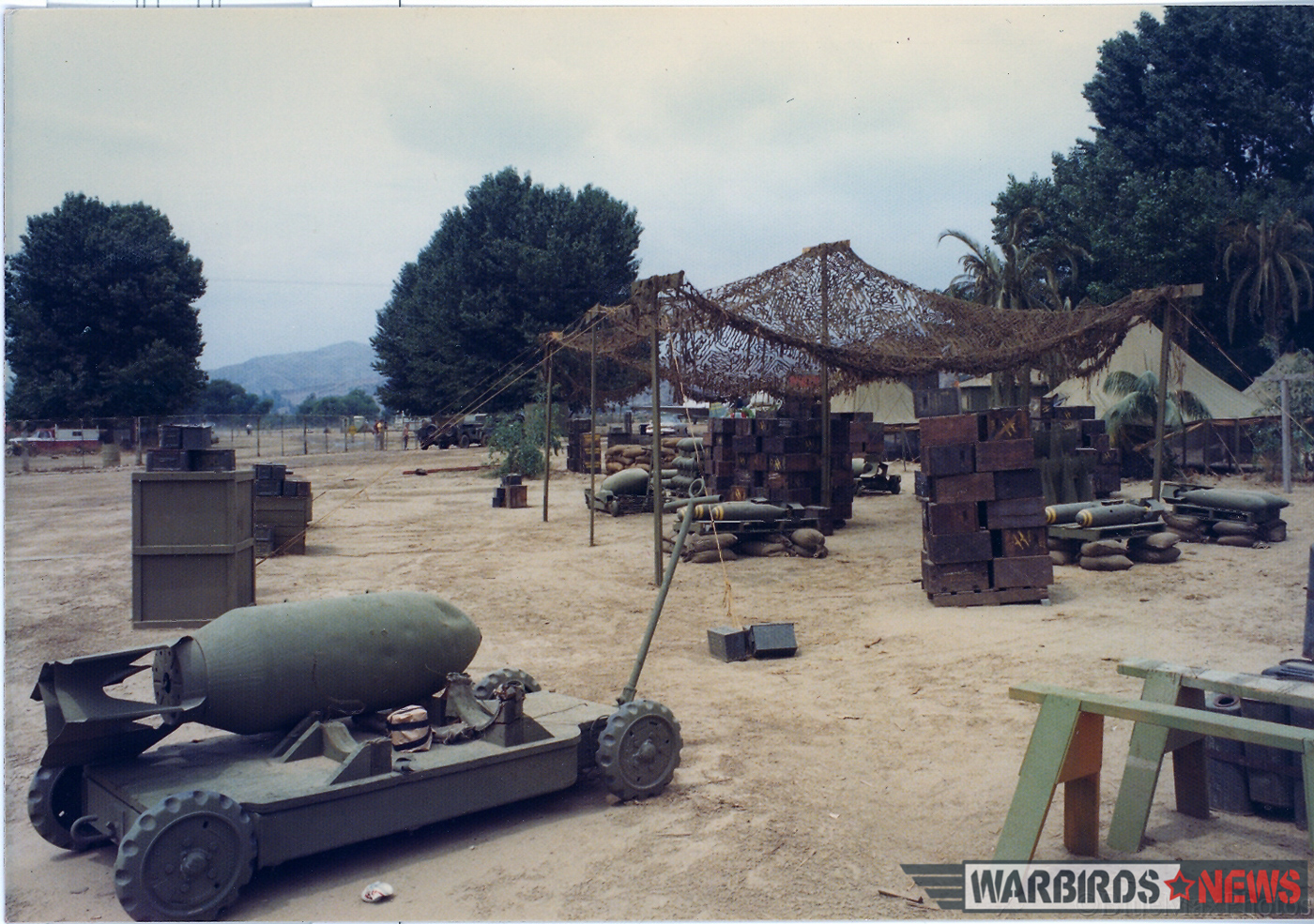
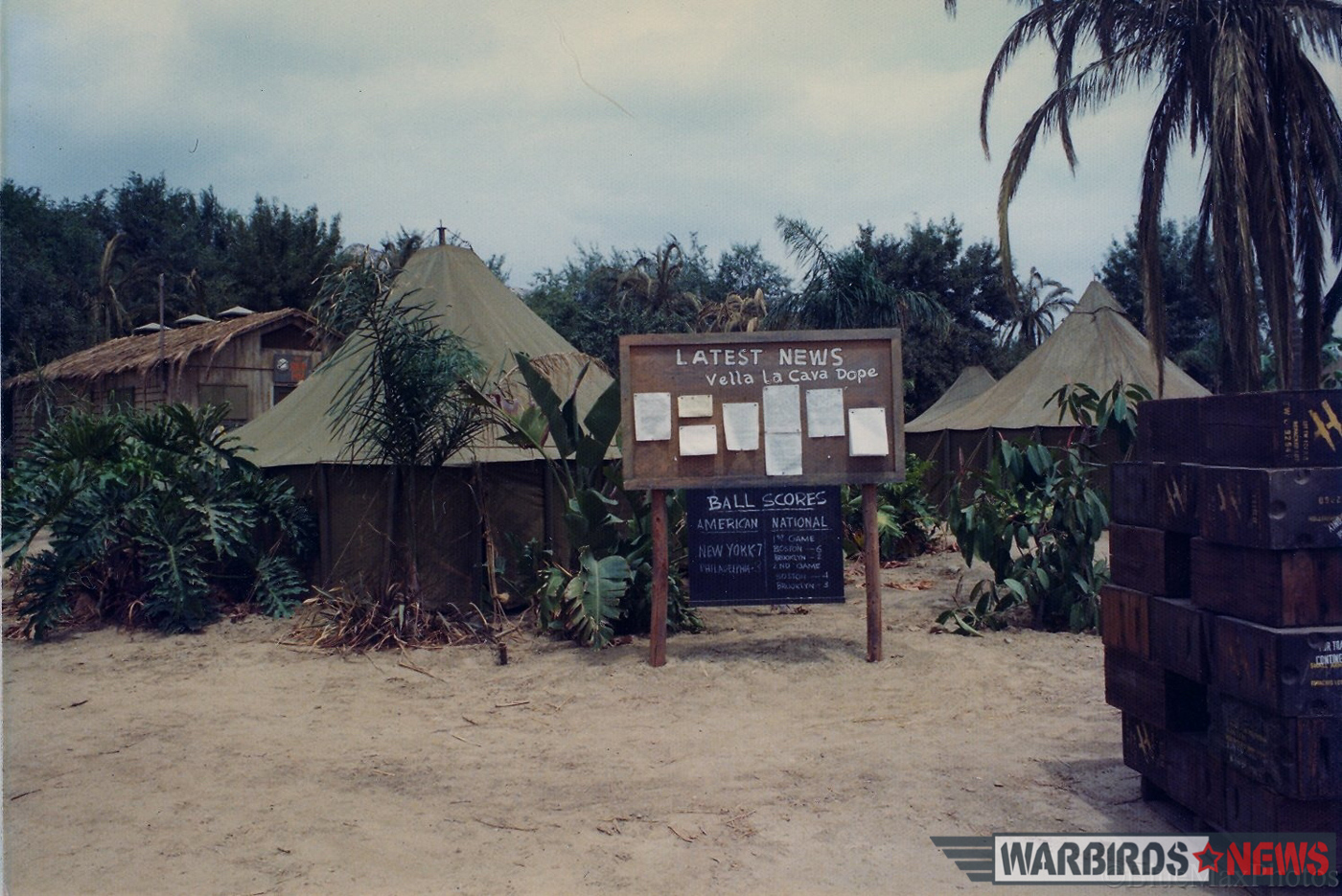
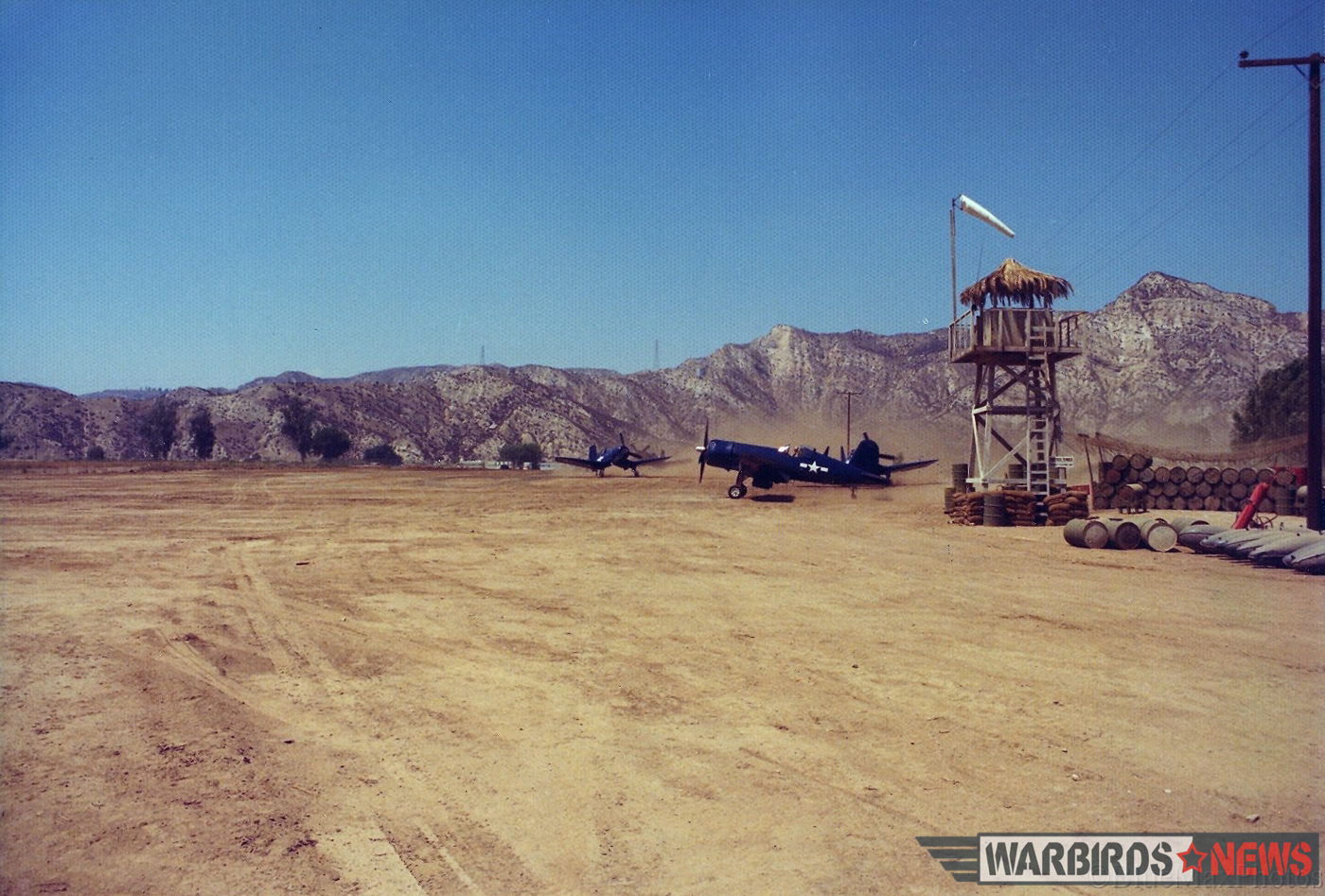
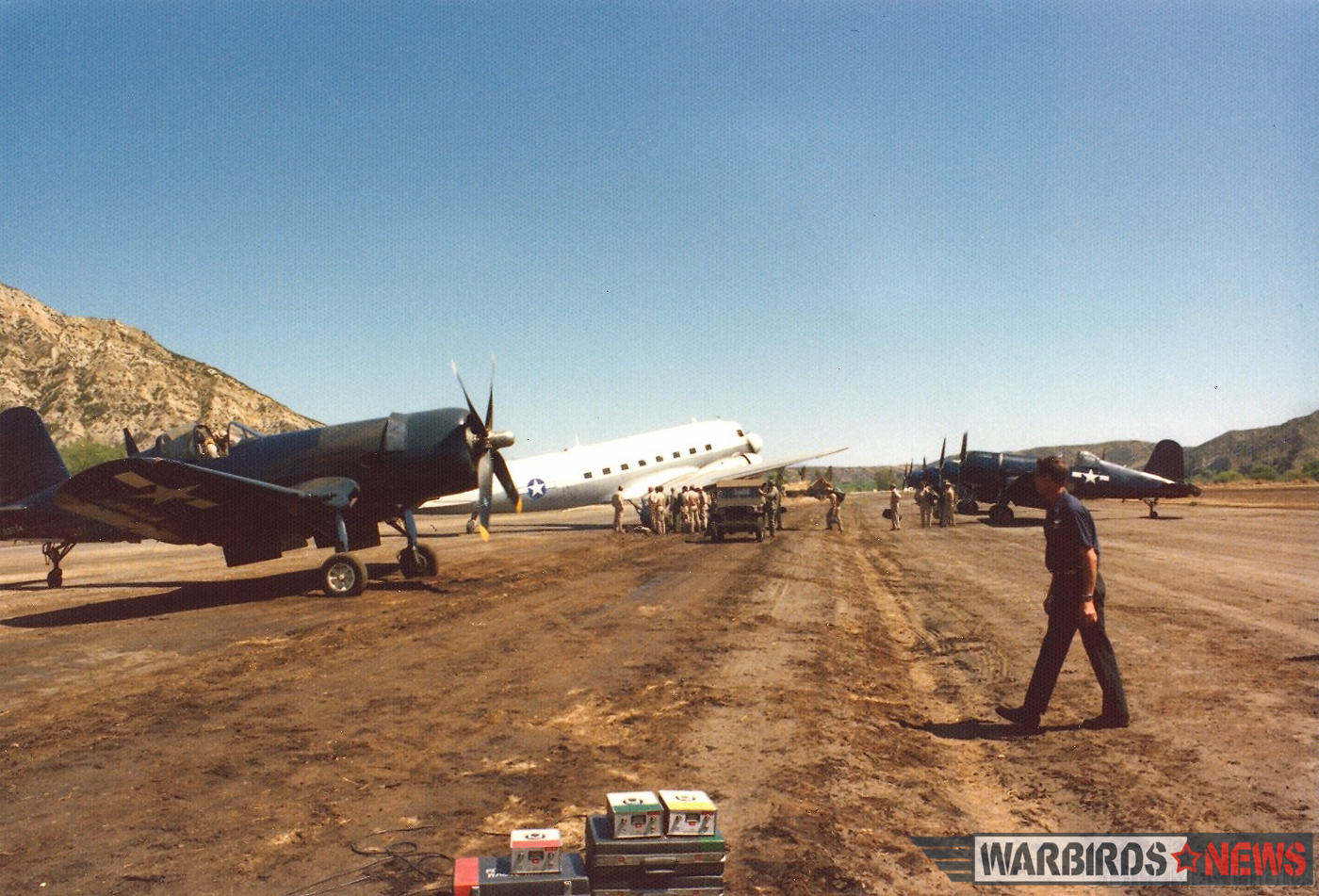
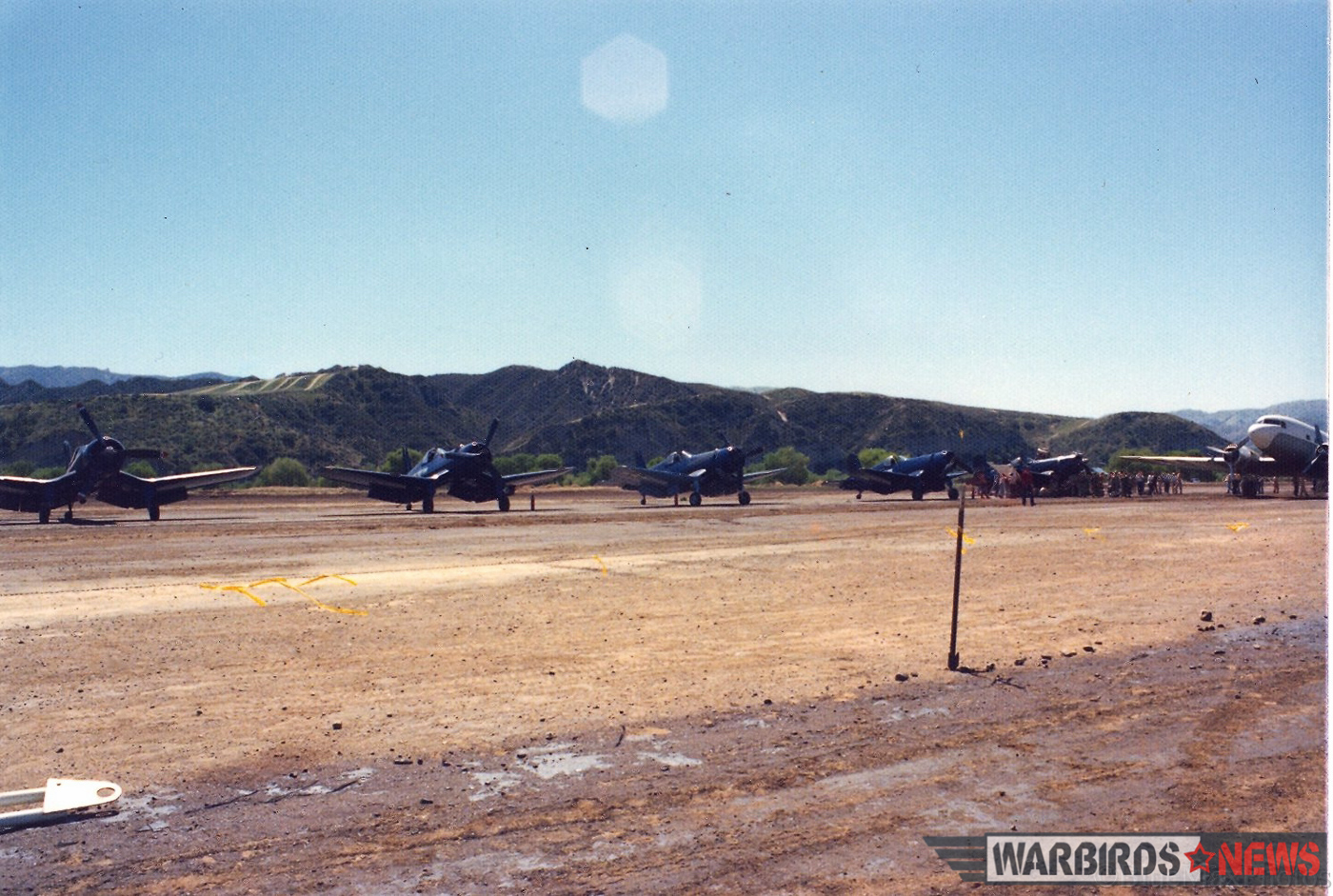
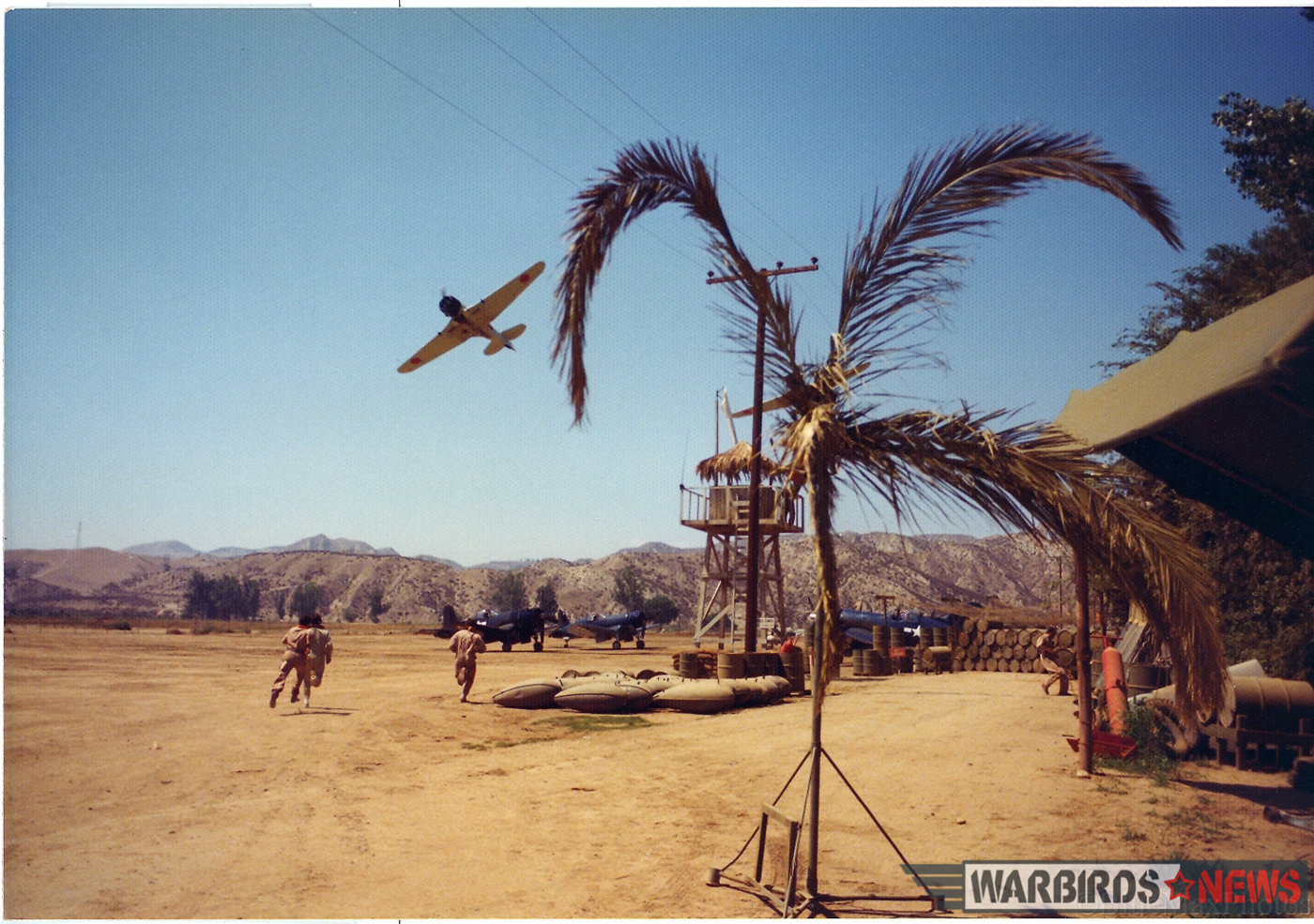
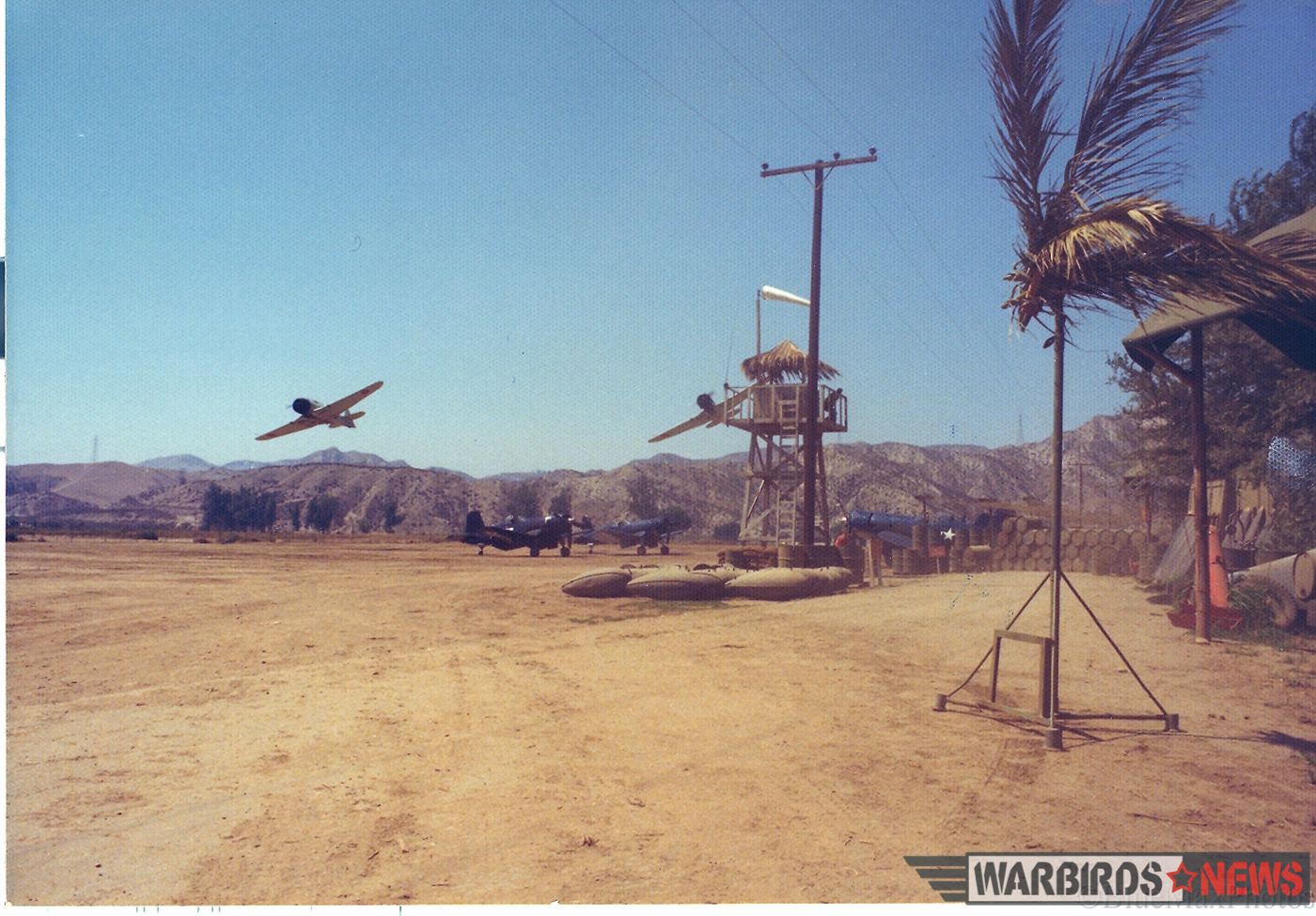
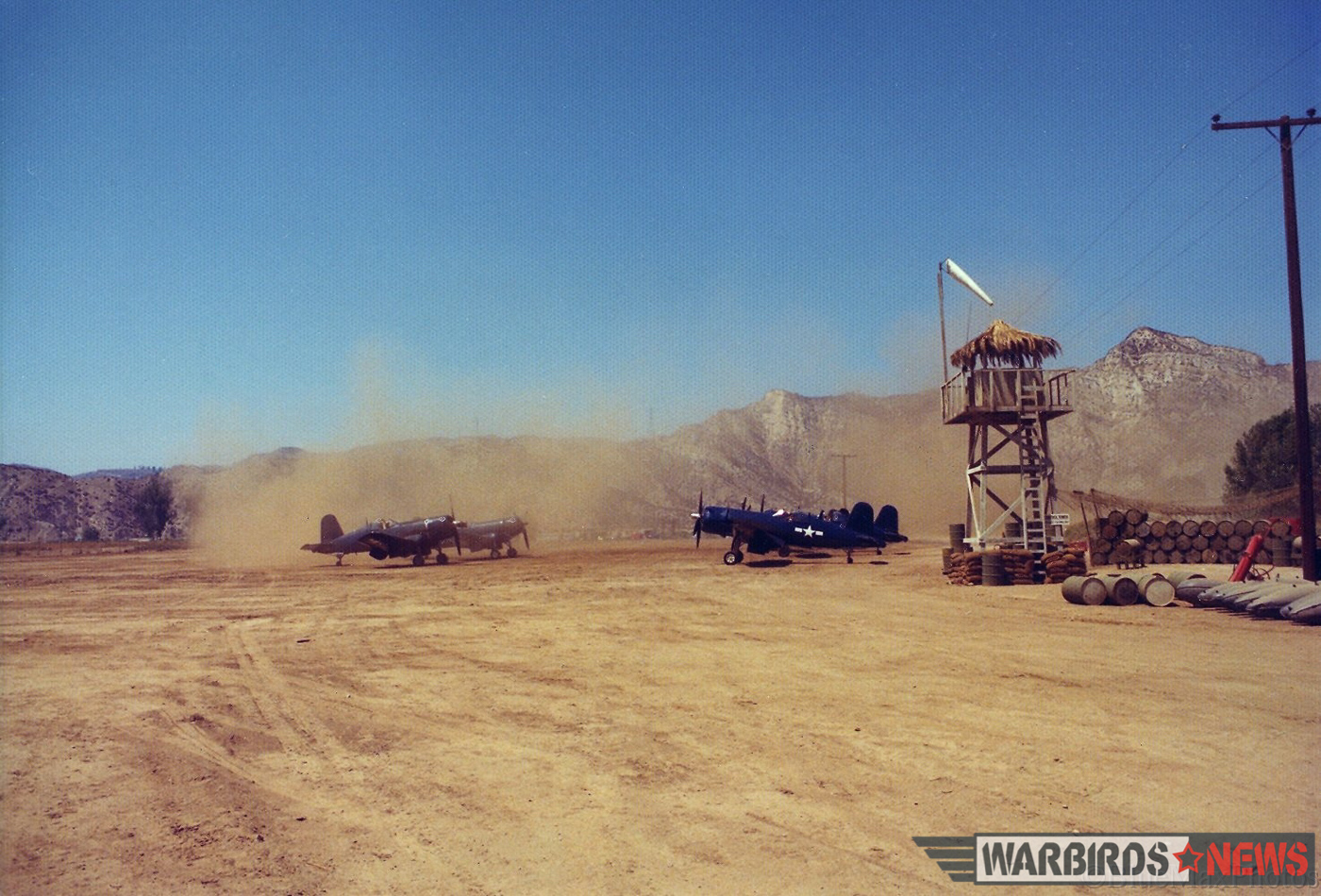
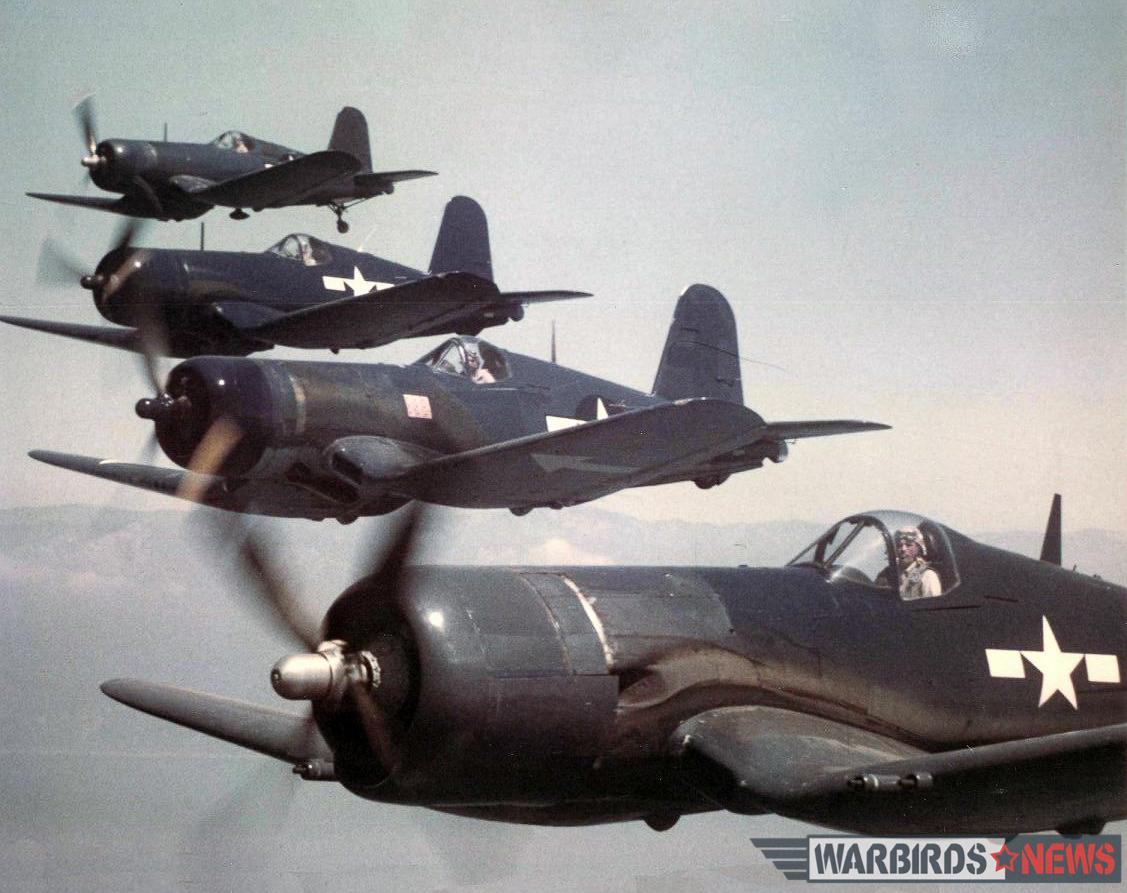
Stephen Chapis’ original article “Poor Little Lambs” that he originally wrote some years ago (Warbird Digest #49 – July/August 2013 – Click HERE to buy that issue)


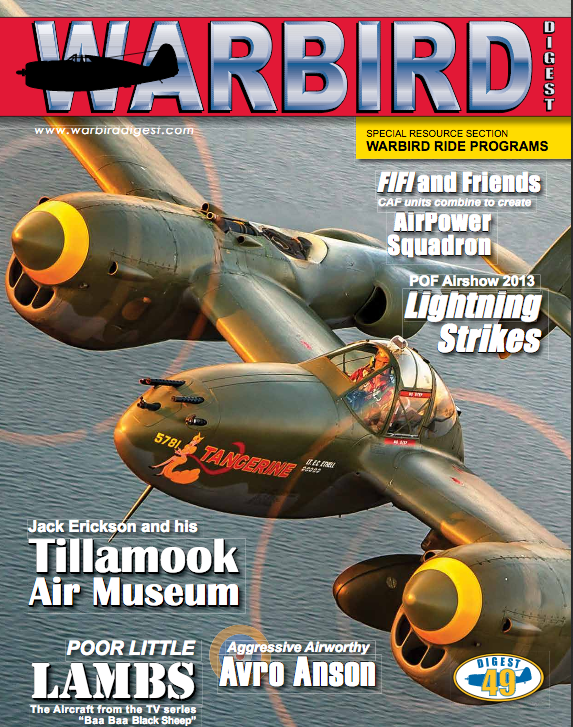

Such a great factual story that is enjoyable to read with interest. I used to watch this Blacksheep series. It’s a good to know the real historical data of these planes and the background of the pilots who actually did the flying. Thank you for sharing this good to know info.
Lest we forget.
Buno 97359 also had a special job in the Black Sheep fleet: it was fitted with a camera mount on the vertical tailplane for those “pilot’s eye view” shots. I bet you were wondering how they did that.
In one of the flight sequences on the show I noticed that Buno 92132 had a recessed area on the rear fuselage aft of the wing root. This is where the camera pod would have gone; it was a reconnaissance version. That’s probably the reason why the service records might have been hard to find.
How can I get in touch with Stephen Chapis please . Thank You
You can find him on the Warbird Information Exchange.
Hi Mint. I’m not on WIX anymore, but I finally caved and joined Facebook about two years ago.
I got my Muli-Engine Rating with Isaac Newton Burchinal Jr in Eloy, AZ in a Mitchell B-25 when he had the Flying Tigers museum there in 1979-81 .
Saw this plane there with his B17 Suzy Q, F9F Panther and several others.
I got a ride in the makeshift “trainer”.
Junior was a great guy who may have been short changed! He had quite a collection ofWWII aircraft as well as early jets of Korea era!
Terrific!
great article and fantastic pictures, very nice to see and read and it is a shame it is so difficult to find all of the famous and spectacular warbirds. Since I was a kid, now 76, I have been somewhat of a buff on flying. I do have over 9,000 hours logged, 8 years as a naval aviator.
Thanks,
Q. What was one of the many reasons Pappy Boyington was so successful as a Marine fighter squadron leader [and also one of the oldest]?
A. He was an experienced P-40 combat pilot in the ‘Flying Tigers’ under Claire Chennault ~1-year. Following link provides some insight into this phase of his turbulent career… http://www.warbirdforum.com/gregboy.htm
My Dad flew Corsairs as a flight instructor in Texas and Florida during WWII. Some very interesting stories he has. He’s 92 living in Hawaii now. Long history of flying. Might be worth interviewing.
Truly outstanding article !
Thanks for a great article-I fly much smaller, slower planes but am a huge fan of WWII warbirds!
Enjoyed reading this article. I watch every episode of Black Sheep Squadron on my first color tv.
I received my multi- engine rating instruction from Junior Burchinal. My dad, Skid Henley, knew Jr and arranged for me to fly down to Paris, TX from McAlester, OK for a day of flying Junior’s Cessna 310. So many cool airplanes on this strip. This was probably in 1968 or ’69.
Seems Jr talked about his B25 being used in the movie Catch 22.
Great Article
Nice birds,saw some Mustangs in Oaklands hangers getting annuals but no Corsairs.I was an AFSOC MC130 FE…nice birds..
Back in the early ’60s when I was learning to fly at Compton airport in SoCal, there was a corsair at the field that was said to belong to one of the Ames brothers (I believe he was the one with the big auto dealership in the area. It seemed to be simply abandoned to the elements. Always wondered what ever happened to that fine plane.
Dang, I was too young to fly in WWii but finally got my SELP license in ’66.
Highlight of my professional career was as Photographer/Cinematographer for NASA @ White SandsTF and NASA Langley and photographed the Shuttle R@D and to meet and photograph the first 6 Shuttle Astronauts. Photographed the Columbia at WSTF when it landed there. The loss of Challenger and Columbia was like loosing members of my family.
WLT 85 year young aviator.
I( was a tour guide at the Indiana Aviation Museum for about 8 years and gave many visitors a talk about the power, weight and huge prop on the Corsairs.
Terrific piece! Tremendous detail and great stories rolled together with a wealth of super pictures. I enjoyed it immensely. Seeing these wonderful old machines given new life in many interesting ways really speaks to the builder and craftsperson in me. Long live the restorers and those that give them space to work their magic – in the hangar and in the air.
Little boys weren’t the only ones to fall in love with the Corsair. It was my favorite show and it not only caused me to fall in love with Corsairs, but warbirds in general. My husband and I raised 3 sons who went to every Airshow within driving distance. My youngest is a marshaller in the CAF
Great Spread!
Is there any information on Bob Gilford’s Corsair the Blue Max which was stationed at Santa Monica airport in the 80s? I understand it crashed in San Diego with Marshal Moss at the controls. I’ve been trying to find out what happened.
A wonderful history of the Corsair…..thanks a lot
Don Bennett
This is some fantastic reading. I loved watching these shows on TV. Thanks for putting it out for us to see and read about.
25 years after the war, I was stationed in Palau in the Coast Guard. Palau saw a lot of naval action, and was bombarded for a week by ships and planes from a carrier flotilla.
Anyway, I have pictures of a Corsair that crash landed on Angaur Island, and to testify to how good the paint on these planes was, the star and bar was still visible after all those years in the jungle.
GREAT filming & story of the Corsair. My first job after WWII and college was with Goodyear Aerospace in Akron and there were a couple of people who talked about the Goodyear Corsair with the bigger engine. Some even talked about the Air Show up in Cleveland and the Corsair that flew there?????? I as an Aero Engineer worked on Navy Airships and did alot of Wind Tunnel testing and was the Goodyear REpr at Full Scale Tunnel down at Langley field .We tested 1/15 & 1/20 scale models of 5k & zpg Airships as well as the Inflatoplane . A nice career!!!!!
Enjoyed the article very much as it brought back some fond memories. I had the honor of meeting Pappy Boyington in Harlingen,TX back in 1979 at a CFA gathering. At the time I was flying for Gerald Martin in Hereford, TX. It is my understanding that Gerald Martin was one of the pilots that flew many of the scenes for Baa Baa Black Sheep? I did see a Dick Martin mentioned in the article. Could you mean Gerald Martin? He and Junior Burchinal were good friends and made some of the landing and take off scenes from the movie set. Gerald Martin passed away in October of 2010 at the age of 74. He was an amazing pilot and he taught me how to survive as a crop duster pilot. I got to set in the cockpit of the F4U he flew back to Hereford after completing the flying scenes for the series. The one with the white arrow painted on the right wing. I think that F4U belonged to the CAF wing in San Marcos, TX. Please let me know about Gerald Martin.
I would like to correct a couple of errors to my previous post.
I realize now that the Corsair Gerald Martin flew into Hereford, TX was an FG-1D Bu. 92629, not a F4U. He was returning the plane to John Stokes in San Marcos, TX. I had the thrill of sitting in the cockpit and looking it over. If you remember the opening formation scene of the series, the first Corsair with the white arrow on the right wing banks to the left. You can clearly see the late Gerald Martin in the cockpit. I’m sorry that he was not mentioned in this fine article. The service record of 629 is remarkable and happy to learn it is on display and still airworthy.
Also, meant to say CAF where I shook Pappy’s hand in 1979.
Back in the early ’80’s, I called Junior Burchinal to set up a time to fly with him in his dual seat Corsair. We also talked about Gerald Martin and their friendship. When I arrived at Flying Tiger Field in Paris, TX the following Saturday, I was told by the overseer that Junior was gone and would not be around for a while… Never got to fly my favorite war bird or meet Junior in person. Baa, Baa, Baaaaaa!
Did anyone ever tell you why Junior was going to be gone for a while? I’m guessing this was around the time he was arrested for drug smuggling conspiracy charges.
Yes, thank you, I know the whole story and issues,
I’m still wondering that Gerald Martin’s part in the making of the series isn’t mentioned at all.
Junior was a great guy who had an array of WWII aircraft! Nothing for him to take you up in one and never paid a nickel. I really missed out by never going through his school.
Great article!
I enjoy your articles as I have been around Howard Pardue’s warbirds since the late 70’s. Keep up the good work!
Always enjoy reading on old aircraft
Thank you
beautiful (jfb) i really enjoyed this and all the movies.!!!
Great story, my favorite show, never missed an episode!
25 YEAR P 51 AIR SHOW PILOT N6327
Aloha:
While I’ve never flown IN a Corsair, I did ride back seat in a P-51 Mustang in formation with one! We buzzed Houston before an airshow there. Memorable!
But my main reason for writing is this: I believe the DC-7B 8210H in the background shot of Corsair 92433 MAY be the one that crashed in Pacoima, CA in the late ’50’s after a mid-air with an F-89 Scorpion. All 4 in the DC-7B were killed, and one of the F-89 pilots died as well. No one on the ground were injured, although the schoolyard had just been emptied at the end of recess! You need to check the numbers to be sure, since it’s been a LONG time!
I was a Flight Test Engineer at Douglas Aircraft, Santa Monica, at the time..
Bud Weisbrod
Hello, editing department?
“It is simply a history of the Corsairs used on the show and a collection of memories from the four surviving Baa Baa Black Sheep pilots: Thomas Friedkin, Steve Hinton, Steve Rosenberg, and the late-Bill Yoak.”
The four surviving pilots and “the late Bill Yoak”? After the crash, where did they bury the other survivors?
LOL. Good catch. I’d love to write the writer as well and point out the show didn’t just inspire “Boys” to want to fly. I’m a woman and I fly partially because of this show. Girls fly too and Girls were inspired by this show too!
The four surviving pilots as of 2013…..
I really enjoyed reading this, it’s now 4:15 AM and still wide awake. I am also 83, served in the Air Force in Korea, 2nd Combat Photo Sqdn. I grew up in East Oakland under the flight path to Oakland, always watching the aircraft on their approach during WWII.
In 1947, my father was transferred to the new Chevrolet assembly plant in Panaroma City from Oakland next to Van Nuys, another airport with all types of aircraft and mentioned in your F4 article. I used to take my 36 Chevy over there just to see the planes.
After college, I spent about 35 years in the high speed photographic instrumentation cinematography field. This field of work would eventually put me into certifying pilots attempting to set new low altitude speed records, wth the first being Darryl Greenameyers F-104 record at Mud lake Tonopah, NV in 1974. I was working in the Records Boards Section for the NAA. This then led me to many other record attempts including Steve Hinton’s records as well as many others.
This is reather a long read in which takes me to the subject, Baa Baa Black Sheep. My father became friends with Pappy Boyington when living and working in Van Nuys. I actually have a copy of Pappy’s book about the Black Sheep signed to my father. It’s also a read of how I got to meet so many of the wonderful people in the War Bird aviation field, a place where my heart has always been and why I inlisted in the AF.
I now live in Apple Valley, CA where there will be an air show this October and Steves Planes of Fame will appear. I hope to see him there again and get the goose bumps watching the ” War Birds” doing their thing.
Thanks for the great article and braking the cobwebs loose.
Great article,great pictures. The 1st.Corsair I ever saw was Alberta Blue that Blain Fowler flew to a fly in breakfast at Taber Alberta along with an ex Bolivian Airforce P-51.
WE ARE IN THE WESTERN WORLD ARE FREE IN LARGE PART BECAUSE OF THE VETERNS THAT FLEW THESE GREATBIRDS GOD BLESS ALL !
I am from the UK and only got to see a few of the shows but loved seeing the corsairs flying and have been to oshkosh 5 times now over the years to see and get up close to them .thanks for the article nice to see the history of the planes I seen flying on tv
I remember the B-25 and the two P-38’s appearance episodes. Heady times for aviators who wanted “real” aviation shows. I also remember that the 70’s were FILLED with impromptu air shows in Florida. I was a very fortunate young man to see these ‘birds up close and personal. Wonderful memories. THANKS!
My husband’s late father, Dean Ortner, is mentioned in this article. If anyone knows where his Corsair is now, we would love to know. In 2012 we purchased Dean and Andy Ortner’s airport back and named in Ortner Airport once again. Any information you can pass along would be appreciated. Thank you!
Courtney Ortner
Hi Courtney. I have some information on your late father-in-law’s Corsair. Do you have a number you can be reached at the airport?
Great article about an iconic airplane!! I record every episode of Black Sheep Squadron on the H&I cable channel and it’s great to know more about the Corsairs that were used in the shows.
Pilot
Was lucky enough to meet Tom Friedkin in the early 80’s at his Cinama Air hangar in Carlsbad,Ca.Through a friend of his.Tom was just landing his T6 when I arrived and he was gracious enough to let me tour his hangars.A very high point in my life,as I was a Vietnam era Huey pilot and maintenance officer.I was an aircraft mechanic in the 12th Aviation Co,Ft Wainwright,Fairbanks, Alaska.Dehavlin Otters&Beavers.learned to fly tail draggers in our flying club and then to flight school & 2 tours in Vietnam.
Thanks for the Memory
What a great history lesson! I still have a set videos from “Ba Ba Black Sheep” and watch them regularly. Now I can identify the different aircraft!
As a retired pilot (F-84F, F-104G, F-16A and Mirage 5B) I am very interrested and would much appreciete to receive your newsletter.
As a retired pilot I would much appreciate to receive your newsletter. Tks.
Outstanding publication , never missed a show,
Worked at Chance Vought & 1 Corsair was kept there at the Exp. hanger for Paul Thayer (Marine Pilot) & CEO to fly on weekends & pop a few rivets, along with stressing the engine a little. It was always kept in pristine flying condition(Beautiful)
We were producing another great Chance Vought plane at that time, the F8U Crusader 1954 thru 1962,
Great and very informative. Thank you.
My Dad, Maj. E.D. Bush, USMC (ret.) flew TBM’s in the South Pacific during WWII before flying Corsairs in Korea. He was Carrier Qualified with 32 traps and said while the cat shots were exhilarating, carrier landings soaked his flight suit with sweat. Dad led the 2nd combat mission to fly over and bomb the capital of North Korea, Pyongyang.
Sadly my Dad passed in 2015 at 93 y/o however I have 2 pictures that remind me of him. One is flying #17 with VMF 212 while he was in Korea,
the caption on the back of the picture says “Loaded for Bear” and boy oh boy was his Corsair loaded with ordnance.
The other picture is a squadron picture of the pilots on the deck of the Midway kneeling in front of a Corsair on a “show the flag” cruise of the Mediterranean ocean just prior to the Korean conflict.
I also have his log books with his solo being made in a N2S-3, Stearman and his final flight 21 years later in a C45J, twin engine Beech. Dad had a great flying career with the Marines that earned him a DFC and an Air Medal. A career that started with bi-planes and ended with jets, not to mention 2 major wars.
He was my hero and I miss him but I’ve got his log books and a few pictures to pass to remember him by. Thanks for listening, Art
Art
Mr. Bush,
Hello, my name is John Lang, my father I think knew your father? I can’t recall exactly when, but your dads name seems very familiar to me.
My father is Major General Frank C Lang USMC (Ret).
Dad spent 36 years in the Corps as an aviator. Enlisted in 1942 and retired July 1978.
He was deployed to the pacific theater in 1943 with VMF (N) -532 flying Corsairs in the Solomon Islands. Dad also flew in Korea flying Corsairs and F7F Tigercats.
Dad had a long career, plus 30 years of retirement with my mom in San Diego. She still lives there.
Sadly though we lost dad to gall bladder cancer in Dec.2008.
Dad always said his greatest love besides my mom was the Corsair!
If my dads name rings a bell at all please contact me. If not god bless and Semper Fi.
Thanks so much for that. I am a long time friend of POF and am honored to know Steve Hinton and have great respect for the Maloney Family. Ed will be missed. I enjoyed Baa Baa Black Sheep and never missed an episode. The research and writing in this article is excellent. Thanks again.
that was one great plane, saw saw several of them make bad landings on the PRINCENTON, and valley forge.
“The short-lived TV-series Baa Baa Black Sheep turned many young American boys into life-long fans of the famed Corsair, ” Could you kindly re-phrase this. Many young American GIRLS were also turned into fans of the Corsair. I’m one of them and when I met James Whitmore, Jr (Gutterman) I told him I became a pilot because of that show. He was so impressed he started walking around the USS Missouri telling people he just met a lady pilot and that he was one of the ones who inspired her to fly. I loved that show, still do and mostly because of the Corsair. It’s not just boys who love flying and love airplanes and love the Corsair!
Hi Krista. I’m not done writing about the Black Sheep, in future publications I’ll be sure to mention girls. 😉
Frank Tallman is a distant cousin of mine, and this program I watched as a kid. It was only later someone asked ‘Any relative’ and I was to discover the connection. Unfortunately, Frank was to pass doing what he loved, crashing a plane into Santiago Peak in the Santa Ana Mountains in 1978.
He had an amazing life and career, bringing these amazing planes to the screen for all. To learn more about him see https://en.wikipedia.org/wiki/Frank_Tallman
Great article!!! How about a follow up article on the other planes used in the series? I remember a Duck, a SNJ, of course the R4D, B-25s and P-38s, and there may have been others.
If I can find the serial numbers of those aircraft I’ll surely research the whereabouts of those aircraft too.
This is a wonderfull e mail of Corsair history and I really enjoyed every bit of it ! Thanks to all that were part of it ——Howard Briggs Cle Elum , Wa. 98922
Having an aviation career spanning over forty years, I love this article and the photos. Before becoming a pilot for Eastern Airlines, I flew the cabin Waco EGC6 and the T-6 along with so many others. The Corsair has always been a favorite along with the P-51. I am 82 now and my flying has become many fond memories.
I still fly on my computer with FSX and have all the old airplanes in my FSX hangar including the Corsair, P-51 and my old Boeing 727. I try to fly every day and love them all.
My father was Phil Sibille. He trained me on the 727 sim for my instrument and multi ride with Larry DeAngelo. I was wondering if you knew either of them
My Dad Captain Edward Mc Aleer was a Corsair pilot with VMF441 & his flight log documents that he flew several strikes in Bu# 17799 in June 1944 from Roi. I have provided copies & photos to Cory at Planes of Fame
At one of the Chino (So. Cal) air shows, I met and had Boyington sign the book he was selling. We talked for a coupla minutes. I felt kinda sorry for the other pilots there doing the same thing. A long line to get Boyington’s book, few people in line for many of the other WWII pilots there. I stopped by to get a coupla other guys books.
Also have pictures of his grave stone at Arlington a few years back.
Mike
I live near the Tri State Warbird Museum and can’t wait until they have 92132 restored.
It flew two days ago.
I enjoyed this article on the Corsairs of the TV Show, Blacksheep Squadron, very much. I spent 26 years in the Navy and as a boy I grew up in the vicinity of old NAS Atlanta in Chamblee, GA, where I could see Corsairs and PBYs fly over my house daily. I am neither a pilot, nor an aircraft owner nor did I know any of the celebrates involved with the production of this show, but I would like to make one correction.
The caption for Bu.97359 which states that the aircraft carries the markings of LT. Thomas Hudner’s is incorrect. LT. Thomas Hudner was a U.S. Navy officer assigned to Fighter Squadron Thirty-Two (VF 32) on board the carrier CV-32 USS Leyte. LT. Hudner was not a Marine, he was not in the squadron VMFT-20 and the modex for the Leyte’s aircraft was “K” not “LF”. These markings for ‘359’ are completely wrong for LT. Hudner, Korean War Hero and a Medal of Honor recipient. This is a minor thing but as a naval aircrewman I feel the record should be correct. Keep ‘em flying.
Thanks so much for the corrections Will… we made the adjustments as soon as we saw your post. Thanks as ever for your support!
Would love to know which episode of Black Sheep featured the Corsairs flying formation with Frank Tallman’s Duck!
A great article and historical report on a great series, a historic aircraft, and the awesome and very lucky guys who got to pilot them… It is with great sadness that I have only now confirmed the loss of Bu.133693 “Blue Max” and the lives of the pilot and passenger in 1987!! I spent much time admiring that airframe while it was in Santa Monica at an FBO is used to fly out of. Simply beautiful!! Again, really well done story!!
Good to see your doing well Bill!!
At the very top photo to the far right is the late I. N. Burchinal who supplied one Corsair and flew it in the making of Baa Baa Black Sheep. Seldom mentioned in comparison to the west coast gentlemen!
You are so right about the slight of Junioe Burchinal’s part in the filming of the series. Also mentioned second from the left is Gerald Martin, later referred to as Dick” Martin by mistake. These two pilots made the takeoff & landing scenes for the series. Steve Hinton may have flown Bu. 29629 from San Marcos, TX to California, but Gerald Martin was the pilot that flew it in those scenes and then returned it to San Marcos via Hereford, TX where I was able to sit in the cockpit while it was tied down there. I flew as an Ag Pilot for Gerald Martin, owner of Hereford Ag Flying service, in 1976-1978. I was to fly with Birchinal in his jump seat Corsair, but the Saturday I arrived at “Flying Tigers Museam” in Paris, Tx, Jr. Burchinal was detained. So close, but no cigar. These two pilots should have had much more credit in the article.
Is there a place where one can find inoperable Corsairs for sale?
I’m 68 and remember watching P-80 ” shooting stars” fly over Long Island NY on their way to and fro Mitchell AFB. That started my life long interest in military aviation. I read Pappy’s book in elementary school and met him at a California airshow where I bought his book autographed for me! My dad also served in the South Pacific in the army as a combat medic. He was a big history buff but never spoke of his experiences. We all owe a debt to those brave men. Never Forget!
RE: Here’s To The Memorie’s&MOVIE Cast Of: BAA BAA BlaCK SheeP Squadron!! Movie Based on WW11 Squadron Leader Major Gregory “PaPPy-BoyingToN” LeaDing A Marine CoRsaiR WarBirD’s Fighting Squadron! Depicted as MiSFit’s! UnTiL PaPPY! Lead’s&Form’s HerOic FLYing Marine Squadron To History&LeGENDARY Marine WW11 HISTORY!! In Memory of Actor JEFF MCKAY Playing “Leiutenant FRENCH” Whom I Met in Person RE:1983 Terry BradShaw Event!! Here’s To The Memorie’s Of PARTY! &InVite! ThanK’s MR. McKay&FamilY&Friend’s Your Fan &Friend of Black SheeP Squadron!!
Did you have a major Caps Lock failure on this mission?
I Really enjoyed this Article, on the History of the Corsairs, the Pilots who flew them and the History of my favorite series Baa Baa Black Sheep. I have never Been A Pilot, however I am a huge fan of vintage World War II Aircraft, Corsairs always one of my favorite Aircraft. I am an Army Veteran, Thanks so much for this Wonderful Article🌟🌟🌟
Many thanks for writing in Raylin… we really appreciate feedback such as this, as will the article’s author. I must say that the Corsair is my favorite too! Cheers, Richard
Great article about the real stars of the show and the real pilots who flew them! IMHO, the Corsair is the sexiest aircraft ever made!
Question: The F4U-4 Corsair in baa baa black sheep was 97353 not 97359? Why is that? I sat on this Corsair in 1979 at Palomar Airport in SD. I have many pics of 97353… Even in your baa baa black sheep pics, it’s shown as 97353?
When Tom Friedkin acquired the F4U-4 he tried to get a numbers close to the BuNo 97359. N97353 was a close as he could get. John Schafhausen did the same with his F4U-7 BuNo 133710. The N-number N33710 was not available, so he went with N33714. This led to decades of confusion where people thought his aircraft was BuNo 133714.